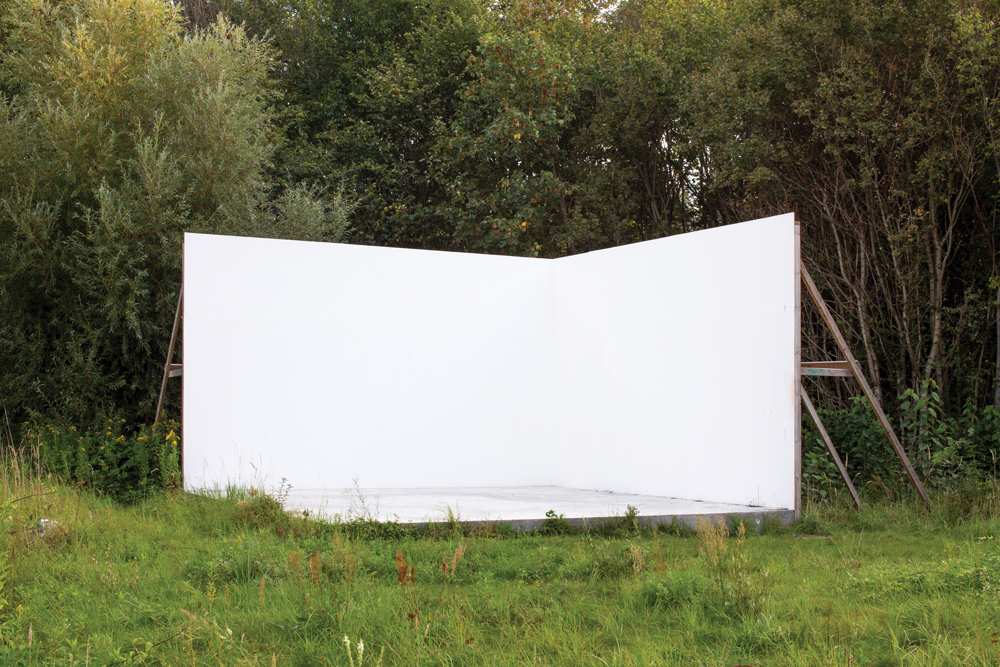



WIND, 2024
11.10.24 - 02.11.24
inter.pblc, Hamletsgade 6, 2200 Copenhagen, DK
WIND is a remake of Kåre Frang’s 2016 video Air (VW Golf III), which featured a car being dropped repeatedly from a crane in a junkyard. The video was edited so that the lifting and dropping of the car was omitted—we only see the car hitting the ground over and over again, slowly breaking apart until it’s just a pile of metal, glass, and plastic. It looks like the car is bouncing itself to pieces.
While that work was set in a junkyard—a cemetery for cars—WIND takes place on a public street in Copenhagen. Once again, the film consists of repetitive shots of the vehicle hitting the pavement and breaking apart in luscious slow motion. Even though the action is violent, the slow motion makes the car’s movements appear strangely gentle, almost like the rhythm of breathing. Bits of the metal fly through the air and roll down the street with an eerie calm and languor.
Pedestrians pass by while this is happening, seemingly oblivious or uninterested. The everyday life of the street continues, as if the car’s destruction were unremarkable. The Foley soundscape highlights the uncanny discrepancy between the ordinary real-time motion of the pedestrians and the dramatic slow motion of the car. Frang’s aim is to “place the viewer between two different experiences of time.”
A car is a private space that barrels through public space. It is an insular world in which people have intimate thoughts and conversations while they move between neighborhoods, cities, and landscapes. But cars do not only cut across public space, they also determine the form and use of public space. Cities and towns are organized around cars, and, on a larger scale, the earth’s climate is being altered by cars. In this way, the car is a symbol of human domination of the planet and the various crises that result from that domination.
Many of Frang’s works address crises that are not easy to apprehend. “Creeping crisis” is a concept used across academic disciplines to describe an emergency that occurs so gradually that it may not be perceived by the people whose lives it threatens to disrupt. For example, wind currents are not something that humans see, control, or even fully predict, but which are affected by human behavior. As extreme weather becomes more common, it is certain that the wind will occasionally destroy human infrastructure much as Frang has destroyed this car: it will lift things off the ground and drop them crashing down again.
Crises are not only invisible, of course. They can also become heavily mediatized and hyper-visible, though that visibility does not always contribute to a solution or even to action. A keen awareness of crisis can also lead to a sort of hypnotized spectatorship—which is not unrelated to the experience of watching WIND. It is hard to look away from the video. After all, it can be fascinating and pleasurable to watch something get destroyed—one sees the limits of an object’s coherency, what it becomes when it is broken apart and transformed.
That said, WIND does not seek to command the viewer. Frang’s approach to video is sculptural—one can look for a few moments or linger for longer. Like a sculpture, the more attention one gives, the more detail is revealed. But unlike a sculpture, WIND is also narrative, it moves steadily and repetitively toward an inevitable conclusion, the complete destruction of the car. As hinted at by the title, there is something elemental in this inevitability. As Frang says, WIND activates a similar impulse as looking into a fire—watching the video is like “looking at a campfire and waiting for it to slowly die out.”
The exhibition is supported by
Ny Carlsbergfondet, Statens Kunstfond and Rådet for visuel kunst.
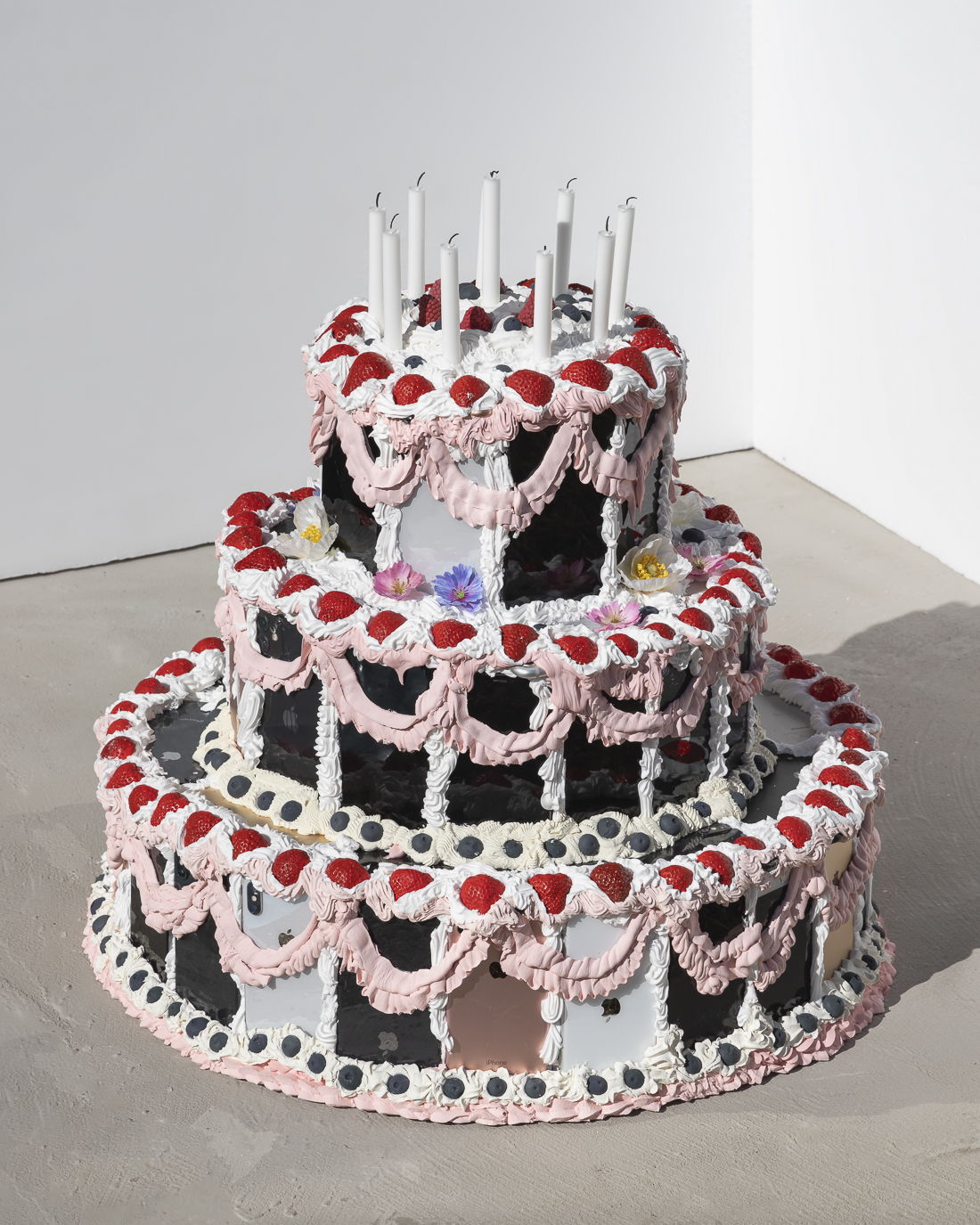
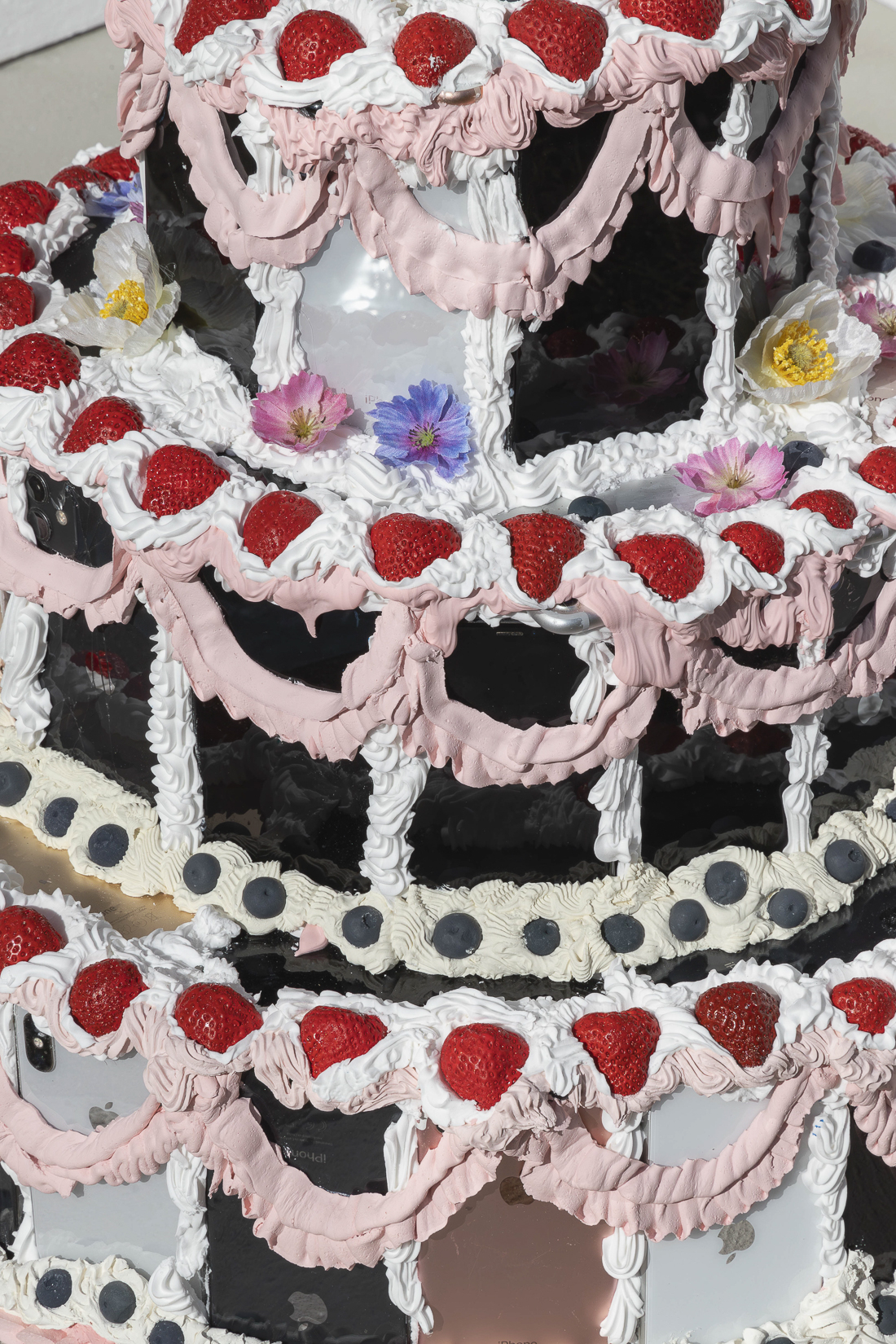
Attention Crisis, 2024
iPhones, fake whipped cream and buttercream, candlelights, handpainted replicas of strawberries, raspberries, and blueberries
60 x 55 x 55 cm
EYES HOLDING HANDS
solo exhibition at Lagune Ouest
09.08. - 07.09.2024
Flea market in Venice, 2024
Pigment ink in polymer modified plaster, UV protective acrylic sealer, artist frame made from elm
37,3 x 49,3 cm
Full documentation available here:
https://www.contemporaryartlibrary.org/project/kare-frang-at-lagune-ouest-copenhagen-37289
https://www.laguneouest.com/eyesholdinghands/
EYES HOLDING HANDS
Solo exhibition at Lagune Ouest
09.08. - 07.09.2024
- Excerpt from text by Post Brothers
Read the full text here
Full documentation available here:
https://www.contemporaryartlibrary.org/project/kare-frang-at-lagune-ouest-copenhagen-37289
https://www.laguneouest.com/eyesholdinghands/
Portraits of Overwhelm, Heartland Festival
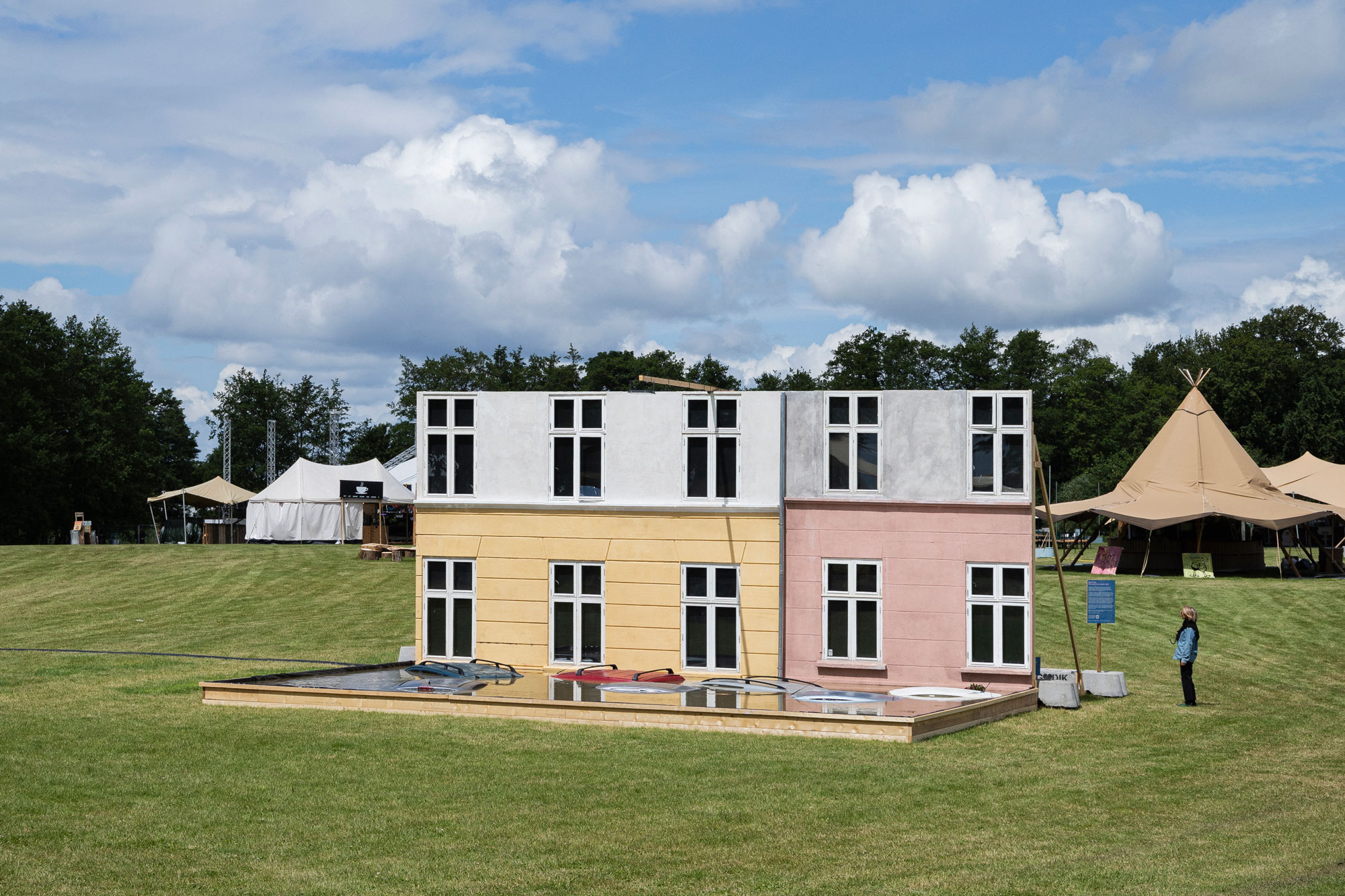
Portraits of Overwhelm, 2024
Car roofs, set design facades, pool with muddy water and garbage
4,8 x 12 x 12 m
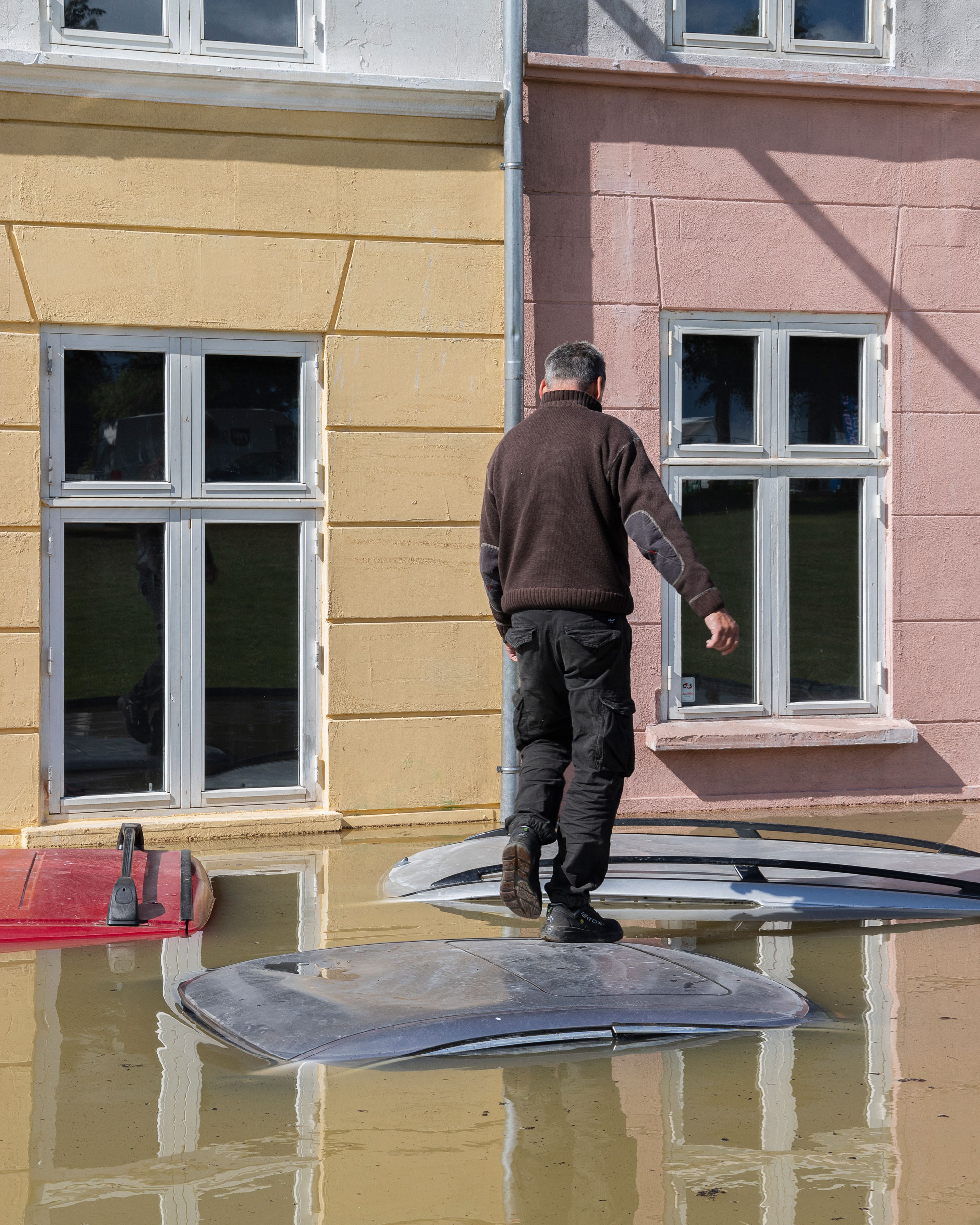
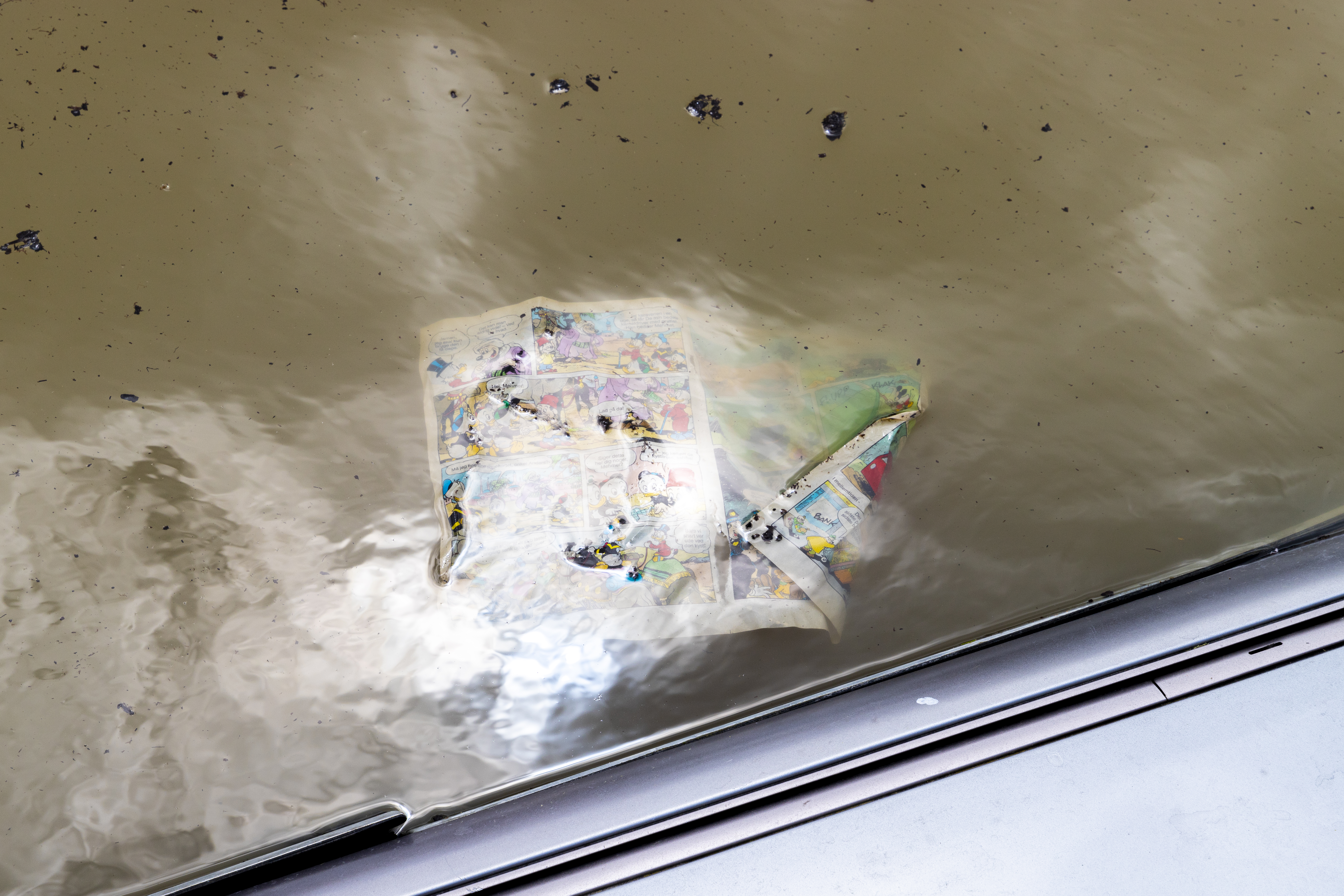

Portraits of Overwhelm, 2024
Car roofs, set design facades, pool with muddy water and garbage
4,8 x 12 x 12 m
Through this work, Kåre Frang allows different realities to merge, creating a situation where multiple emotions and moods can exist in the same space. The work functions as a physical representation of how we constantly tap in and out of an awareness of the near and the distant, confronting the audience with the general complexity inherent in our daily lives, where we live with a flow of updates and insistent streams of information from various catastrophes, which constantly exist but often recede into the background of our actions.
Visitors are welcome to step onto the roofs of the flooded, chaotically spread cars and - in the midst of the festival - eventually have yourself photographed in a situation that points to global issues that a festival, otherwise can serve as a refuge from.
Made with support from the The Danish Arts Council,
STARK JS Svendborg and Hundtofte Autoophug
Water Thief
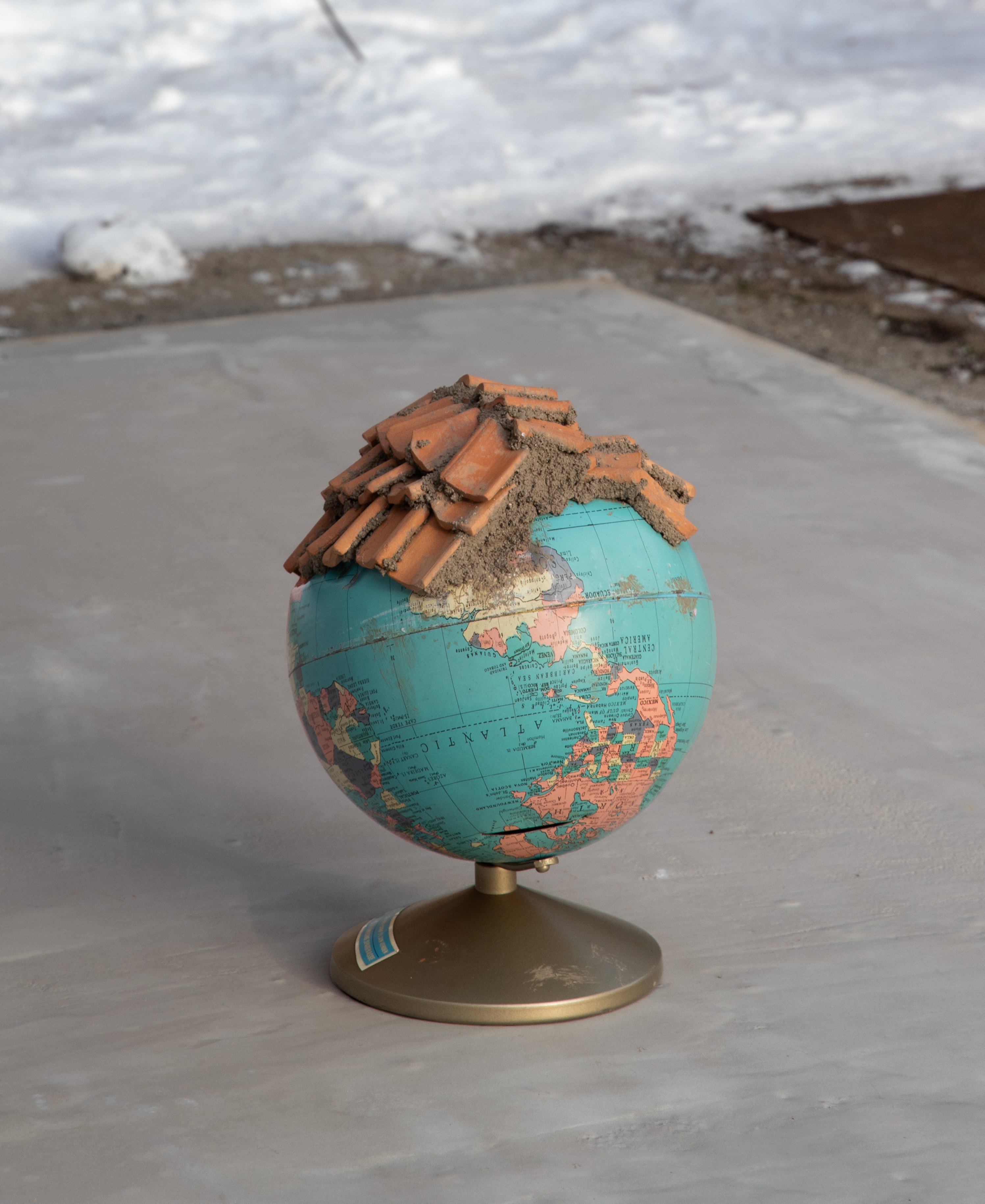
Water Thief, 2024
Modified piggy bank, handmade miniature ceramic roof tiles, mortar, linseed oil, money
15 x 15 x 20 cm
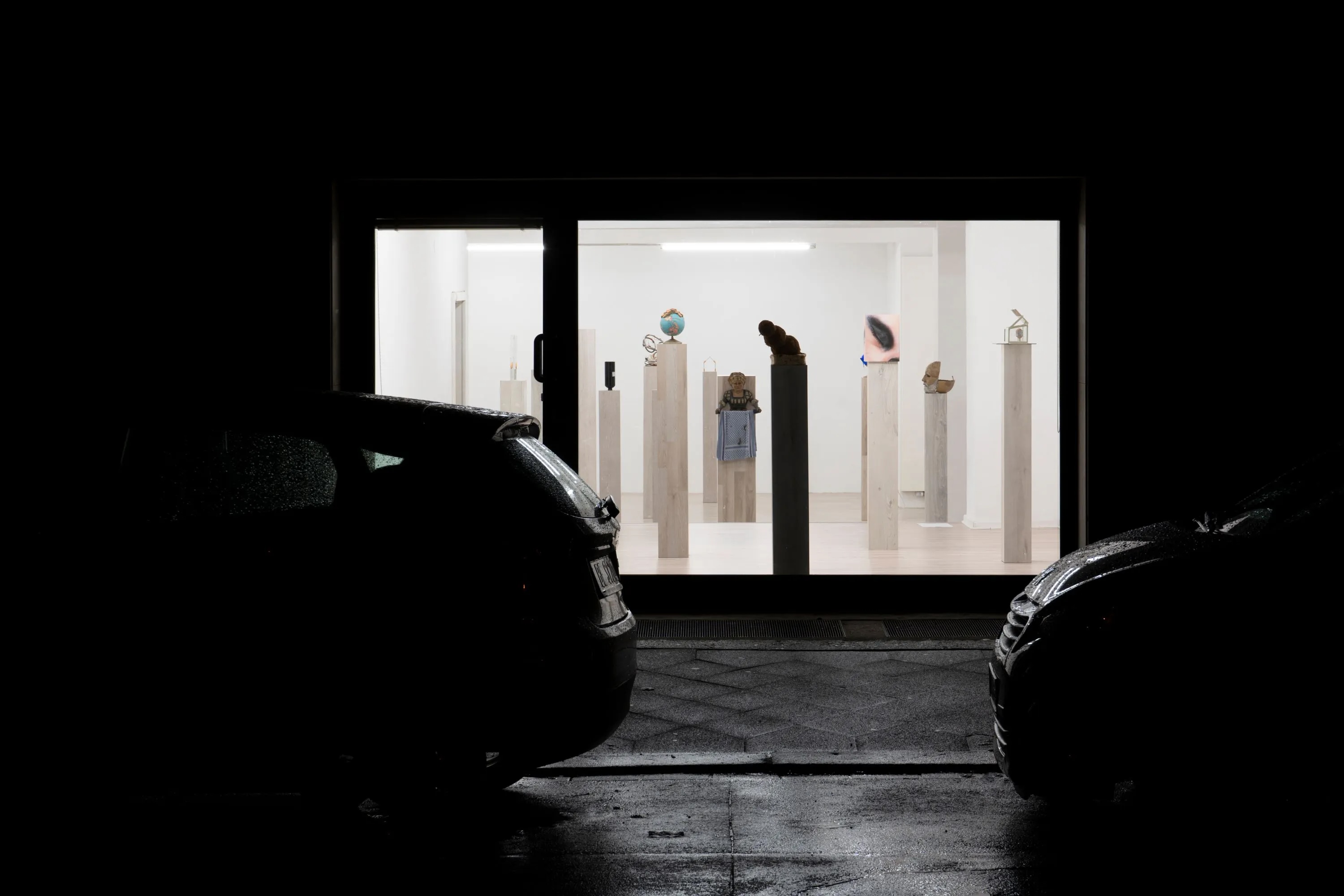
Photocredit: Rinde Am Rhein
Water Thief, 2024
Modified piggy bank, handmade miniature ceramic roof tiles, mortar, linseed oil, money
15x15x20 cm
From the group show Säulen at Rinde am Rhein, Düsseldorf
‘Water Thief’ is a piggy bank globe with handmade ceramic roof tiles attached with mortar on its top serving both as an image of a desperate attempt in seeking shelter from current crises, and as a wig on a head.
The works title 'Water Thief’ refers to the ancient water clock, also known as a Clepsydra (meaning stealing water in greek) as a reflection about time but also more playfully as an abstraction and characterization of capitalism as the Water Thief. Working with the sculpture made me think about the distressing fact that not everyone consider drinking water a human right, and all the horror that follows these individuals influence of our world.
The globe is turned upside down pointing towards a distortion of values and as a final detail, I’ve brushed the roof with linseed oil out of a curiosity in how we historically have been working with landscapes within art.
Head-in-the-sand, Nationalpark Vadehavet
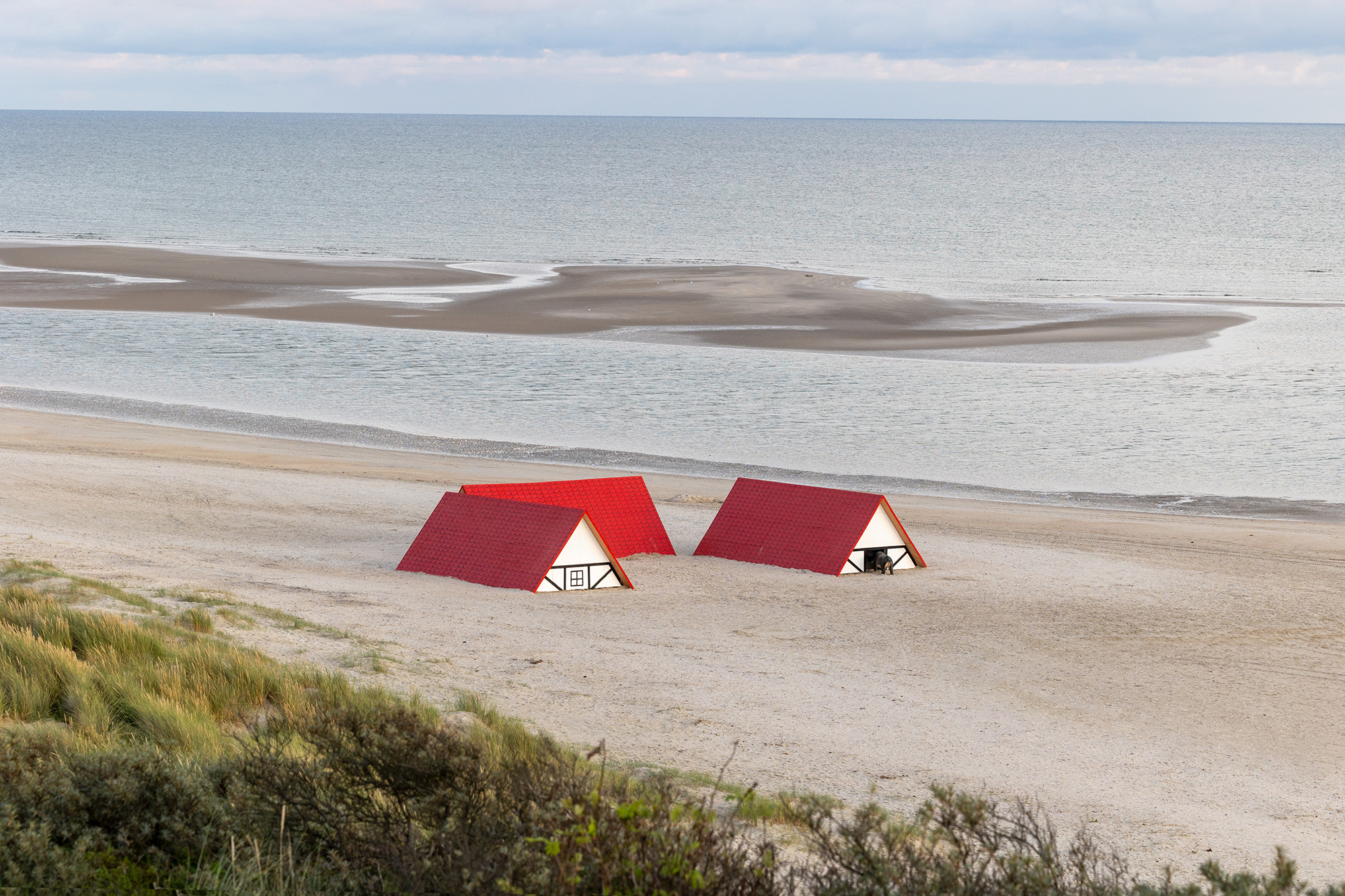
Head-in-the-sand, 2023
Handpainted plywood, rafter, screws, spraypainted fibreglass rhinoceros, sand
18 x 15 x 3 meter
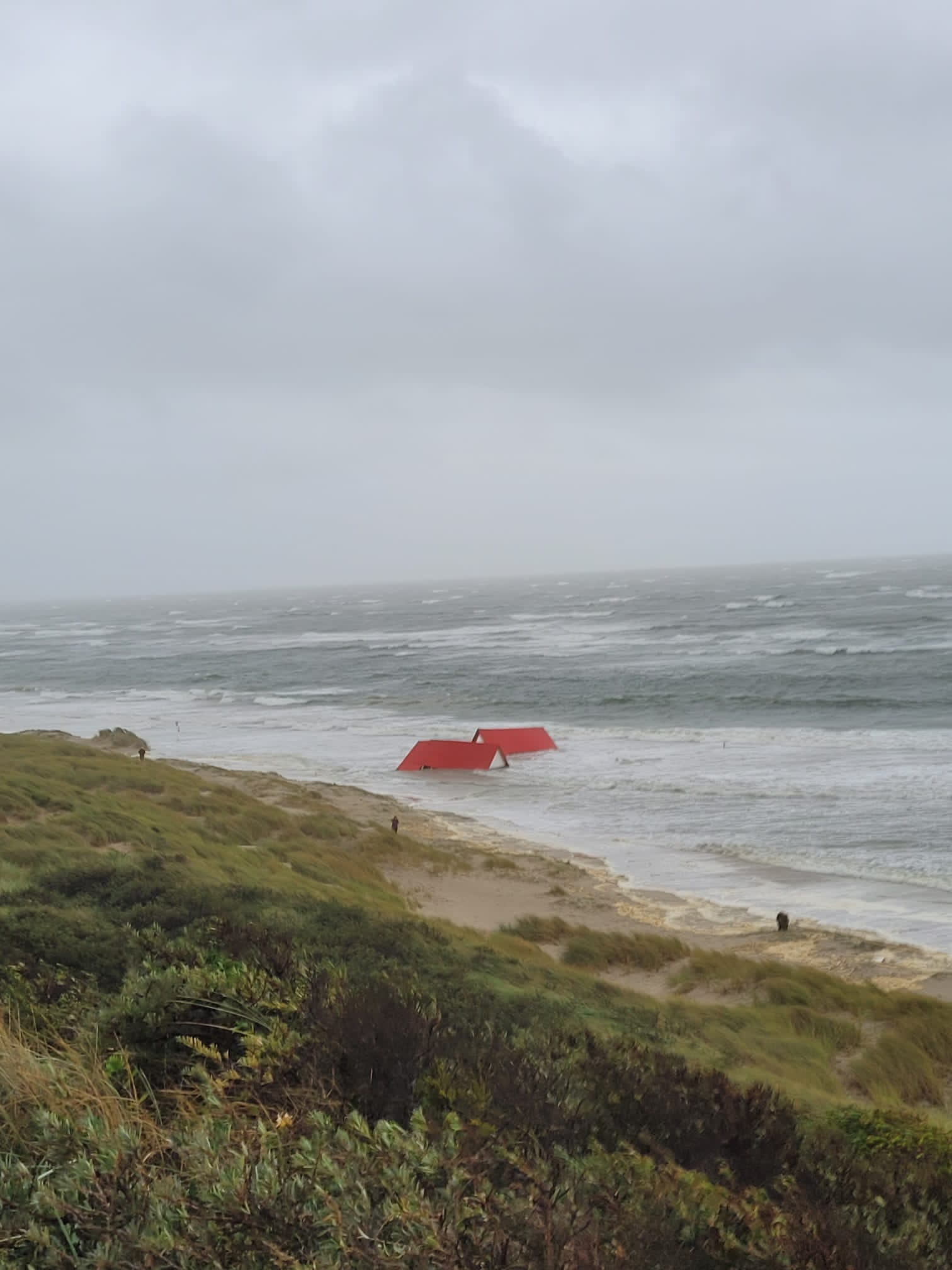
Head-in-the-sand, 2023
Handpainted plywood, rafter, screws, spraypainted fibreglass rhinoceros, stormflood
First There Is A Mountain
01.08.-01.10.2023
Wadden Tide
Nationalpark Vadehavet
Head-in-the-sand, 2023
Handpainted plywood, rafter, screws, spraypainted fibreglass rhinoceros, sand
18 x 15 x 3 meter
Kåre Frang invites us into a universe of play and wonder. His large-scale work for Blåvand Beach juxtaposes the local area’s recent past with an imminent, dystopian future in a subtle and humorous approach. At first glance, the recognizable and surprising motif evokes memories of the landscapes of childhood, and at the same time spreads an uneasiness in the body, which makes you understand that the world we know today will not last.
Head-in-the-sand is about change. And about how we as humans experience and relate to change in our own lives, in society and in the nature around us. The transformed toy landscape, where a rhino has taken shelter, takes a look at local history, where sand as a natural force has been a condition for settlement. Another look is directed towards the distant past, where Denmark’s ice-covered landscapes were home to woolly rhinos. At the centre is today’s climate crisis, which threatens biodiversity and the survival of species. Nature’s transformation heralds challenges for both animals and humans, who must adapt to survive.
Kåre Frang’s works revolve around changes and the fragility of everyday life. In video and sculptures, he distorts and stages familiar objects, often games and toys from childhood, displacing their materials, manipulating time or playing with scale. Typically, his works encapsulate that moment when things and feelings are at a stage either just before, during or after a collapse. A new condition arises and comes into being.
Curated by Stenka Hellfach and Tyra Dokkedahl
Attachments, Posta space

installation view
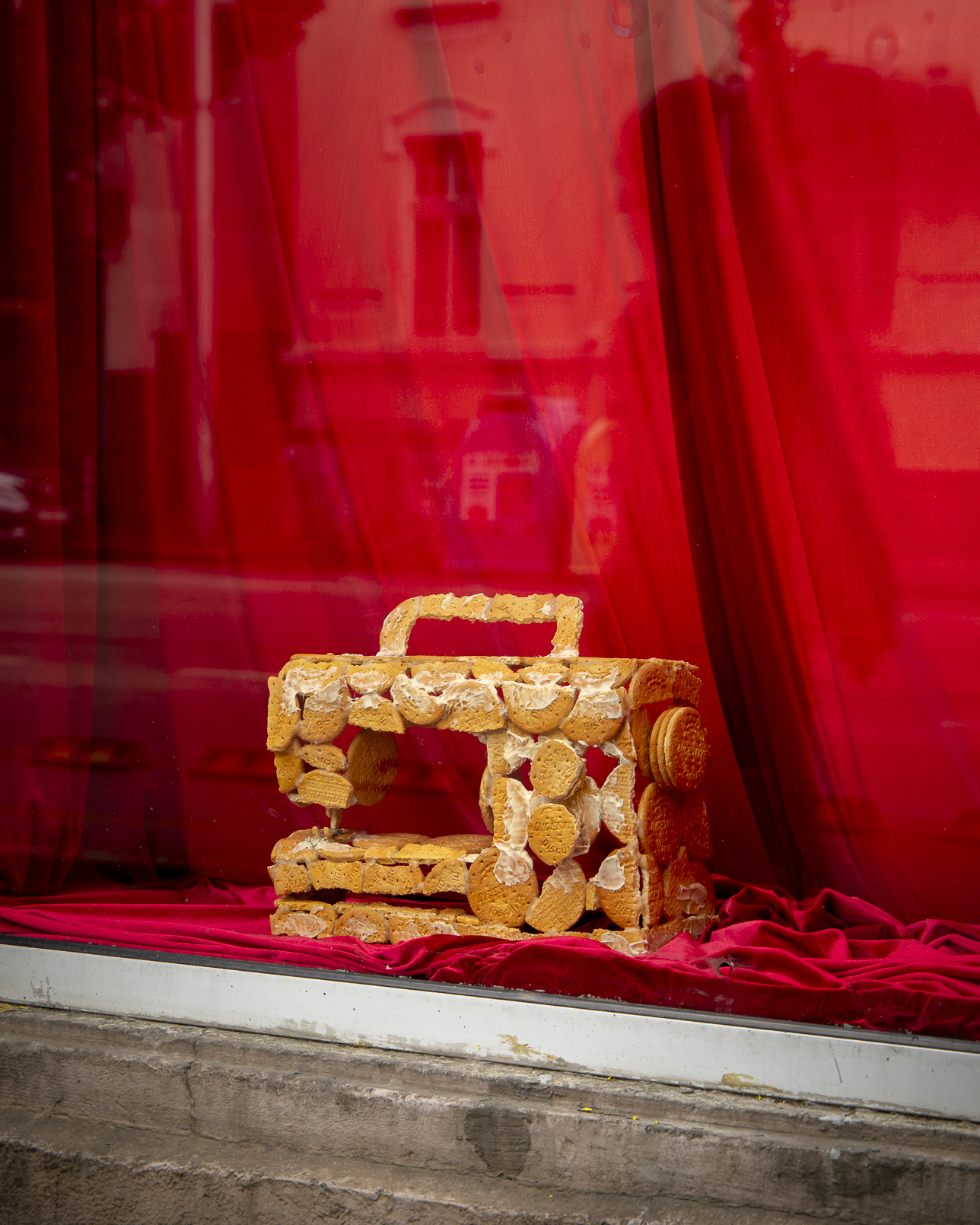
Attachments, 2021
Hand-painted Jesmonite, silicone, hot-melt glue, epoxy, varnish, ice cream sticks, sewing thread
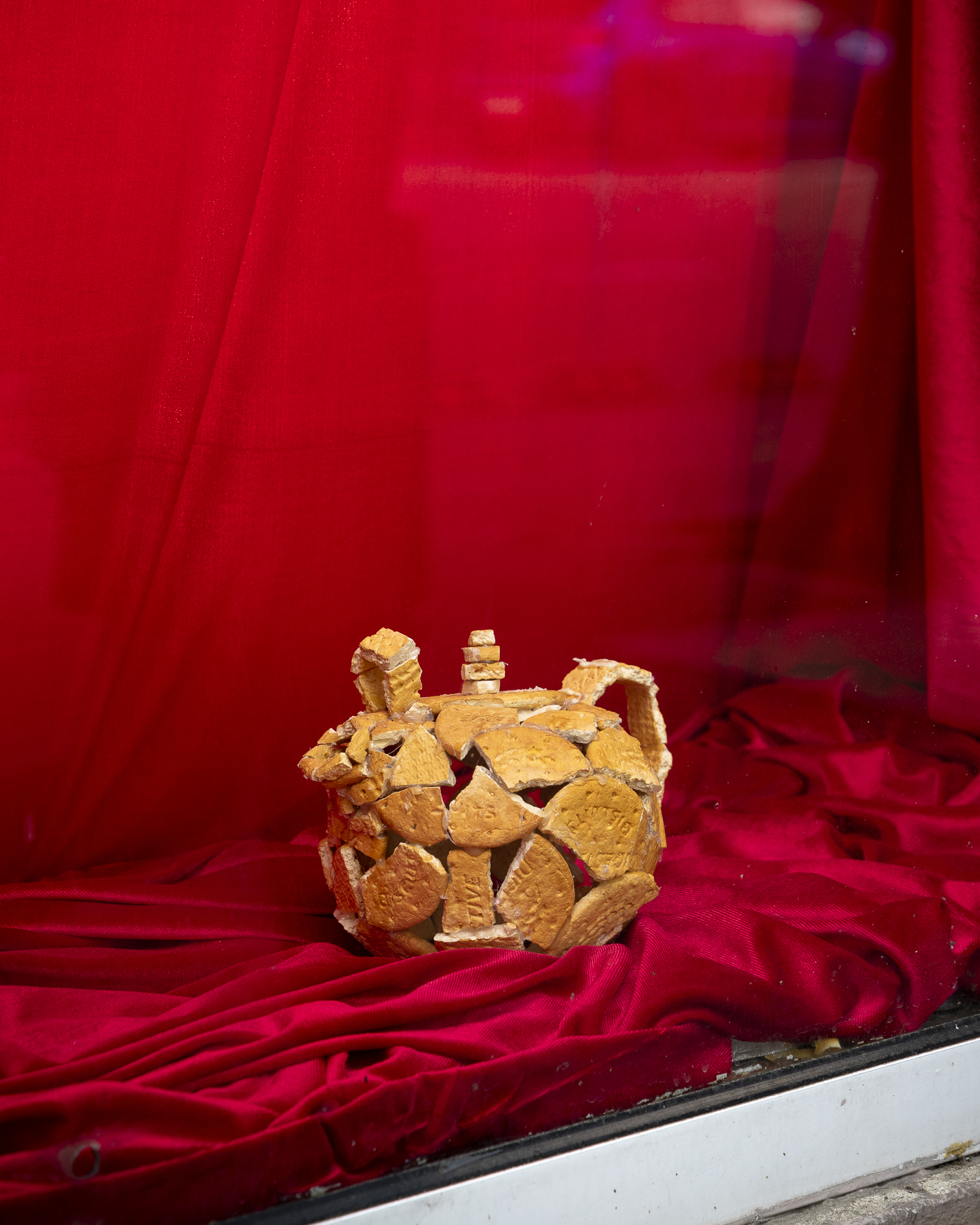
Attachments, 2021
Hand-painted Jesmonite, silicone, hot-melt glue, epoxy, varnish, ice cream sticks
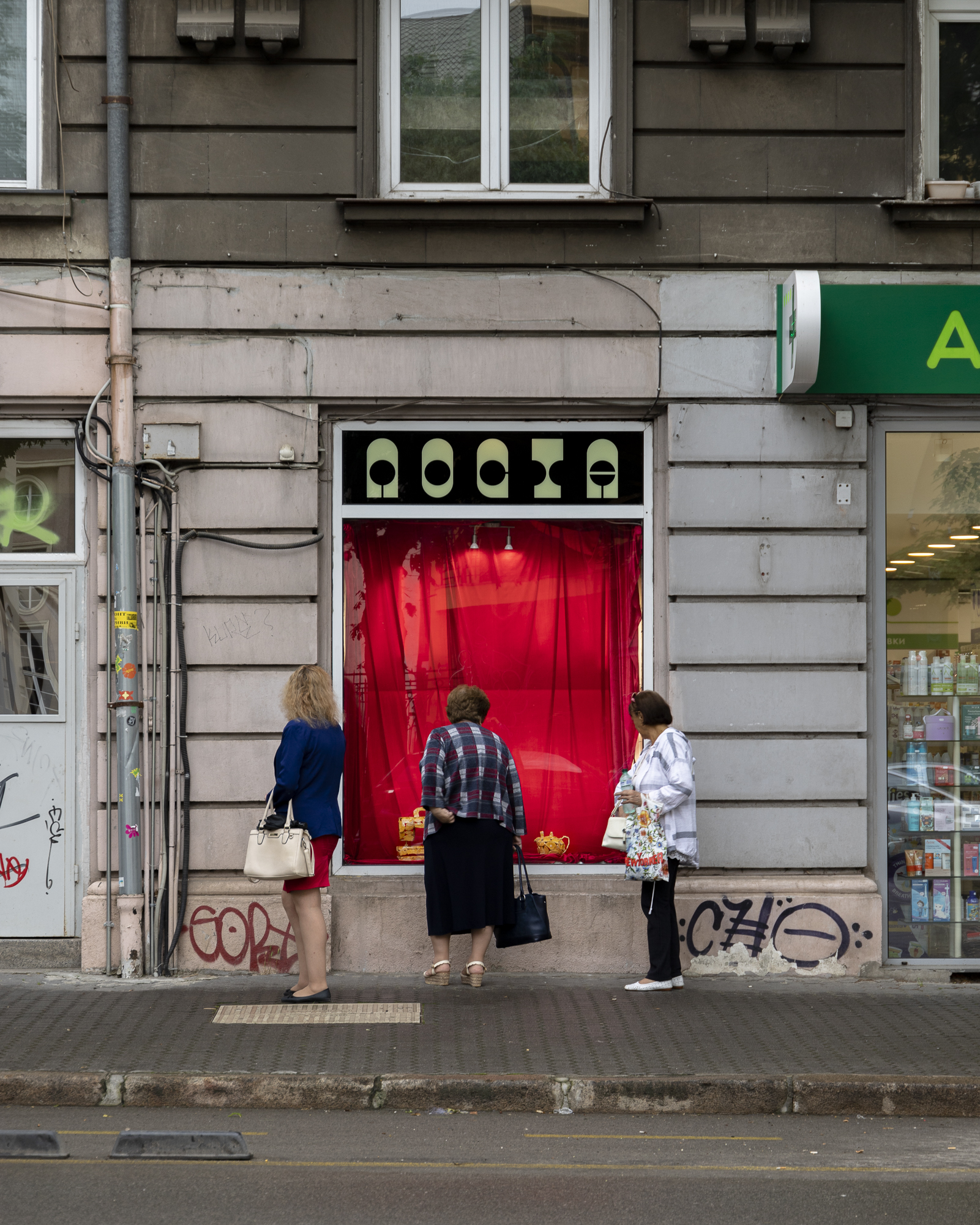
Street view
Attachments
13.06.-08.07.2023
Posta Space
Sofia, Bulgaria
Привързаности, Punta Gallery
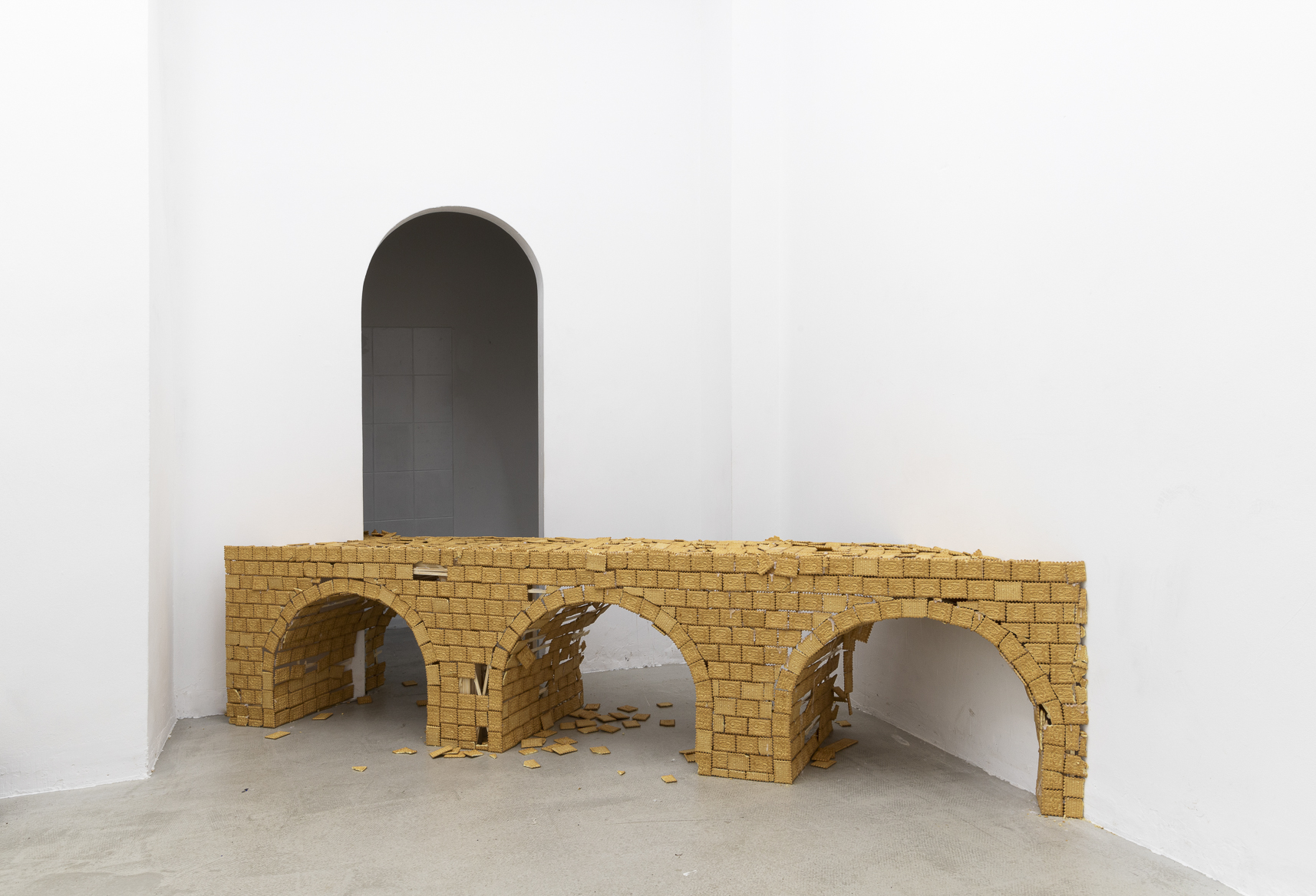
Привързаности, 2023
Biscuits, glue, wood
73 x 273 x 62 cm
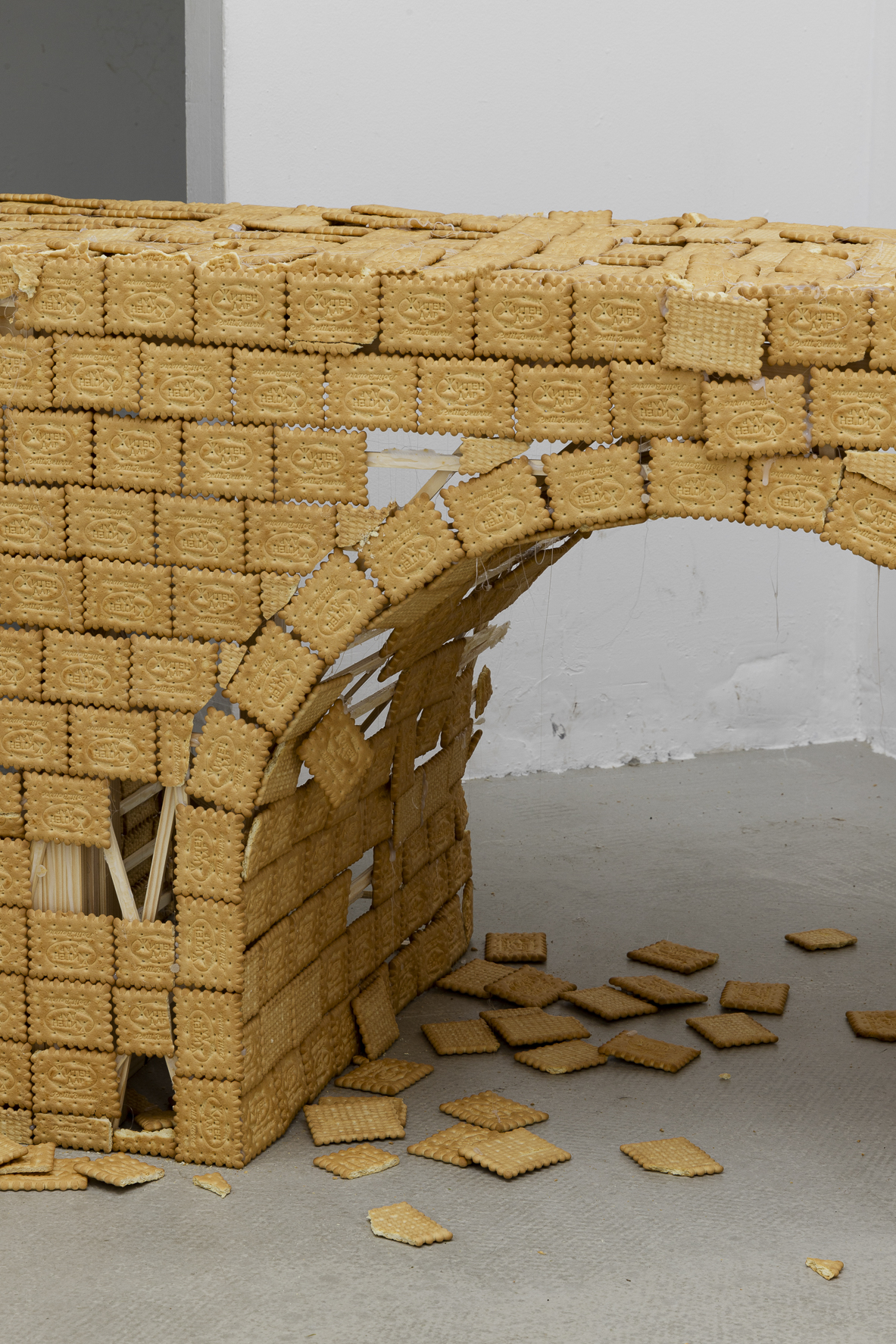
Привързаности, 2023
Biscuits, glue, wood
73 x 273 x 62 cm
(detail)
Привързаности
13.06.-08.07.2023
Punta Gallery
Sofia, Bulgaria
Once upon a time there was an old sow who had three little pigs and because she didn't have enough food for them, she told them that they had better go out into the world to seek their fortune.
The biggest piglet went first. And as it trotted along, it met a man carrying a bundle of straw. Very politely he asked him to give him some straw to build a home. The man agreed, and the little pig built himself a wonderful house. However, the wolf came along, saw a potential dinner, and despite the piglet's resistance, blew hard on the building, it was thrown about, and so the piglet was eaten.
The second pig decided to build its shelter using nonrenewable natural resources. The house turned out great - shiny, with warm colours and Bauhaus shapes. Little by little, however, the building caved in - the trees the piglet had cut down to build it didn't control the water and the area flooded. The strong sun scorched its facade and in combination with the violent winds the house began to crumble. Meanwhile, the wolf, who was anyway annoyed by the situation caused by the pig, which directly affected him, was hanging around, knowing sooner or later the house would collapse. The piglet was aware of the longterm consequences, but ingonred the situation. Still, he suffered from growing anxiety and insomnia. And the wolf was waiting..
_______
In the exhibition "Attachments", artist Kaare Frang continues his practice of working with biscuits. In the spaces of POSTA and PUNTA gallery are sculptures created in Copenhagen and Sofia, during the artist's one-week stay here.
Initially, the exhibition in PUNTA confronts us with uncertainty due to its choice of medium - the biscuits "Gift of the Wheat", widely distributed on the Bulgarian market. Instinctively, we read wheat through our emotional attachment to it and its meanings - a source of sustenance, an integral part of almost all peoples' diets, an everyday element in the average household with ritual saturation. Because of its life-affirming function, it has the power to entangle broad economic and political cases (most recently, the Ukrainian grain import deal, which established corridors for cargo ships to pass through the Black Sea), but also ones with long-term global concerns, such as the effect of the environmental crisis on this resource and its potential yield. Many of these factors we are consciously aware of, and others we choose to ignore in our everyday lives - in the age of anxiety in which we are trying and more or less failing to cope with the new world, using yesterday's tools and ideologies.
The artist exploits a medium conventionally associated with creating and sustaining life; however, being interested mostly in its other properties - its ephemerality. Thus, the exhibition seems to stand on a flawed foundation. Erosion, however, is its plan-program - throughout the following weeks, the works will disintegrate under the influence of the external environment, reminding us of the fragility of the world, its structures and systems. Frang highlights, through his choice of objects to reproduce (a globe, a bridge, an air conditioner, etc.), themes such as ecology, the movement of resources, industry and economy, encompassing the iconography of today's world of globalization.
Time in the gallery moves in parallel with global processes, taking into account man's current place on the world time-axis - the collapse has not happened yet, but we sense its imminent arrival. Contrary to the frozen temporality of the white cube, Kaare Frang's work in PUNTA reminds us that the passage of time is irreversible and certain. With the launch of the exhibition (the placement of the works in the gallery), the artist seems to be triggering a timer of apocalyptic events.
Curation and exhibition text by Boyana Dzhikova
*The project is made possible with the financial aid of the Ministery of Culture.
Det bliver mørkt om natten
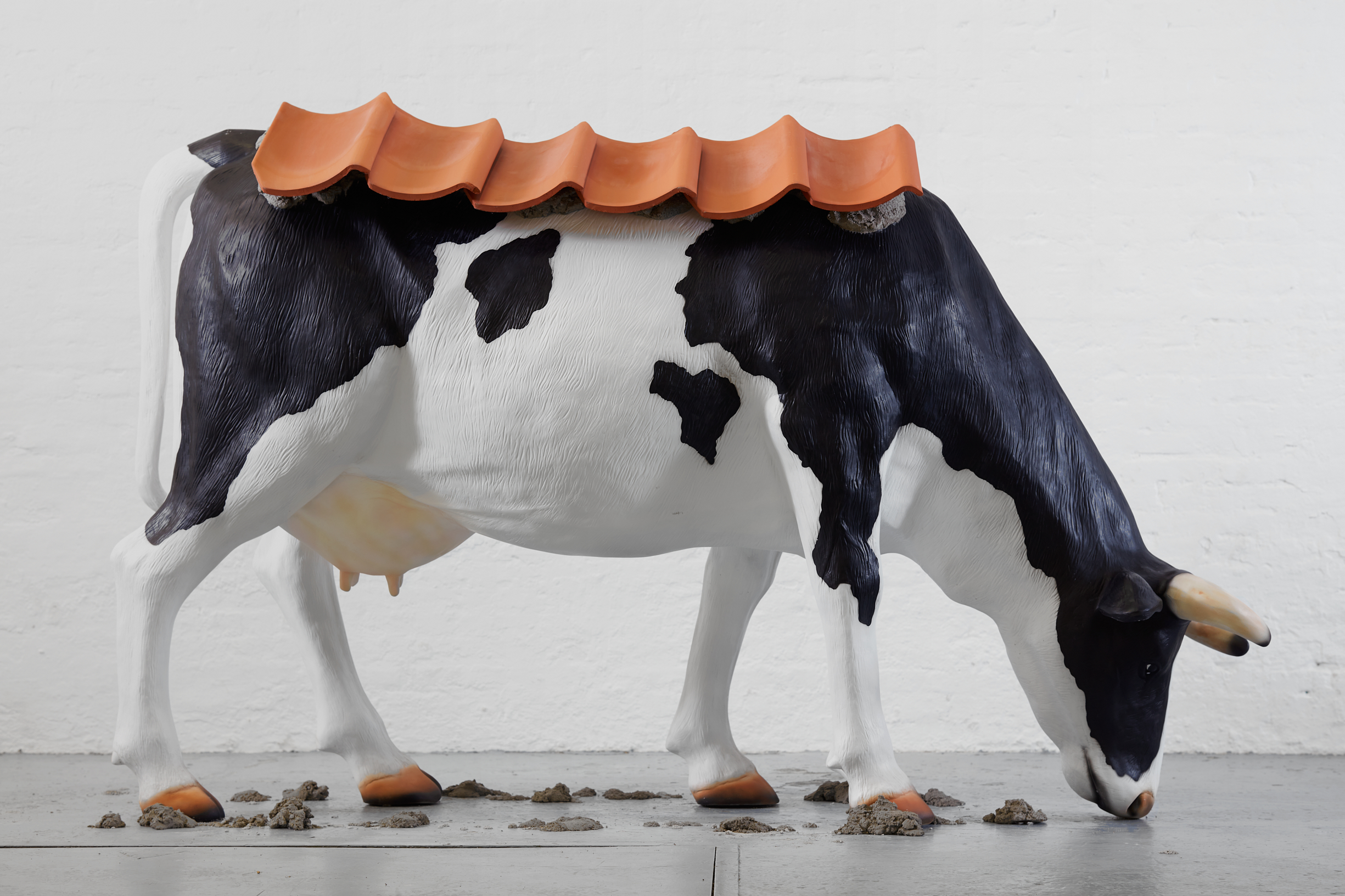
Det bliver mørkt om natten, 2023
Ceramic roof tiles, mortar, spraypainted fiberglass
135 x 210 x 73 cm
Photo: Morten Jacobsen, Ringsted Galleriet
DIRT
13.05.-03.06.2023
Ringsted Galleriet
Group exhibition with Søren Martinsen and Siska Katrine Jørgensen
Overwhelmed
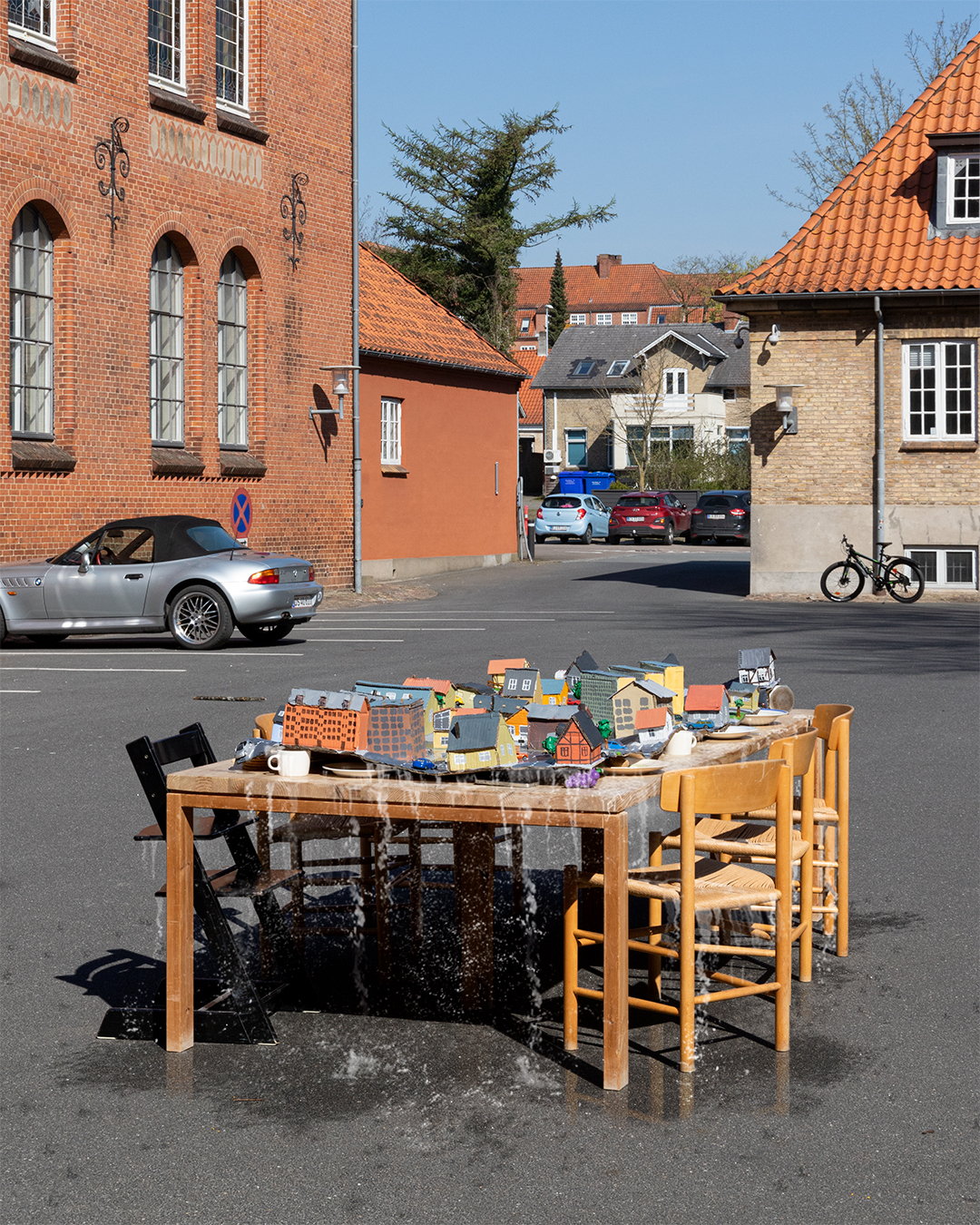
Overwhelmed, 2023 (model for a fountain of painted bronze)
Cardboard, glue, paint, toy cars, clear resin, table, chairs, plates, knives, forks, spoons, coffee cups, wooden puzzle without pieces, laptop, cast and hand painted digestive biscuits, handpainted bronze toy fruit, espresso maker, stack of cell phones
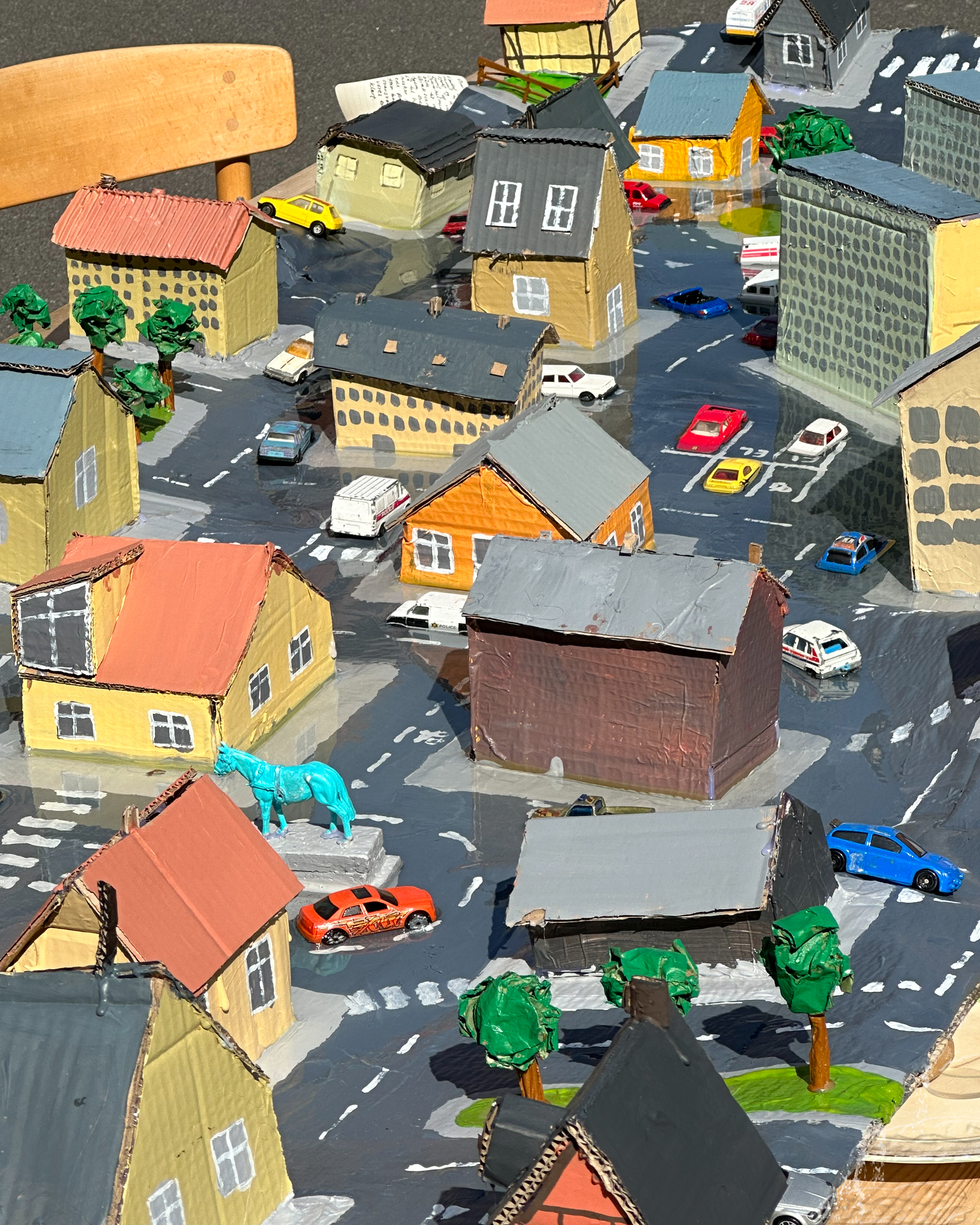
Overwhelmed, 2023
Cardboard, glue, paint, toy cars, clear resin, table, chairs, plates, knives, forks, spoons, coffee cups, wooden puzzle (no pieces), laptop, cast and hand painted digestive biscuits, handpainted bronze toy fruit, espresso maker, stack of cell phones
Overwhelmed is both a 1:1 sketch model for a fountain made of cast and hand-painted bronze and a work in itself. The work both deals with the nightmare scenario where cities and homes are flooded, but also to how we as humans can feel overwhelmed in a way that is best described as an inner flood that drowns our ability to think clearly.
Should Overwhelmed be realized as a fountain in public space, then I imagine the entire sketch including table and chairs cast in bronze, which will then be hand-painted naturalistically. The water will constantly flow out from under the cars, and flow over the city, the table and the chairs and splashing onto the ground, and pumped up again. All at once we’re flooded and overwhelmed.
Kunsthal 6100
Det store springvandsprojekt
Capacities
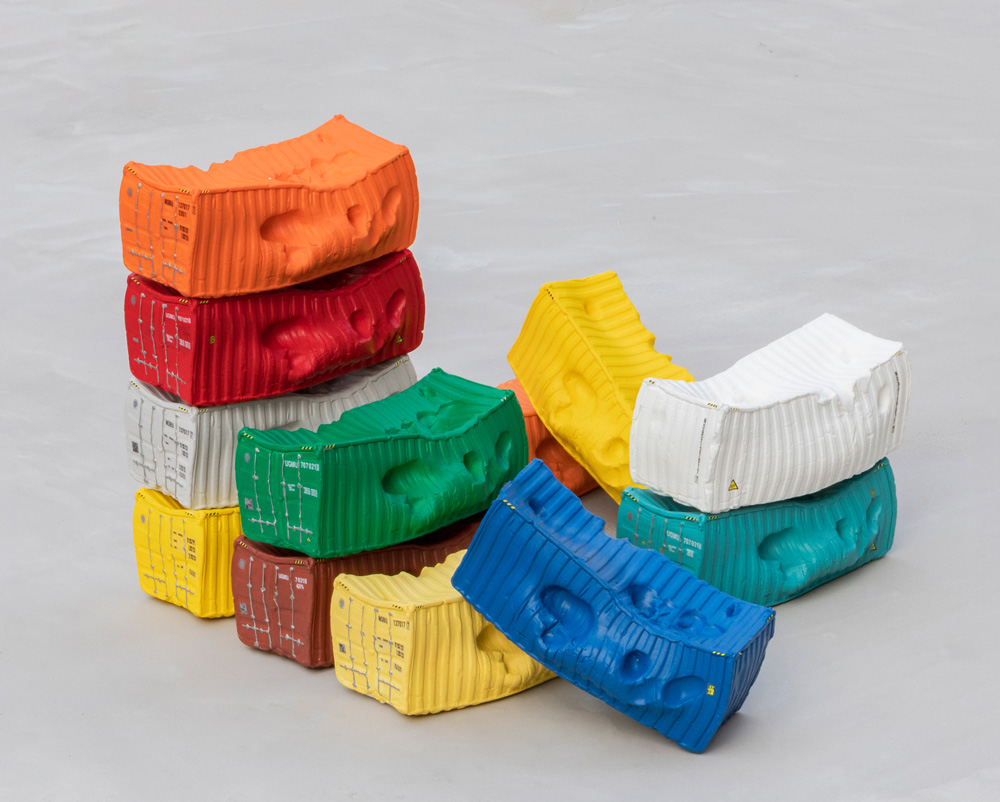
Capacities, 2022
Handpainted jesmonite, decals, varnish
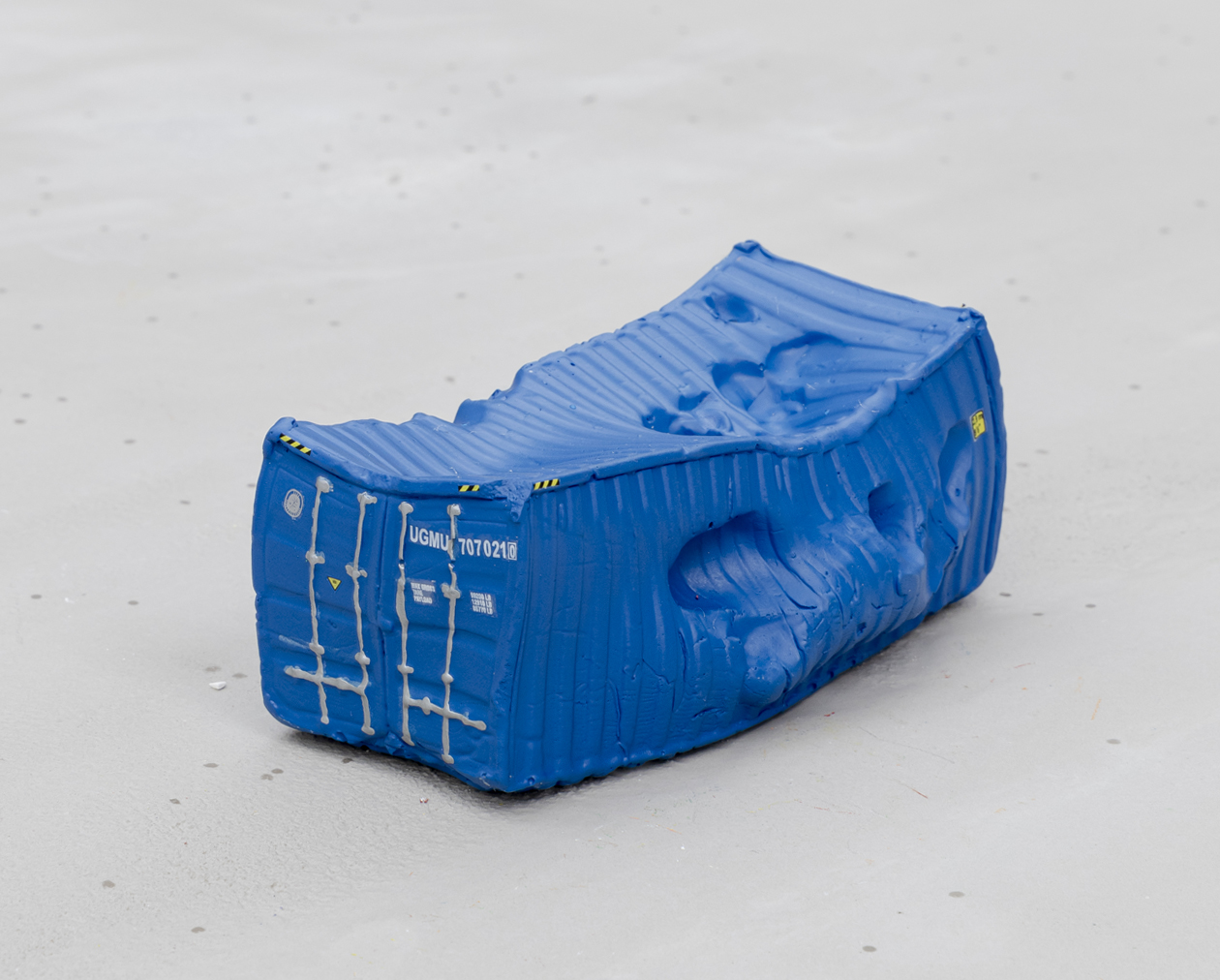
Capacities, 2022
Handpainted jesmonite, decals, varnish

Capacities, 2022
Handpainted jesmonite, decals, varnish
Capacities, 2022
Handpainted jesmonite, decals, varnish
12,5 x 5 x 7 cm, Edition af 12 (+2AP)
Den Danske Radeerforenings særudgivelse 2022
In the work Capacities, Kåre Frang uses shipping containers as an abstraction over the internal personal realm as well as the outer societal sphere. The sculptures are modified and hand painted 1:50 scale models of 20 feet shipping containers that have been deformed by Frang’s one-year-old child’s little hands and fingers. A series of overlapping narratives are weaved together and the work oscillates between the distant and the intimate; it becomes political in the human obstruction of the shipping container’s function while simultaneously pointing to our inner self as a fragile and in-flux container. Capacities marks the beginning of a new series of works from Frang’s hands in which shipping containers act as a formal, material and conceptual departure point for discussions on the interrelations between human psyche, consumerism and contemporary political and social life.
Attention Crisis
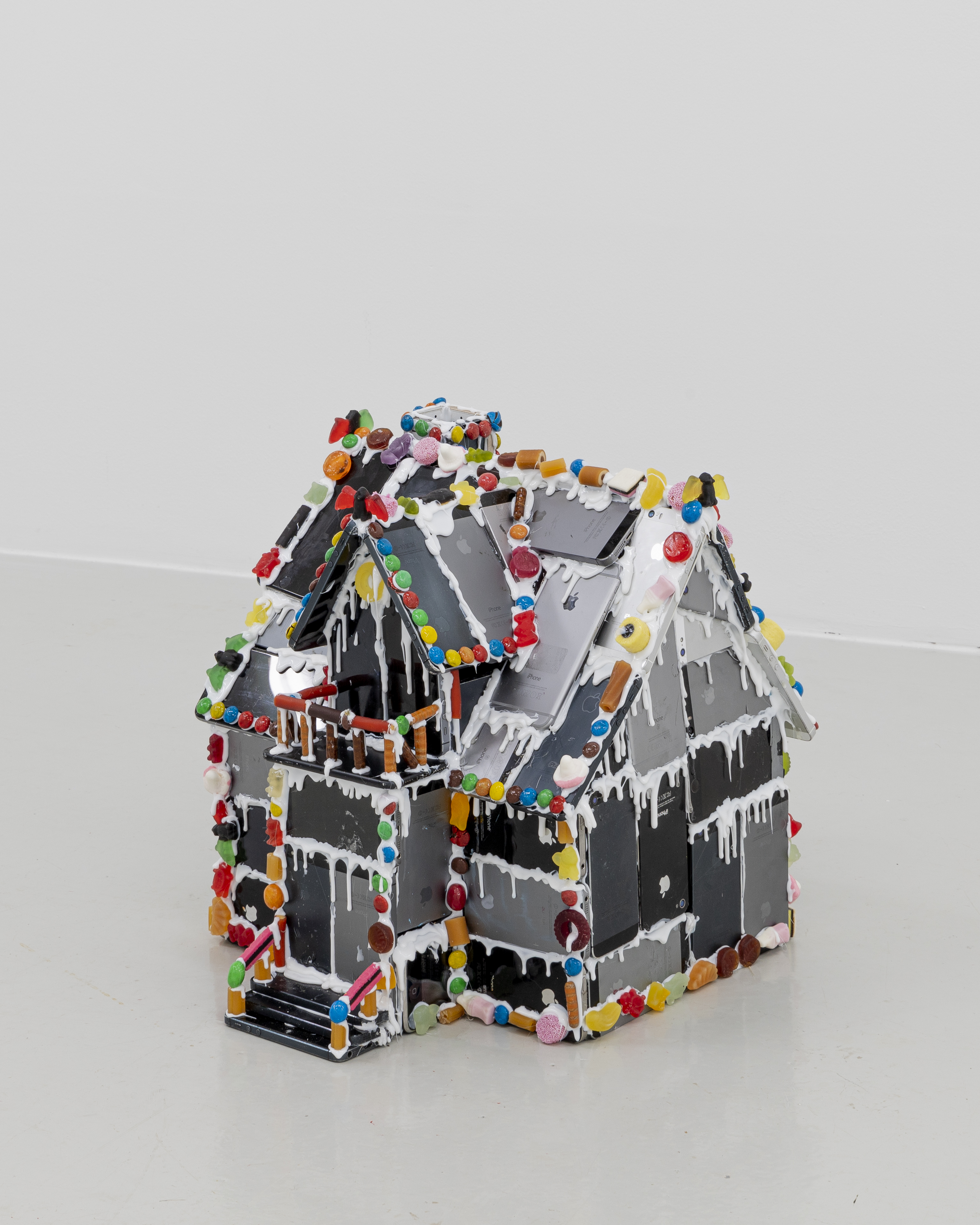
Attention Crisis
iPhones, hotmelt glue, varnished candy, epoxy
2022
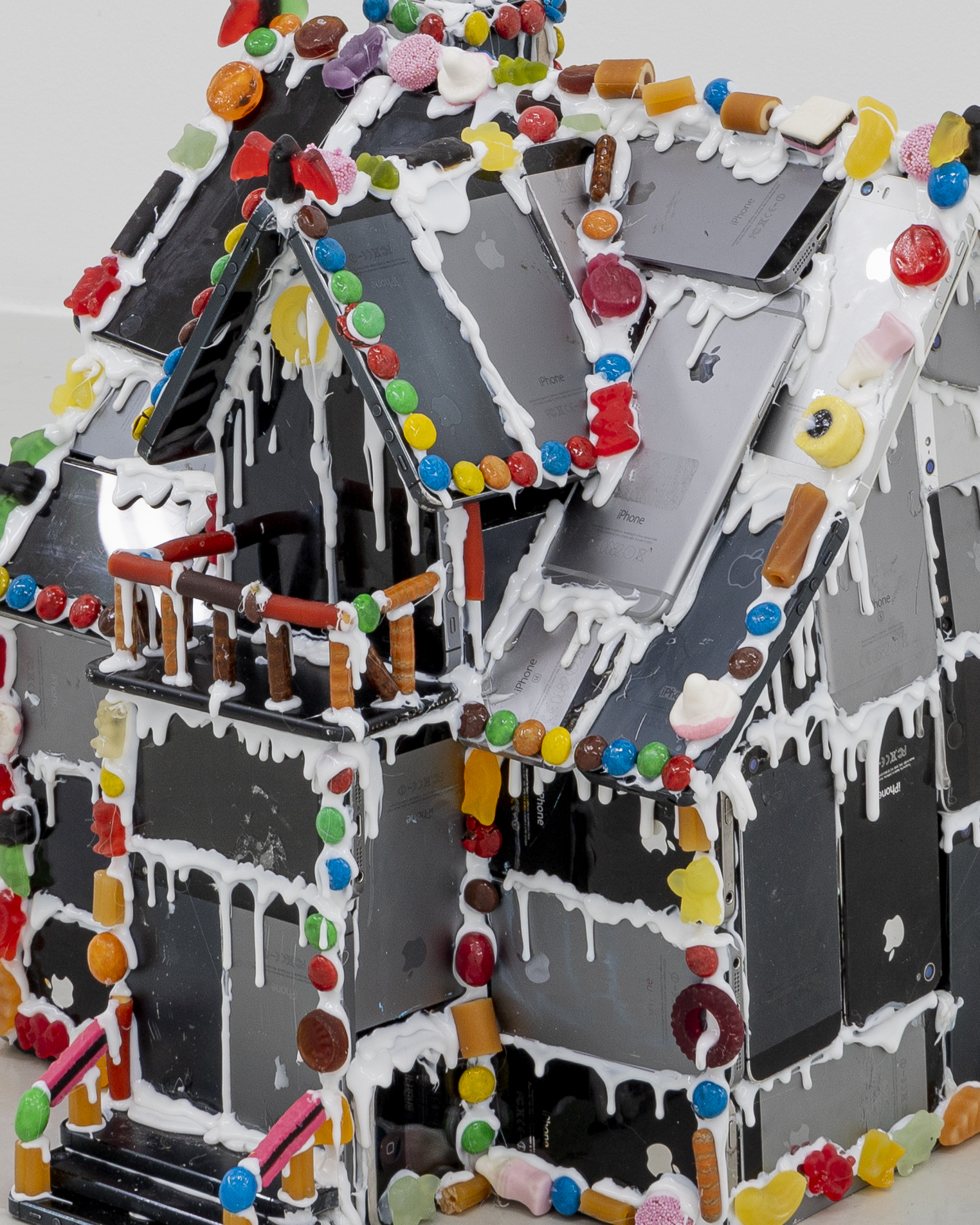
Attention Crisis
iPhones, hotmelt glue, varnished candy, epoxy
2022
Attention Crisis
iPhones, hotmelt glue, varnished candy, epoxy
2022
Viva voce
10.09.–23.10.2022
Opening 09.09.2022
Group exhibition with
Moa Alskog, Emilie Bausager, Kåre Frang, Laura Guiseppi, Asta Lynge
Loggia is excited to collaborate with Lagune Ouest as its invited partner for this year’s edition of Various Others. The exhibition features work by emerging artists who primarily live and work in Copenhagen and gives viewers a glimpse into recent developments in the Danish art scene.
Although different in organization and legal structure, both Loggia and Lagune Ouest share a similar set of values and interests, in particular, supporting local artists and showcasing idiosyncratic expression in the field of sculpture. Therefore, one aspect of the exhibition is to question the current definition of sculpture by expanding and hopefully transcending it.
loggialoggialoggia.com
laguneouest.com
Gabelsbergerstraße 26
80333 München
Landscapes of Doubt, Chart Art Fair with Lagune Ouest
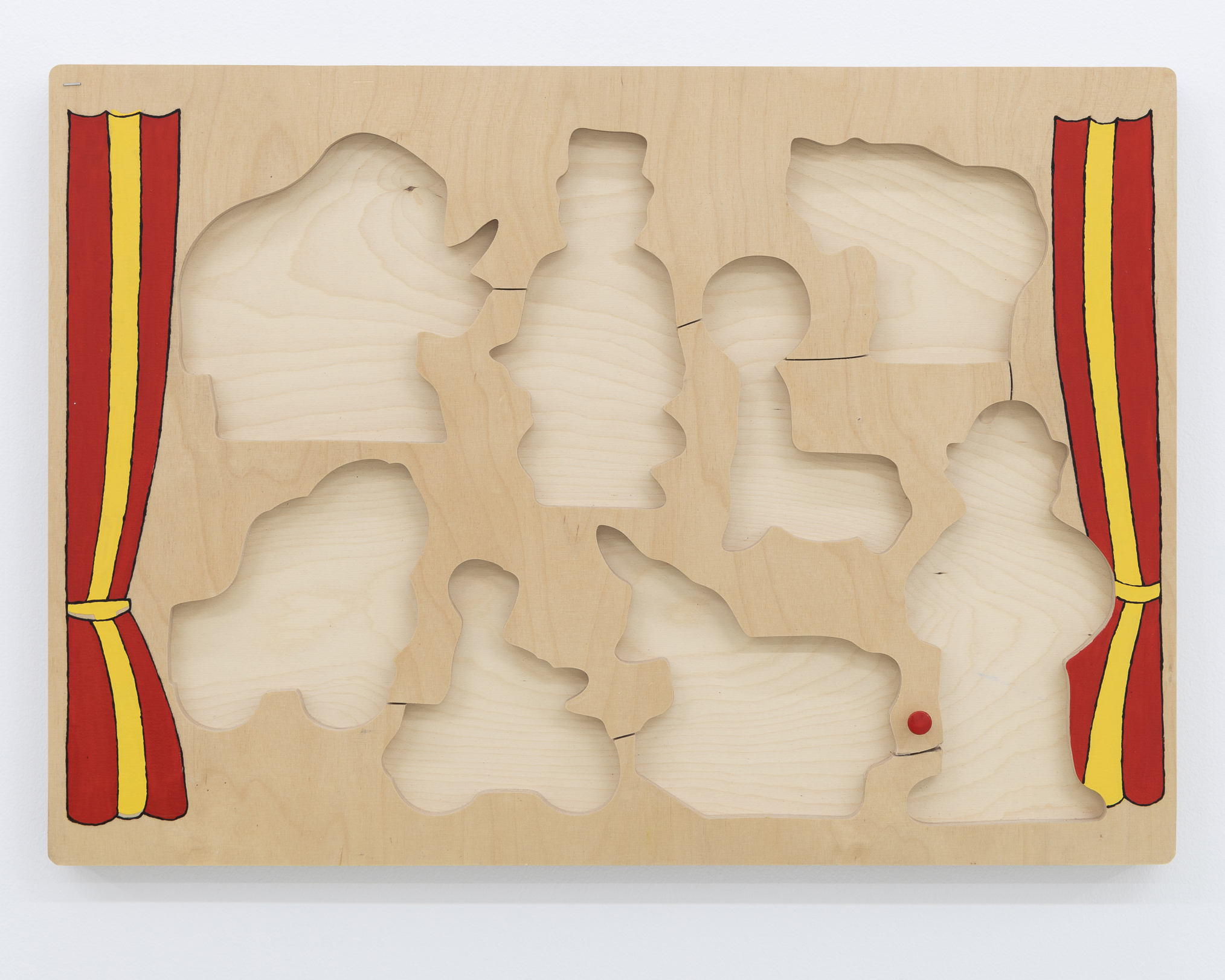
Landscapes of Doubt
Enamel and varnish on birch plywood, hand-painted jumbo pushpin
52 x 73 cm
2022
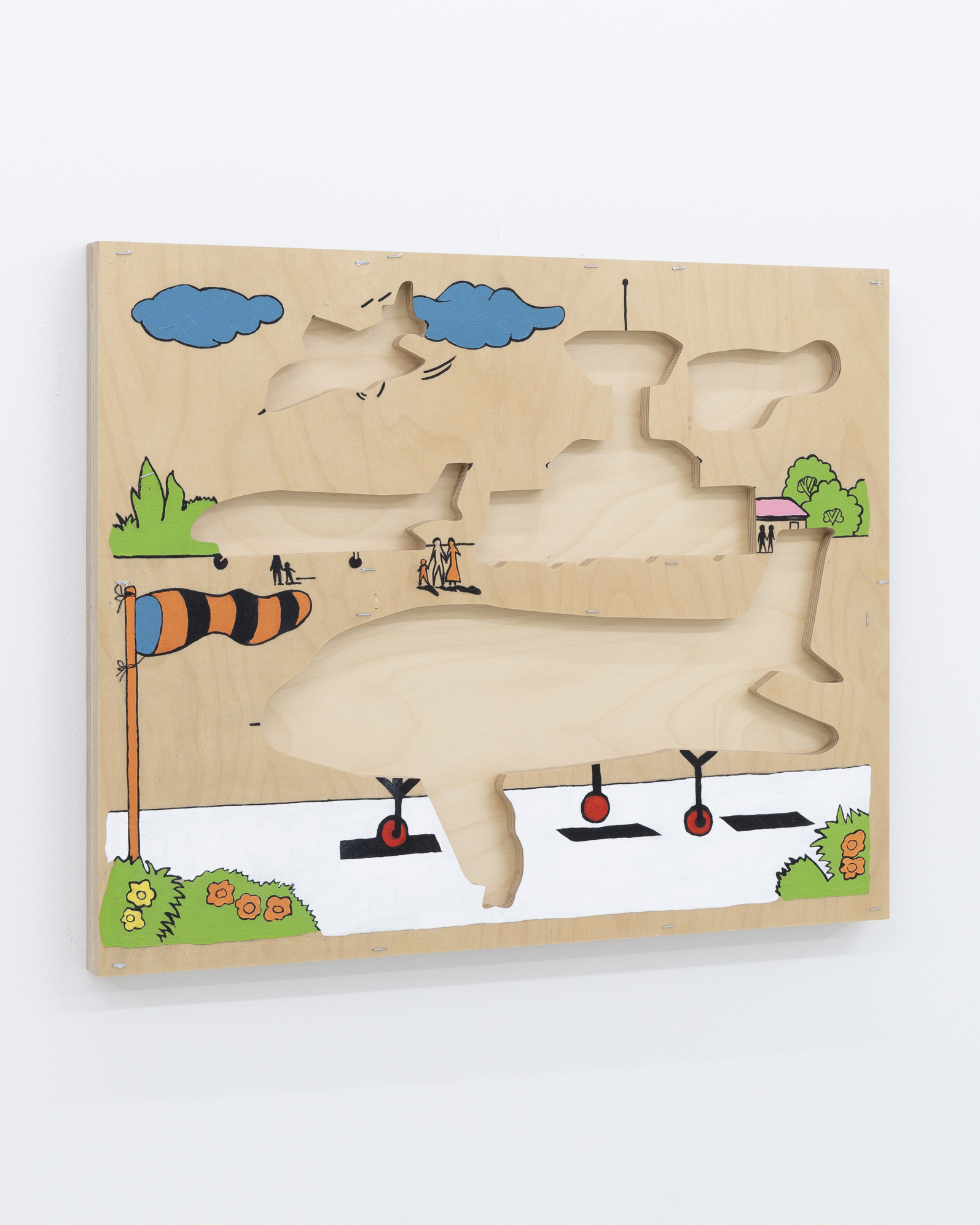
Landscapes of Doubt
Oil and varnish on birch plywood, staples, paper
53,5 x 66,5 cm
2022
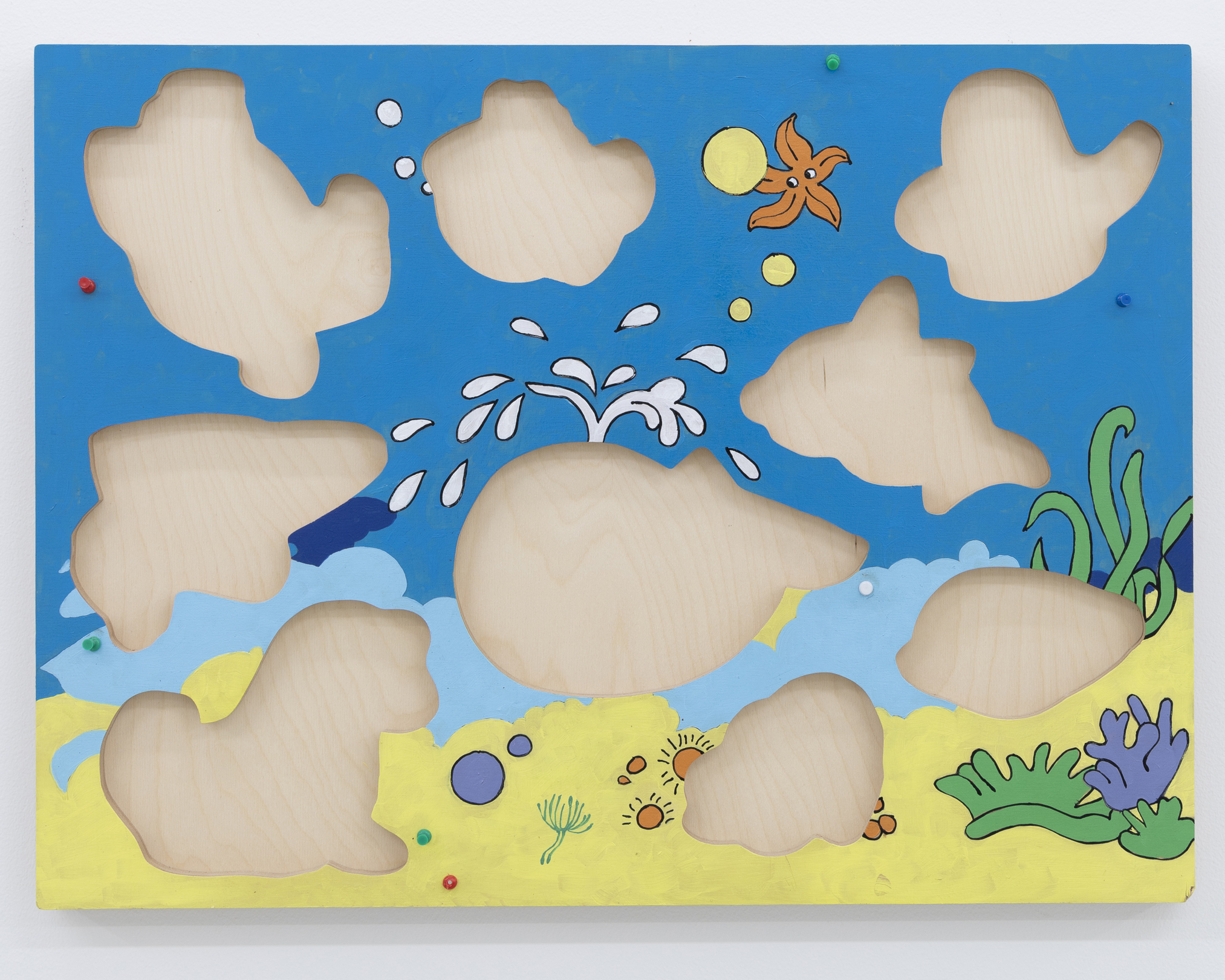
Landscapes of Doubt
Oil and varnish on birch plywood, staples, paper
53,5 x 66,5 cm
2022
View all works from this series here
Chart Art Fair with Lagune Ouest
25.08. - 28.08.2022
View all works from this series here
Attachments, Chart in Tivoli
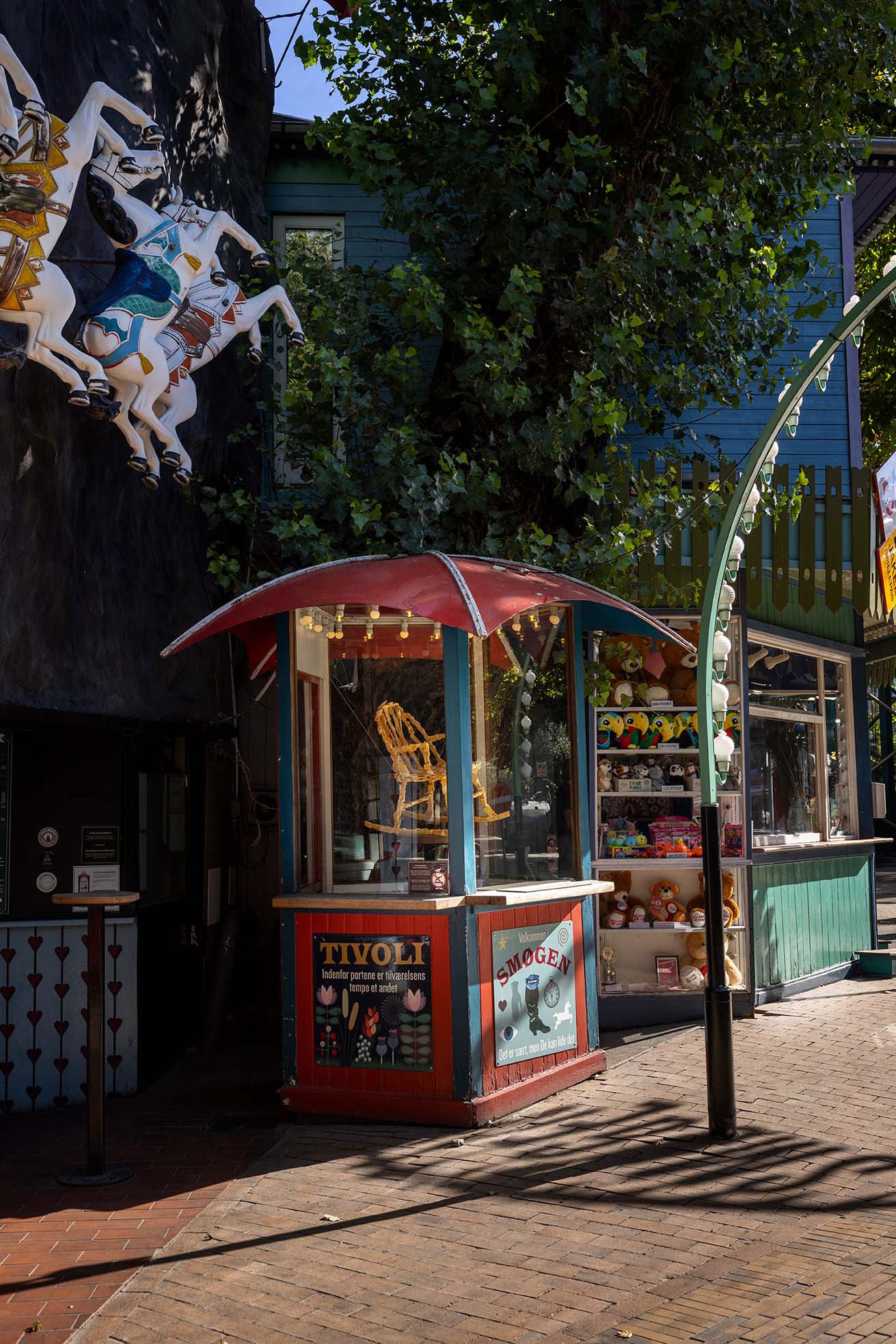
Attachments, 2021. Hand-painted Jesmonite, silicone, hot-melt glue, epoxy, varnish.
Courtesy the artist & Lagune Ouest, Copenhagen and CHART in Tivoli 2022. Photo: Jan Søndergaard
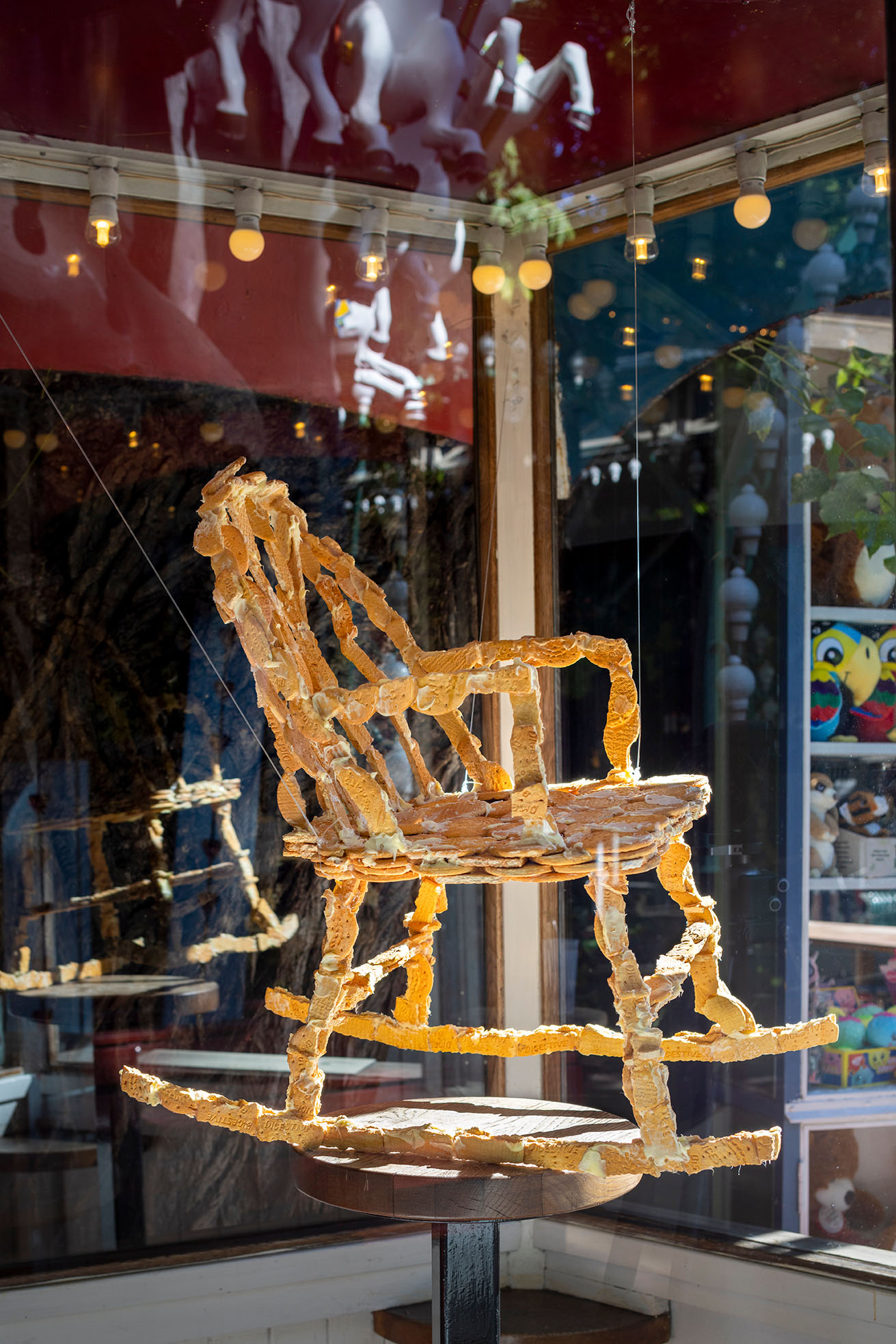
Attachments, 2021. Hand-painted Jesmonite, silicone, hot-melt glue, epoxy, varnish.
Courtesy the artist & Lagune Ouest, Copenhagen and CHART in Tivoli 2022. Photo: Jan Søndergaard
Chart Art Fair in Tivoli Gardens
25.08. - 25.09.2022
The exhibition will invite visitors to explore a series of new installations by 15 artists situated throughout the park, including site-specific sculptures and video projections, thereby expanding the traditional art fair format and encouraging new audiences to engage with contemporary art.
Opened in 1843, Tivoli Gardens is one of the oldest amusement parks in the world and a historic cultural landmark in the centre of Copenhagen. The exhibition will launch on 25 August to coincide with CHART and is set to run until 25 September.
---
Kåre Frang is a Danish artist who primarily works with sculpture. In his choice of materials and form, Frang is preoccupied with the stories, structures, and mechanisms that are attched to each of the things.
Frang has created a rocking chair sculpture placed in the small pavillion by the entrance to the Smøgen area of Tivoli, cast from biscuits, which he has painted and assembled with hot-melt glue, epoxy, and a butter-like silicone. The result is a both fragile and clumsy object with no practical use whatsoever, with a materiality and shape that recalls personal experiences and memories.
Kåre Frang (b. 1992) holds a MFA from The Royal Danish Academy of Fine Arts. He has been part of multiple Danish exhibitions, and is the recipient of the Anne Marie Carl-Nielsen Talent prize, 15. Juni Fonden Honorary Award, and Silkeborg Kunstnerlegat.
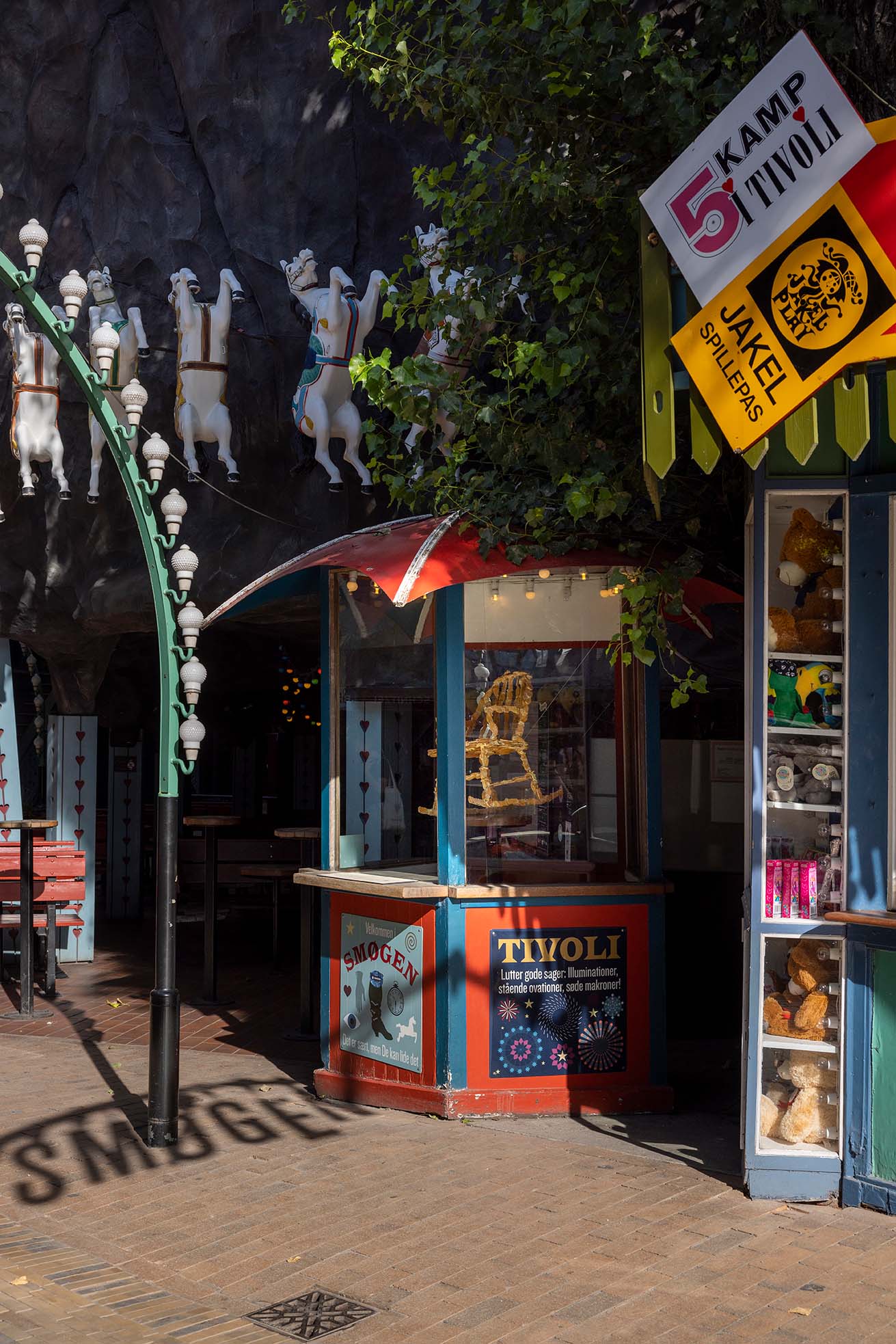
Attachments, 2021. Hand-painted Jesmonite, silicone, hot-melt glue, epoxy, varnish.
Courtesy the artist & Lagune Ouest, Copenhagen and CHART in Tivoli 2022. Photo: Jan Søndergaard

Attachments, 2021. Hand-painted Jesmonite, silicone, hot-melt glue, epoxy, varnish.
Courtesy the artist & Lagune Ouest, Copenhagen and CHART in Tivoli 2022. Photo: Jan Søndergaard

Attachments, 2021. Hand-painted Jesmonite, silicone, hot-melt glue, epoxy, varnish.
Courtesy the artist & Lagune Ouest, Copenhagen and CHART in Tivoli 2022. Photo: Jan Søndergaard

Attachments, 2021. Hand-painted Jesmonite, silicone, hot-melt glue, epoxy, varnish.
Courtesy the artist & Lagune Ouest, Copenhagen and CHART in Tivoli 2022. Photo: Jan Søndergaard
Group exhibition
Chart Art Fair in Tivoli Gardens
25.08. - 25.09.2022
The exhibition will invite visitors to explore a series of new installations by 15 artists situated throughout the park, including site-specific sculptures and video projections, thereby expanding the traditional art fair format and encouraging new audiences to engage with contemporary art.
Opened in 1843, Tivoli Gardens is one of the oldest amusement parks in the world and a historic cultural landmark in the centre of Copenhagen. The exhibition will launch on 25 August to coincide with CHART and is set to run until 25 September.
---
Kåre Frang is a Danish artist who primarily works with sculpture. In his choice of materials and form, Frang is preoccupied with the stories, structures, and mechanisms that are attched to each of the things.
Frang has created a rocking chair sculpture placed in the small pavillion by the entrance to the Smøgen area of Tivoli, cast from biscuits, which he has painted and assembled with hot-melt glue, epoxy, and a butter-like silicone. The result is a both fragile and clumsy object with no practical use whatsoever, with a materiality and shape that recalls personal experiences and memories.
Kåre Frang (b. 1992) holds a MFA from The Royal Danish Academy of Fine Arts. He has been part of multiple Danish exhibitions, and is the recipient of the Anne Marie Carl-Nielsen Talent prize, 15. Juni Fonden Honorary Award, and Silkeborg Kunstnerlegat.
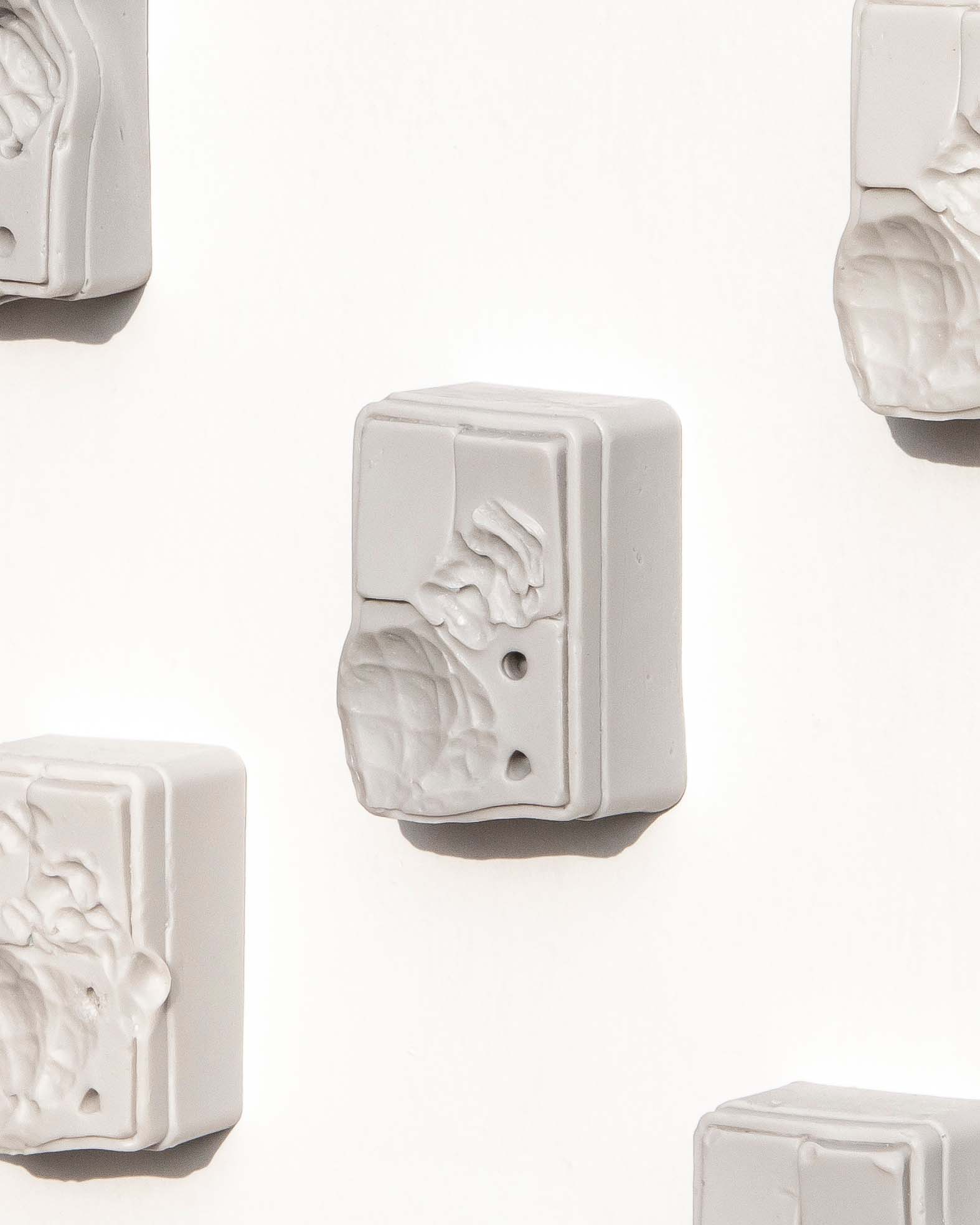
Loving Eyes. 2022. Plastic. Edition of 160. For Silkeborg Kunstnerlegat 2022.

Loving Eyes
Plastic
2022
Edition of 160
For Silkeborg Kunstnerlegat
Landscapes of Doubt: A Change of Plans
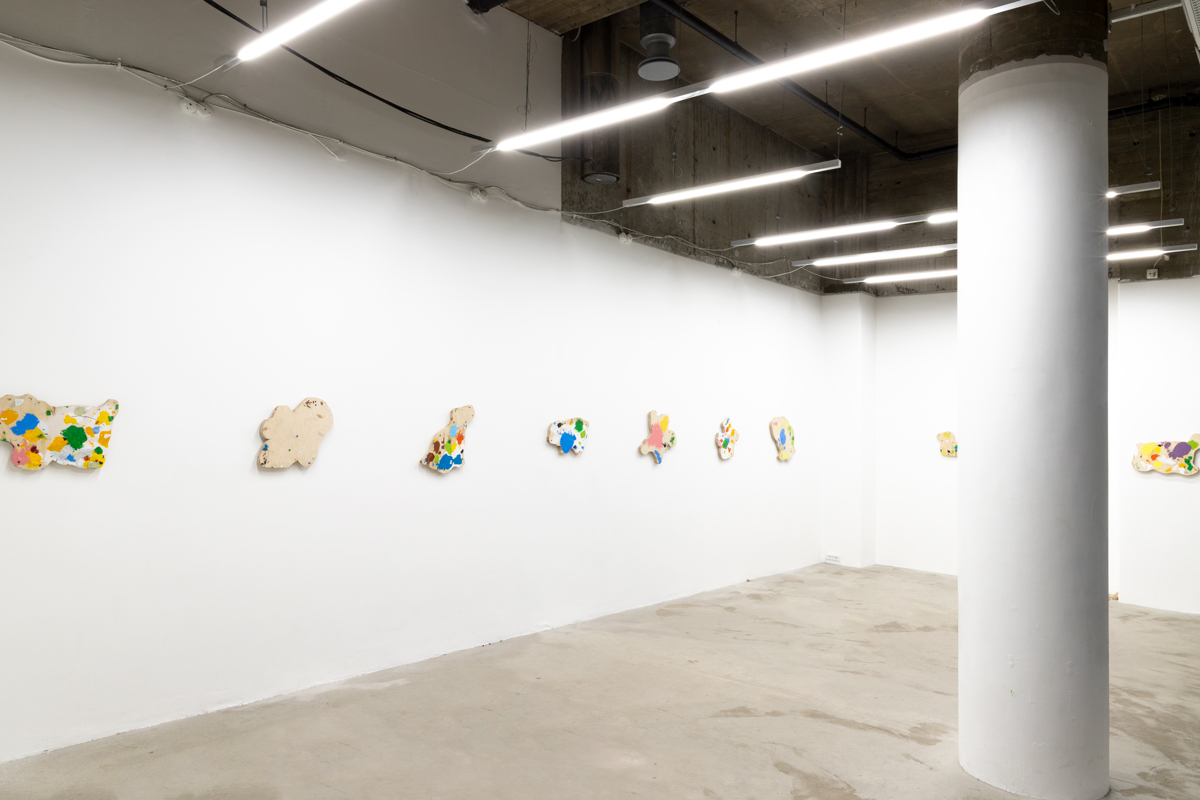
Inter.pblc
01.04. - 08.04.2022
"As the last week of the exhibition period approaches, Kåre Frang makes a change of plans. Not only does he extend the exhibition by one week, he adds a new layer to the key narrative of the exhibition; the vulnerable conditions of knowledge sharing and planning impacting a world built around the stability of the very same.
The wooden cut-outs from the larger works, initially simply considered a type of residue from the artistic proces, are embedded into the exhibition and installed as works in their own right This change of plans brings questions of artistic, social and political precarity to the forefront, making us not only (re)consider the autonomy of the artwork, but of the human existence."

Installation view
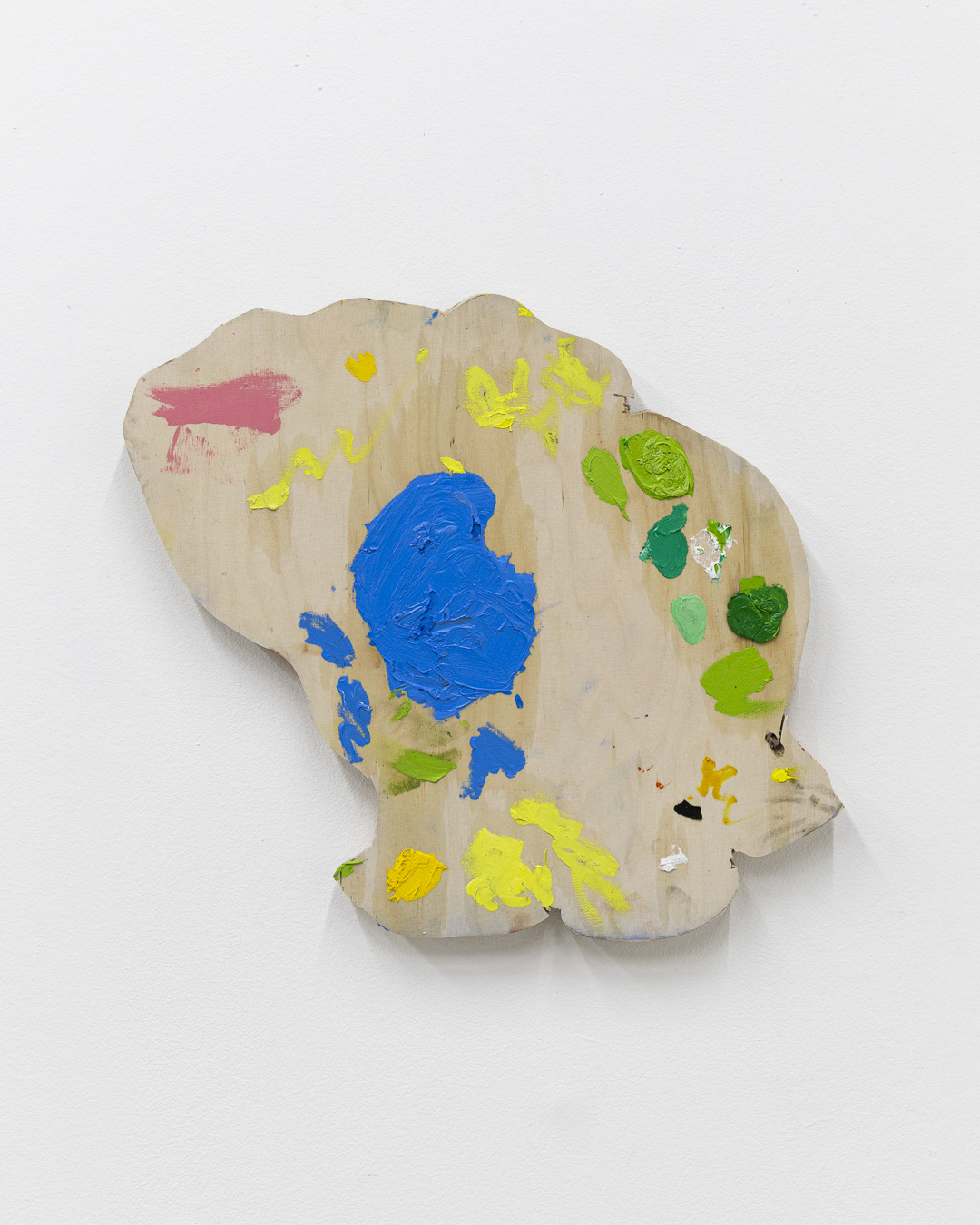
Landscapes of Doubt. 2022. Oil and gesso on birch plywood, thumbtacks, metal staples, clear tape, paper. 170 x 118 x 7,5 cm
Solo exhibition
Inter.pblc
01.04. - 08.04.2022
"As the last week of the exhibition period approaches, Kåre Frang makes a change of plans. Not only does he extend the exhibition by one week, he adds a new layer to the key narrative of the exhibition; the vulnerable conditions of knowledge sharing and planning impacting a world built around the stability of the very same.
The wooden cut-outs from the larger works, initially simply considered a type of residue from the artistic proces, are embedded into the exhibition and installed as works in their own right This change of plans brings questions of artistic, social and political precarity to the forefront, making us not only (re)consider the autonomy of the artwork, but of the human existence."
- Nanna Balslev Strøjer
Bake a Cake
Solo exhibition
M100
18.03. - 24.04.2022
Think about the way you take off your coat as you walk through the door. Imagine that it was instead the door that was taken off and lay there crumpled on the floor. What exhaustion has led to that? The door that in our everyday connects one room with another or separates outside from inside, is also an image of the threshold or transition between different spheres and states. But what if the door refused to maintain that function - collapsed and thereby left all times and spaces open simultaneously?
The pandemic's changes of social choreographies and most recently Russia's invasion of Ukraine have made it very clear how the spheres we normally move around in may quickly be replaced by other organizations of time and space. In a way, it becomes very tangible how time and space are connected - not only as described by physics - but also in the specific everyday experience that it feels as if time unfolds differently in different spaces and in the daily shifts between locations. And with the state of emergency in mind that people elsewhere live in, one might see one's own everyday life in a different light.
In Kåre Frang's exhibition Bake a Cake, three doors or rather the imprints of them lay collapsed around in the exhibition space. The light gray doors are castings of classic wooden doors, cast in a thin layer of oil-based modeling clay. In the folds where the mass is cracked, a reinforcing mesh appears, which reveals the inner skeleton holding together the molded shape of the door. The three doors are all provided with a handle cast in modeling wax painted with a thin layer of gold paint, spurring the idea that one could grab the door at that point and pull it up to the vertical position in which we normally encounter doors.
For the most part, we relate to the door through its function and condition: open or closed, locked or unlocked, but in Frang's works we are also made aware of the door as surface and shape. As studies of the scales of everyday objects and situations, Frang's sculptures are at once easily readable and more complex in their relation to everyday experiences. What imprints does the door carry from those who have passed through it?
With the exhibition Bake a Cake, the doors themselves become an imprint of and an expression of a state or event that is in the process of unfolding or has taken place. And with the three castings of the door turned inside out, the exhibition opens up for a reflection on the transitions, shifts and passages that the door can be seen as a picture of - this applies to both the specific doors we go in and out of, walk through, or which stop us and the doors we have never walked through. Considering the escalation of the war in Ukraine in the recent weeks, the doors are also a picture of how fragile the boundary between what we may call normality and a state of emergency can be: one day you go to work as usual, the next day you find yourself looking for shelter or on the run.
The formal study that Frang conducts is connected to considerations about how we perceive and register time and events in time. The title Bake a Cake is borrowed from old English railway slang, and it means to build up steam for the purpose of being able to accelerate. At the same time, it also carries the specific everyday meaning of baking a cake, something that is linked to a surplus of energy and quality time in the family. For busy families with young children, the ideal of baking a cake can in many ways feel as heavy a pressure as the pressure to deliver a work or a text or another product before a given deadline. Our private lives are not shielded from the demands of working life for productivity, efficiency and competition - unless we ourselves build and maintain protection against those logics.
The different experiences tap into discussions about our perception of time and what time is: a process that manifests itself through changes in conditions such as decay and weathering, a course of time units of a given measurement that can be detected by various mathematical formulas and technical measuring devices, which defines distances between before and after, or an experience of moments, intervals and spans of time that feels essentially different depending on the focus and inner state we are in. According to the French philosopher Henri Bergson, who is especially known for his thoughts on time as duration (durée) as opposed to a quantifiable time of infinitely divisible moments, the reality around us in constant change and the continuity of change is a premise for life. In Bergson's perspective, an attentive experience of reality involves listening to the deep humming of the movement of everything, rather than focusing on individual events or stages of a process.
But just as an awareness of continuity and duration is important, so is an attention to impacts and rhythms that mark differences and distinguish between one state and another. The door, for instance, marks a distinction between work and not work, home and away, being inside and outside, which also marks differences of quality and allows shifts in pace and activities. The rhythmic organization of events ensures against indifference, entropy. Although the door castings may slowly and imperceptibly, but continuously, move towards a splaying-out on the floor, they are right now in a state and process of change that may inspire us to consider the position of the doors in relation to our own: how the material and cultural or institutional rhythms align with the biological and social rhythms, as Henri Lefebvre points out in his rhythmanalysis (1992). The experience of the collapse of differences; feeling time flowing as water between one’s fingers either in an epiphanic moment of insight or as a complete implosion – is opposed to the attention to the many rhythms that constantly meet and which can be brought to either harmonize or collide.
Do you think about your breathing, your heartbeat when you walk in the door and take off your coat - maybe you pick up a collapsed snowsuit from the floor and feel the energy you use to pick things up again, yourself? Do you think what would have happened if you had done things differently, had walked through that door instead of another? Try for a moment to just pause at this threshold.
Text by Anne Kølbæk Iversen Dansk version
Solo exhibition
M100
18.03. - 24.04.2022
Think about the way you take off your coat as you walk through the door. Imagine that it was instead the door that was taken off and lay there crumpled on the floor. What exhaustion has led to that? The door that in our everyday connects one room with another or separates outside from inside, is also an image of the threshold or transition between different spheres and states. But what if the door refused to maintain that function - collapsed and thereby left all times and spaces open simultaneously?
The pandemic's changes of social choreographies and most recently Russia's invasion of Ukraine have made it very clear how the spheres we normally move around in may quickly be replaced by other organizations of time and space. In a way, it becomes very tangible how time and space are connected - not only as described by physics - but also in the specific everyday experience that it feels as if time unfolds differently in different spaces and in the daily shifts between locations. And with the state of emergency in mind that people elsewhere live in, one might see one's own everyday life in a different light.
In Kåre Frang's exhibition Bake a Cake, three doors or rather the imprints of them lay collapsed around in the exhibition space. The light gray doors are castings of classic wooden doors, cast in a thin layer of oil-based modeling clay. In the folds where the mass is cracked, a reinforcing mesh appears, which reveals the inner skeleton holding together the molded shape of the door. The three doors are all provided with a handle cast in modeling wax painted with a thin layer of gold paint, spurring the idea that one could grab the door at that point and pull it up to the vertical position in which we normally encounter doors.
For the most part, we relate to the door through its function and condition: open or closed, locked or unlocked, but in Frang's works we are also made aware of the door as surface and shape. As studies of the scales of everyday objects and situations, Frang's sculptures are at once easily readable and more complex in their relation to everyday experiences. What imprints does the door carry from those who have passed through it?
With the exhibition Bake a Cake, the doors themselves become an imprint of and an expression of a state or event that is in the process of unfolding or has taken place. And with the three castings of the door turned inside out, the exhibition opens up for a reflection on the transitions, shifts and passages that the door can be seen as a picture of - this applies to both the specific doors we go in and out of, walk through, or which stop us and the doors we have never walked through. Considering the escalation of the war in Ukraine in the recent weeks, the doors are also a picture of how fragile the boundary between what we may call normality and a state of emergency can be: one day you go to work as usual, the next day you find yourself looking for shelter or on the run.
The formal study that Frang conducts is connected to considerations about how we perceive and register time and events in time. The title Bake a Cake is borrowed from old English railway slang, and it means to build up steam for the purpose of being able to accelerate. At the same time, it also carries the specific everyday meaning of baking a cake, something that is linked to a surplus of energy and quality time in the family. For busy families with young children, the ideal of baking a cake can in many ways feel as heavy a pressure as the pressure to deliver a work or a text or another product before a given deadline. Our private lives are not shielded from the demands of working life for productivity, efficiency and competition - unless we ourselves build and maintain protection against those logics.
The different experiences tap into discussions about our perception of time and what time is: a process that manifests itself through changes in conditions such as decay and weathering, a course of time units of a given measurement that can be detected by various mathematical formulas and technical measuring devices, which defines distances between before and after, or an experience of moments, intervals and spans of time that feels essentially different depending on the focus and inner state we are in. According to the French philosopher Henri Bergson, who is especially known for his thoughts on time as duration (durée) as opposed to a quantifiable time of infinitely divisible moments, the reality around us in constant change and the continuity of change is a premise for life. In Bergson's perspective, an attentive experience of reality involves listening to the deep humming of the movement of everything, rather than focusing on individual events or stages of a process.
But just as an awareness of continuity and duration is important, so is an attention to impacts and rhythms that mark differences and distinguish between one state and another. The door, for instance, marks a distinction between work and not work, home and away, being inside and outside, which also marks differences of quality and allows shifts in pace and activities. The rhythmic organization of events ensures against indifference, entropy. Although the door castings may slowly and imperceptibly, but continuously, move towards a splaying-out on the floor, they are right now in a state and process of change that may inspire us to consider the position of the doors in relation to our own: how the material and cultural or institutional rhythms align with the biological and social rhythms, as Henri Lefebvre points out in his rhythmanalysis (1992). The experience of the collapse of differences; feeling time flowing as water between one’s fingers either in an epiphanic moment of insight or as a complete implosion – is opposed to the attention to the many rhythms that constantly meet and which can be brought to either harmonize or collide.
Do you think about your breathing, your heartbeat when you walk in the door and take off your coat - maybe you pick up a collapsed snowsuit from the floor and feel the energy you use to pick things up again, yourself? Do you think what would have happened if you had done things differently, had walked through that door instead of another? Try for a moment to just pause at this threshold.
Text by Anne Kølbæk Iversen
Dansk version
Landscapes of Doubt
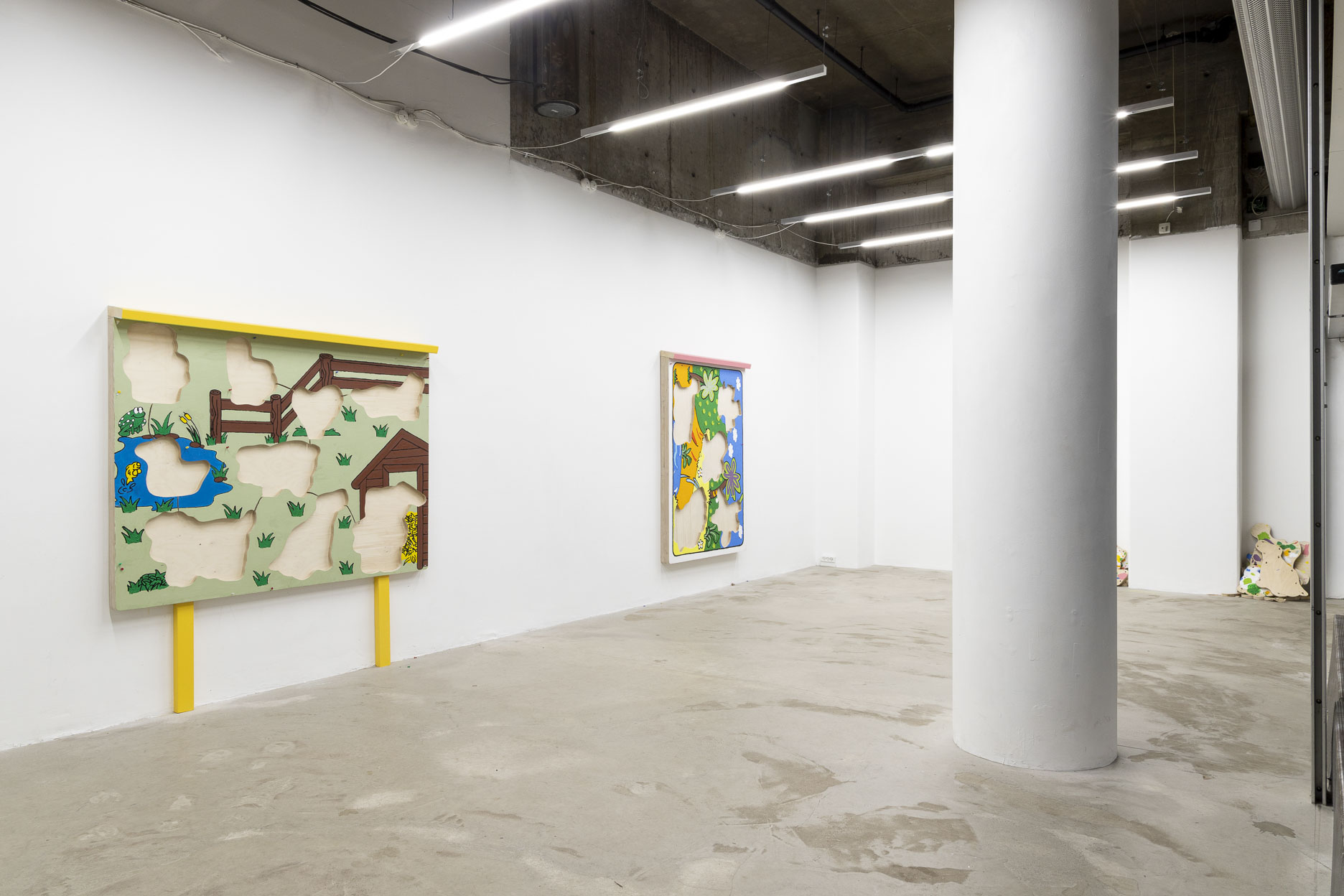
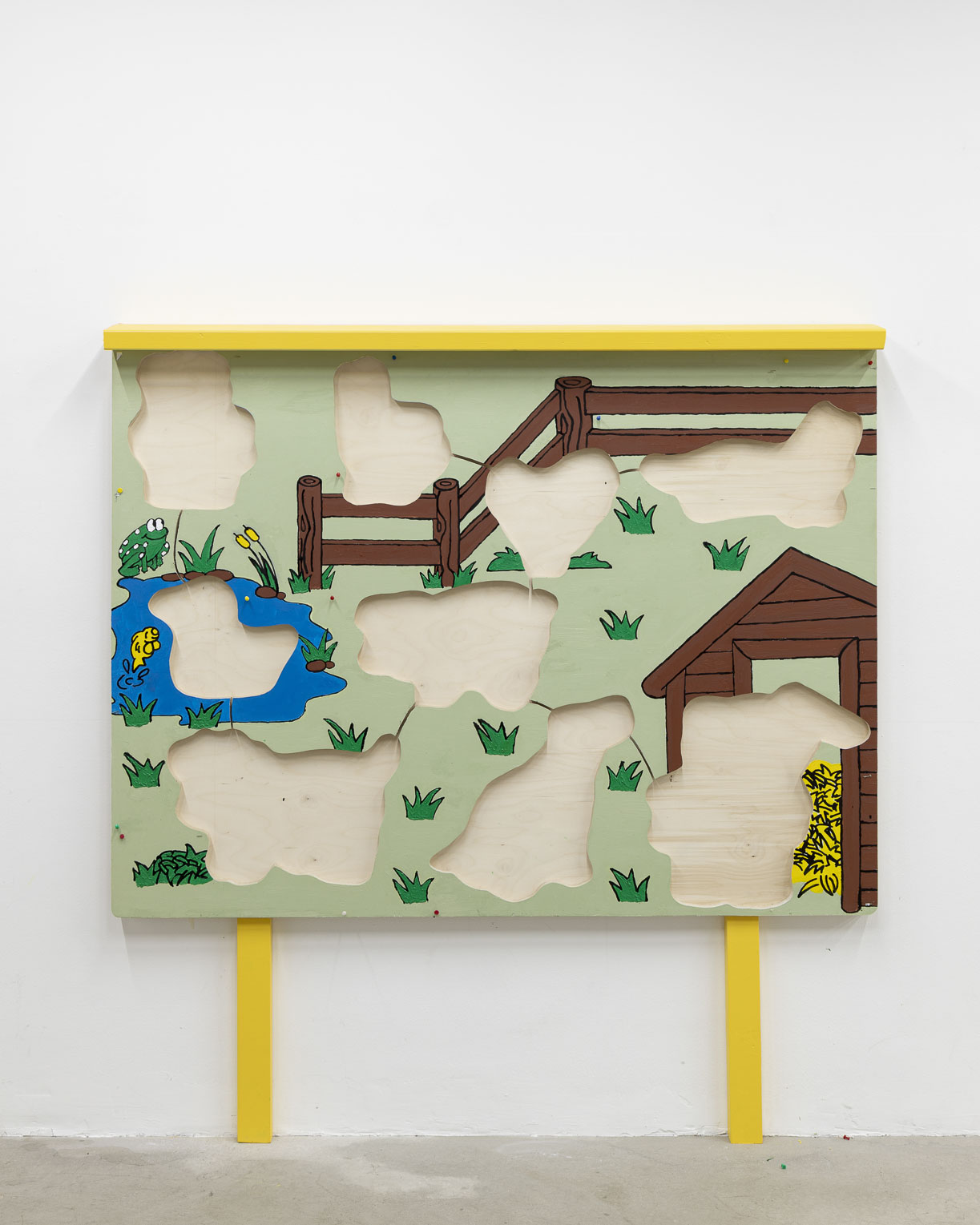
Landscapes of Doubt. 2022. Oil and gesso on birch plywood, thumbtacks, metal staples, clear tape, paper.


Landscapes of Doubt. 2022. Oil and gesso on birch plywood, thumbtacks, metal staples, clear tape, paper. 170 x 118 x 7,5 cm

Solo exhibition
Inter.pblc
11.03. - 01.04.2022
In a worn-down Frederiksberg basement situated about a hundred meters from the lakes in Copenhagen, artist Kåre Frang holds up a wooden baby puzzle against the wall. The small puzzle is one of two puzzles which together creates the basis for the artistic inspiration for the exhibition Landscapes of Doubt at Inter.pblc. Kåre is in the process of recreating the puzzles in an upscaled version, cutting and glueing together the wood, the piles of birch plywood making us reminisce about the furniture and play houses from our childhood institutions.
Measuring about 170 x 120 cm the works are almost human-scale, placing themselves between formal aesthetic categories; contemporary sculpture, traditional landscape painting and Sixties’ pop art. Similar to the baby puzzles (that Kåre has collected for years), the pieces of the puzzles are missing, leaving large contoured gaps in the caricatured landscape of the farm and jungle tableaux. More than the symbolic act of showcasing an incomplete puzzle, the size, the artistic refinement (notice the im-pasto of the oil paint) and most importantly the resemblance to information boards, complete with drip cap, pins and traces from stablers, the works become multi-layered narratives talking about the pre-carity of the world, about our distorted relation to information and planning (especially in a post-covid context) - and not least about the phenomenology of, not only, the aesthetic experience, but of the hu-man experience; how we meet, perceive and navigate in the world.
Gazing upon Landscapes of Doubt, the way in which we introduce the world to children, and thereby reproduce norms and control actions, reveals itself. The elasticity of, and interconnections between, body, space, time, memory and fantasy are unveiled and it becomes clear that Landscapes of Doubt is just as much about what is there as it is about what is not. About the absence and frailty of things, about what is lost or still yet to come. Is this the landscape of the future - an excavated scenery where the void itself is our only witness of the past? Kåre draws on references to classical landscape painting, where nature becomes both autonomous in its own right as well as a symbolic repository of human cul-tural and political evolution, and the works thereby transcend themselves and point directly to what they are; landscapes of doubt.
The wood-cuts from the puzzle, representing what is now the negative space on the works’ surface, lay on the studio floor used as palets for the paint, underlining that even in the chaos of things, everything is tied together - connected even if brittle. It is late in the day and we need to say goodbye in order for Kåre to finish his work, including producing news works for another solo exhibition also opening in March. The parallel to the precarity of the artists’ existence is striking and it becomes almost symbolic when we both loose balance on the ramp outside his studio, as we hug each other goodbye.
Nanna Balslev Strøjer
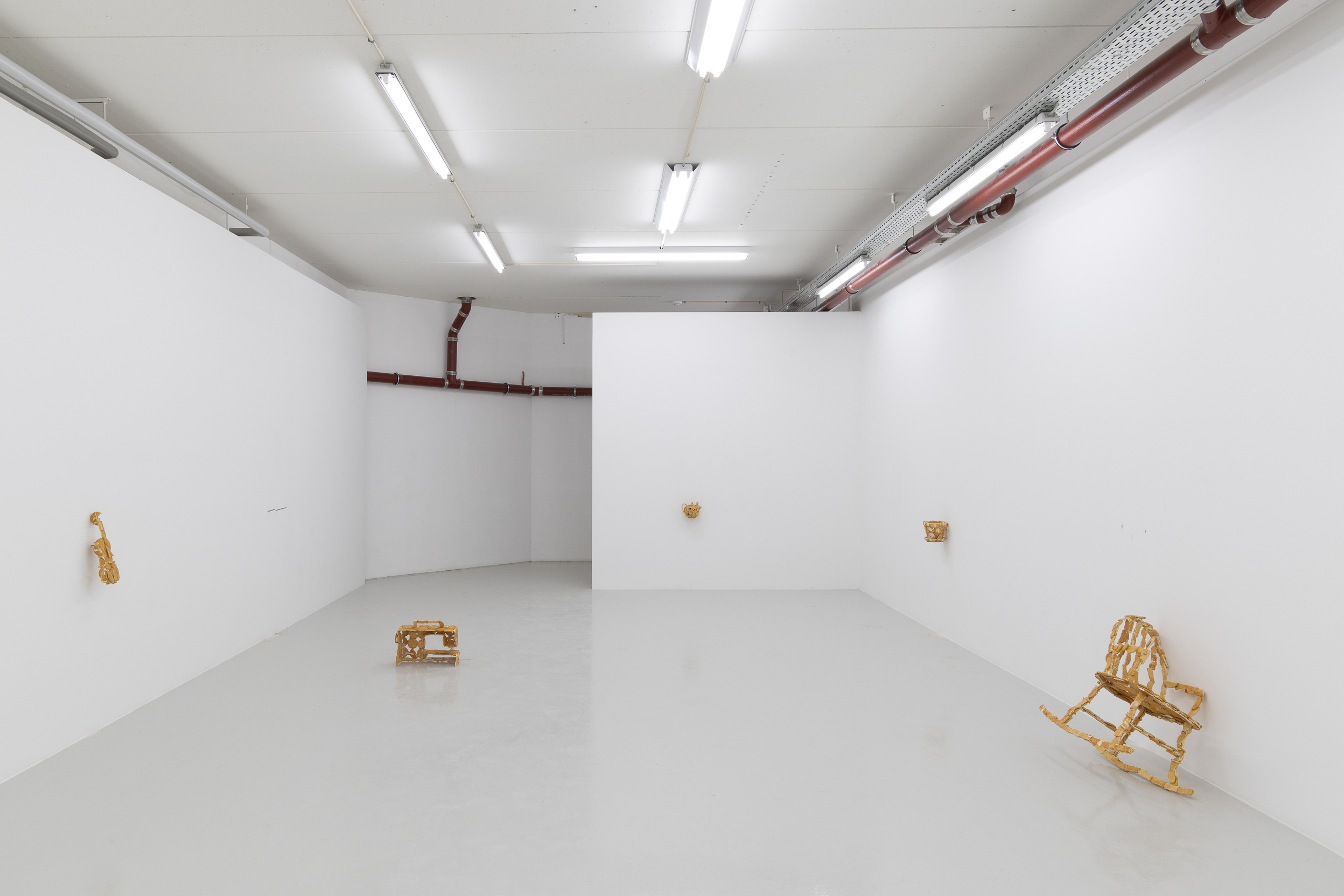
Solo exhibition at Lagune Ouest
Opening the 26th of November 2021
Exhibition will run through January 8th 2022
Start på videresendt besked:
Fra: Tone Bonnen <tonebonnen@hotmail.com>
Dato: 11. november 2021 kl. 15.48.45 CET
Til: email@kaarefrang.eu
Emne: Attachments
Dear Kåre,Thank you for showing me the works you are in the process of making for your upcoming exhibition. Ever since you sent me the pictures and shared your thoughts behind this new series of works, I have been thinking about the biscuit sculptures, trying to imagine the situation in which they came into existence. This new body of work has made me think a lot about your overall practice as an artist as well as your role as a father and the masculinity ideal you represent by merging these two roles in a public exhibition in a gallery space.
You explained that the works for this exhibition are informed by your deeply rooted interest in how people relate and attach to things, more specifically the notion of ownership; how this creates a powerful affiliation between object and human and how ownership in itself transforms any given object into something precious, identity-creating and somehow irreplaceable. I understand why this phenomenon resonates in your thinking about your practice within a commercial art context. And it also makes sense in relation to the creative and intimate situation you share with your child in your studio, where the two of you are trying to make sense of the world by creating small sculptures replicating various objects from the surroundings out of sweet biscuits. When you remake an object in another material, you transfer the characteristics of the given object to the new construction, and at the same time enhance the qualities of the original object in the new sculptures. By doing so you somehow prove that co-creation is a stronger force than ownership in terms of adding value to things as well as you draw attention to the power and significance of art as such.
Despite the beautiful result of your final sculptures in cast Jesmonite “biscuits” with random bits of silicone ”butter”, I cannot help but thinking about the studio process. I imagine you and your child with stacks of Digestive biscuits and butter and think about the conversations you probably have had about what to build. I imagine a lot of failed attempts and cracked biscuits all over the place and recall an impactful scene from the 1990’sfeature film Pain of Love by Danish director Nils Malmros. In this scene the main character played by Anne Louise Hassing is preparing for her final exams as an art teacher. She is sitting by herself in a classroom struggling with gluing straws onto a piece of cardboard, attempting to make a collage depicting a scenic landscape. However, the more glue she adds to the collage the more the straws and glue stick to her fingers and the more she cries, letting the tears run down her cheeks further ruining the failed collage. The scene predicts her imminent mental collapse and everything about the situation is as sad as it gets. However, your fragile yet clumsy and awkwardly constructed sculptures reveal strength - not a sense of failure. The carefully executed sculptures balance between mess and precision revealing an acceptance and appreciation of both chaos and fragility as equally crucial components of the sensibility that reigns within your artistic practice.
If appreciation and value of things are defined by whether we can claim ownership or not, then the delicate and precious artworks that you made as a transformation of things that you own or appreciate, would not be irreplaceable until purchased by new owners. However, as fragile and vulnerable expressions of sensitivity rather than material manifestations, the sculptures become irreplaceable and entirely liberated from their status as mere ‘things’, which oblige ownership. Nevertheless, I cannot stop dreaming about owning one of your biscuit sculptures, only to let myself be inspired on a daily basis to regard the world with the same accepting, loving gaze as your work so insistently prompts.
Warm regards,
Tone
LOVING EYES
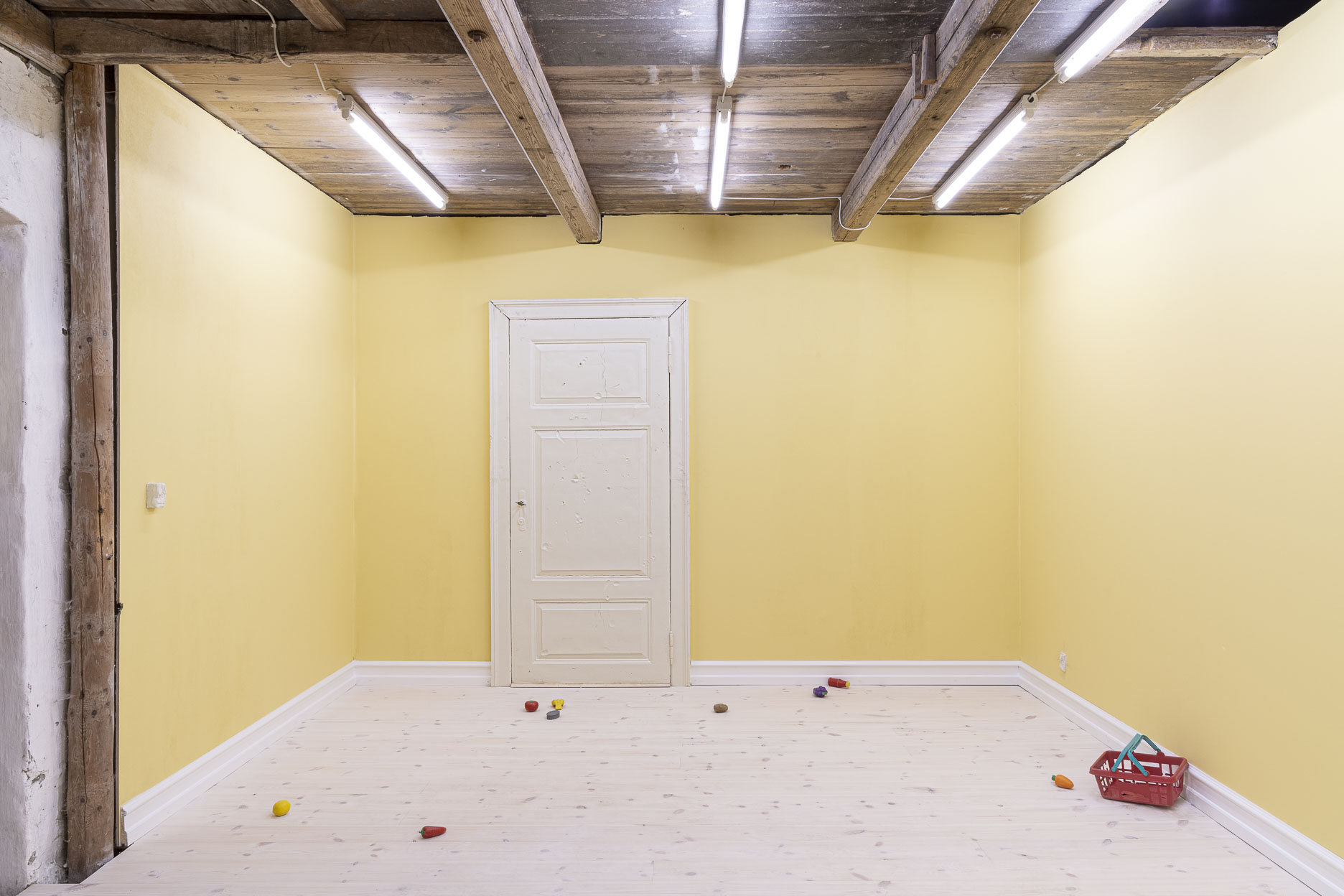
Solo exhibition
Kunsthal 44Møen
05.06.- 05.09.2021
Bronze, paint, non-hardening modeling clay, lye and soap treated wooden floor, baseboards, painted walls, LED-lights
Kunsthal 44Møen is proud to present Loving Eyes, an installation specifically created by Kåre Frang (1992) for the Kunsthal’s old smithy. Loving Eyes is shaped by the artist's fascination with the fragility of everyday life and its different structures. The installation is composed of seemingly familiar homely features such as ochre-colored walls, wooden floors, classic wooden doors, baseboards and light switches. A set of plastic fruit and vegetable toys is scattered on the floor, completing the image of a domestic environment, the expected backdrop of an everyday life scene. But what’s the weight of maintaining daily life?
A closer look reveals that most elements in the room are not made of their traditional materials: toys, which we expect to be hollow plastic shells, are here cast in solid bronze; hard wooden doors are replaced by soft oil-based modeling clay. This shift disrupts expectations between objects and their materiality and weight, generating an eerie discomfort marked by feelings of uncertainty and uneasiness. What if these feelings could leave an imprint on their surroundings?
Beyond a homely scene, the image of “groceries” on the floor also points towards a historical context of discontentment. For example, when audiences used to throw fruits and vegetables at actors on stage or politicians at rallies. A similar frustration is connected with a child throwing objects towards the adults in a more familiar setting: raging gestures that signal feelings of powerlessness and misunderstanding.
In Loving Eyes, toys are dangerously heavy. As such, their impact on their surroundings becomes amplified to the point of potentially altering them. Throughout the exhibition´s period, the work will unfold in the encounter between the visitors and the carefully crafted elements of this staged room. The environment will slowly start to bear the marks of these physical meetings between the different objects composing it.
By simply altering the weight of its elements, Loving Eyes reveals the fragility and vulnerability of any expectation towards a stable order in our individual lives, our society’s institutions and their power structures. Realizing the fragility of the order we live in has been very present lately, especially considering the unpredictable impact that the pandemic has had in our individual lives and societies. These are urgent realizations because only by knowing the system’s frailty can we believe in its possibility of change and be awakened in the understanding that individual choices can impact a larger system.
Text by Julia Rodrigues.
Loving Eyes was supported by
Statens Kunstfond, Det Obelske Familiefond, Vordingborg Kommune
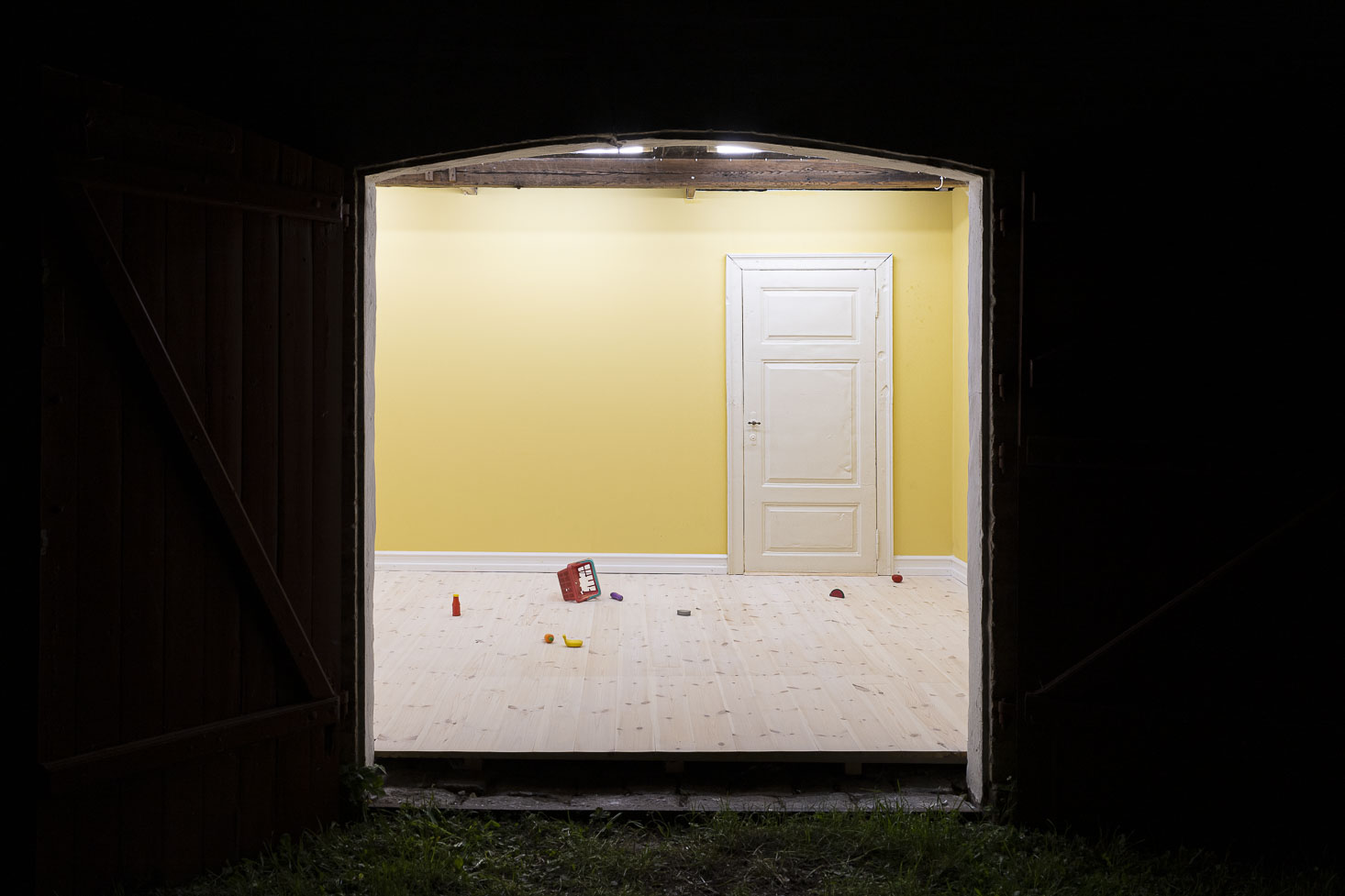 Loving Eyes. 2021. Handpainted bronze, non-hardening modeling clay, lye and soap treated wooden floor, baseboards, painted walls, LED-lights
Loving Eyes. 2021. Handpainted bronze, non-hardening modeling clay, lye and soap treated wooden floor, baseboards, painted walls, LED-lights
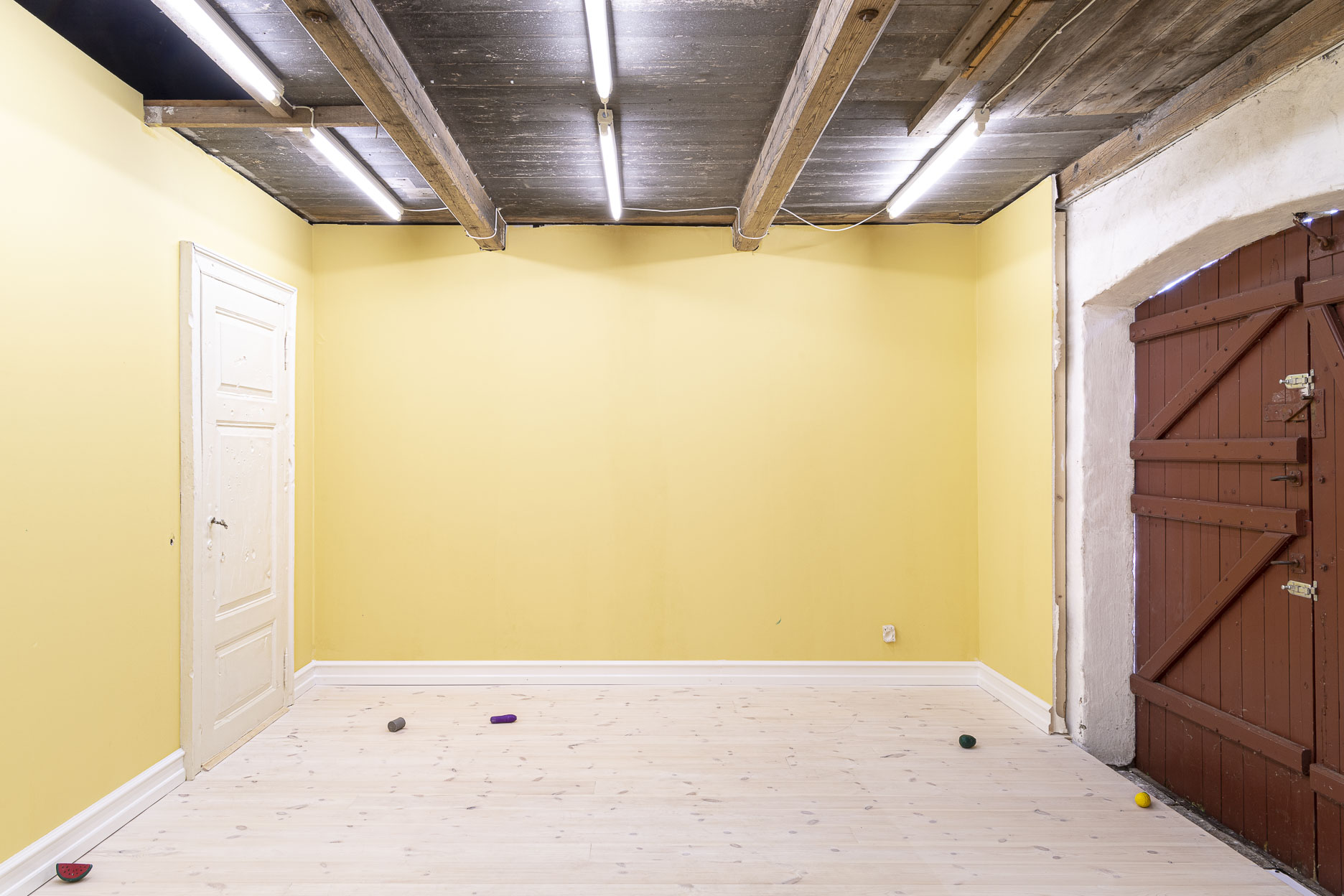 Loving Eyes. 2021. Handpainted bronze, non-hardening modeling clay, lye and soap treated wooden floor, baseboards, painted walls, LED-lights
Loving Eyes. 2021. Handpainted bronze, non-hardening modeling clay, lye and soap treated wooden floor, baseboards, painted walls, LED-lights Loving Eyes. 2021. Handpainted bronze, non-hardening modeling clay, lye and soap treated wooden floor, baseboards, painted walls, LED-lights
Loving Eyes. 2021. Handpainted bronze, non-hardening modeling clay, lye and soap treated wooden floor, baseboards, painted walls, LED-lights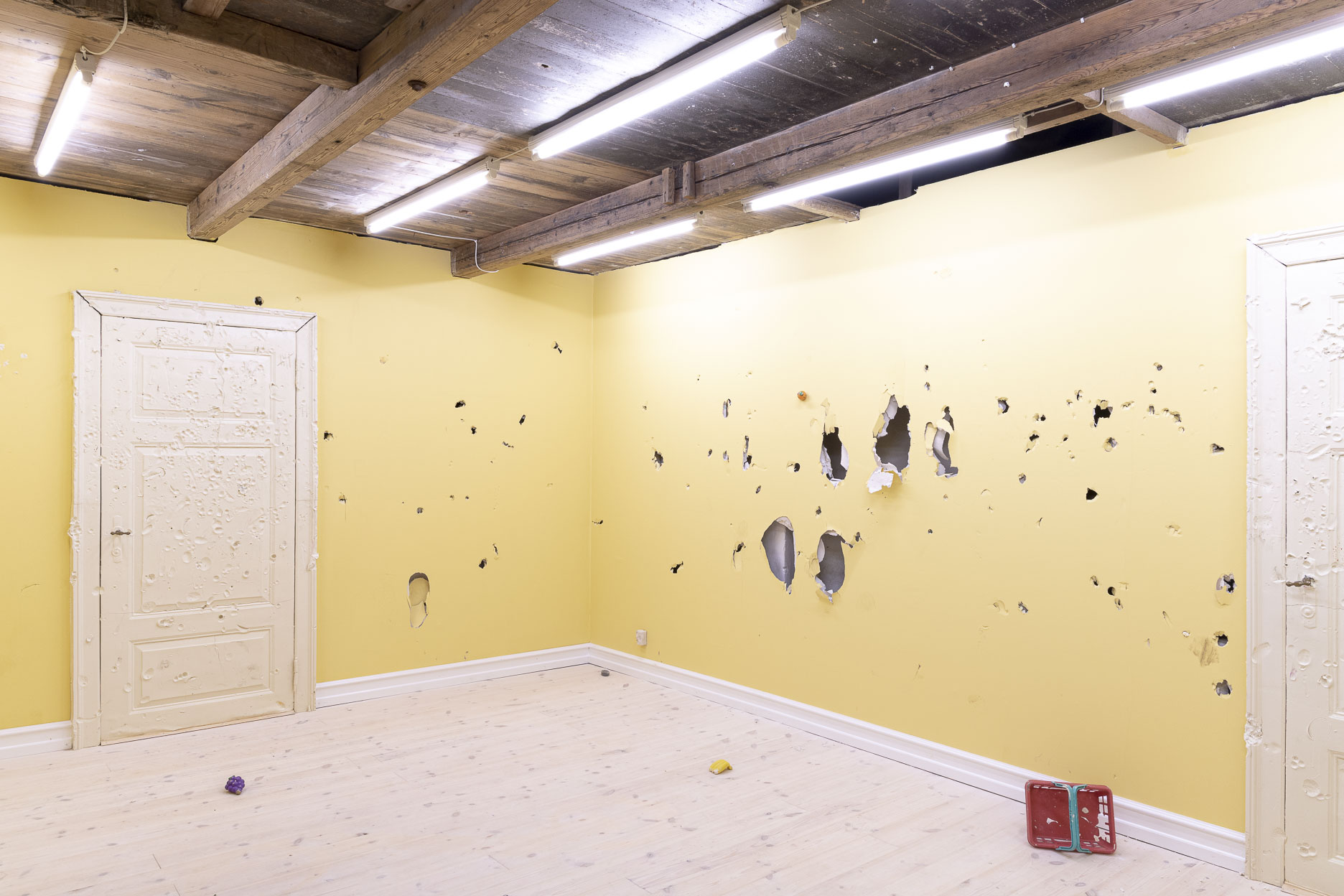 Loving Eyes. 2021. Handpainted bronze, non-hardening modeling clay, lye and soap treated wooden floor, baseboards, painted walls, LED-lights
Loving Eyes. 2021. Handpainted bronze, non-hardening modeling clay, lye and soap treated wooden floor, baseboards, painted walls, LED-lights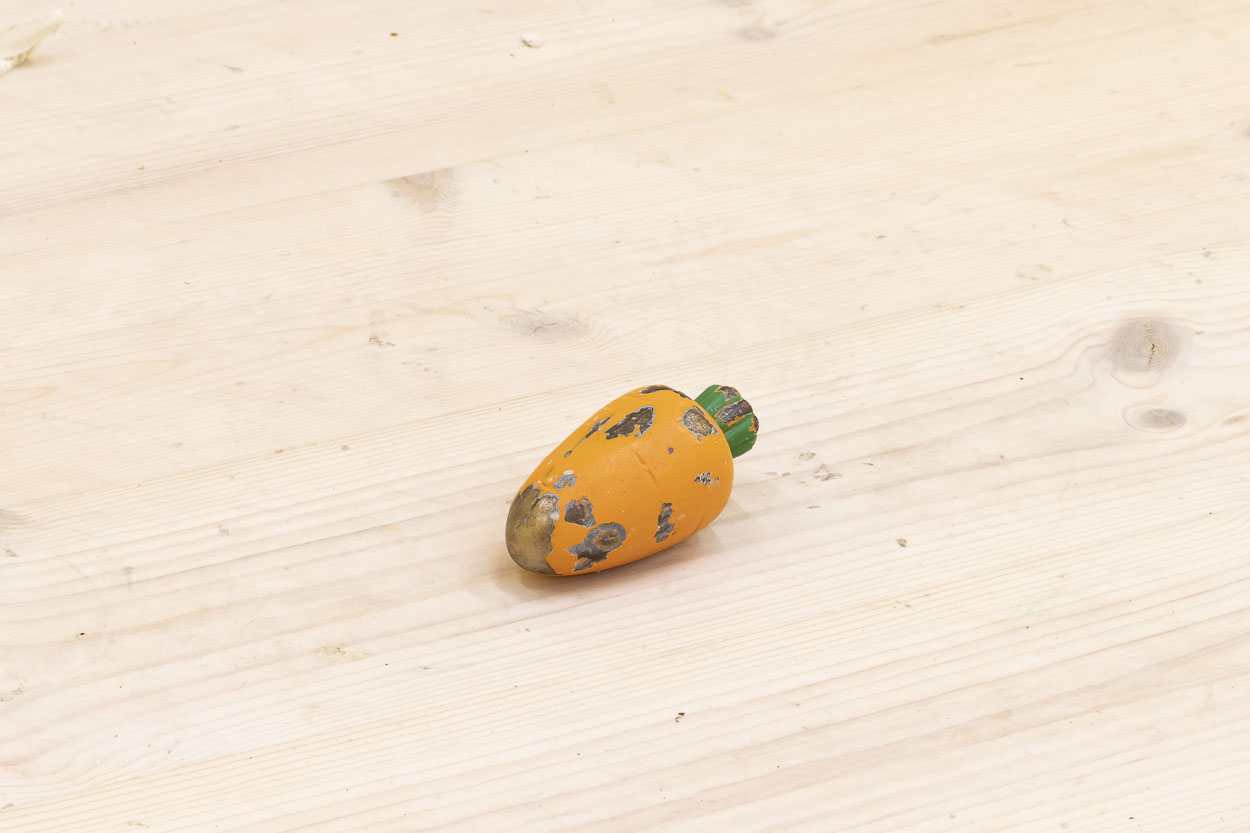 Loving Eyes. 2021. Handpainted bronze, non-hardening modeling clay, lye and soap treated wooden floor, baseboards, painted walls, LED-lights
Loving Eyes. 2021. Handpainted bronze, non-hardening modeling clay, lye and soap treated wooden floor, baseboards, painted walls, LED-lightsView full documentation here
Solo exhibition
Kunsthal 44Møen
05.06.- 05.09.2021
Kunsthal 44Møen is proud to present Loving Eyes, an installation specifically created by Kåre Frang (1992) for the Kunsthal’s old smithy. Loving Eyes is shaped by the artist's fascination with the fragility of everyday life and its different structures. The installation is composed of seemingly familiar homely features such as ochre-colored walls, wooden floors, classic wooden doors, baseboards and light switches. A set of plastic fruit and vegetable toys is scattered on the floor, completing the image of a domestic environment, the expected backdrop of an everyday life scene. But what’s the weight of maintaining daily life?
A closer look reveals that most elements in the room are not made of their traditional materials: toys, which we expect to be hollow plastic shells, are here cast in solid bronze; hard wooden doors are replaced by soft oil-based modeling clay. This shift disrupts expectations between objects and their materiality and weight, generating an eerie discomfort marked by feelings of uncertainty and uneasiness. What if these feelings could leave an imprint on their surroundings?
Beyond a homely scene, the image of “groceries” on the floor also points towards a historical context of discontentment. For example, when audiences used to throw fruits and vegetables at actors on stage or politicians at rallies. A similar frustration is connected with a child throwing objects towards the adults in a more familiar setting: raging gestures that signal feelings of powerlessness and misunderstanding.
In Loving Eyes, toys are dangerously heavy. As such, their impact on their surroundings becomes amplified to the point of potentially altering them. Throughout the exhibition´s period, the work will unfold in the encounter between the visitors and the carefully crafted elements of this staged room. The environment will slowly start to bear the marks of these physical meetings between the different objects composing it.
By simply altering the weight of its elements, Loving Eyes reveals the fragility and vulnerability of any expectation towards a stable order in our individual lives, our society’s institutions and their power structures. Realizing the fragility of the order we live in has been very present lately, especially considering the unpredictable impact that the pandemic has had in our individual lives and societies. These are urgent realizations because only by knowing the system’s frailty can we believe in its possibility of change and be awakened in the understanding that individual choices can impact a larger system.
Text by Julia Rodriguez.
Loving Eyes was supported by
Statens Kunstfond, Det Obelske Familiefond, Vordingborg Kommune
Life and Luck
Margarine sculpture, table, chairs, plate, breadcrums, cup, coffee, glass, water, laptop, newspaper, jug, butter knife
Kunsthal Kongegaarden
2021
Supported by
Statens Kunstfond and FDB Møbler
 Life and Luck. 2021. Margarine sculpture, table, chairs, plate, breadcrums, cup, coffee, glass, water, laptop, newspaper, jug, butter knife
Life and Luck. 2021. Margarine sculpture, table, chairs, plate, breadcrums, cup, coffee, glass, water, laptop, newspaper, jug, butter knife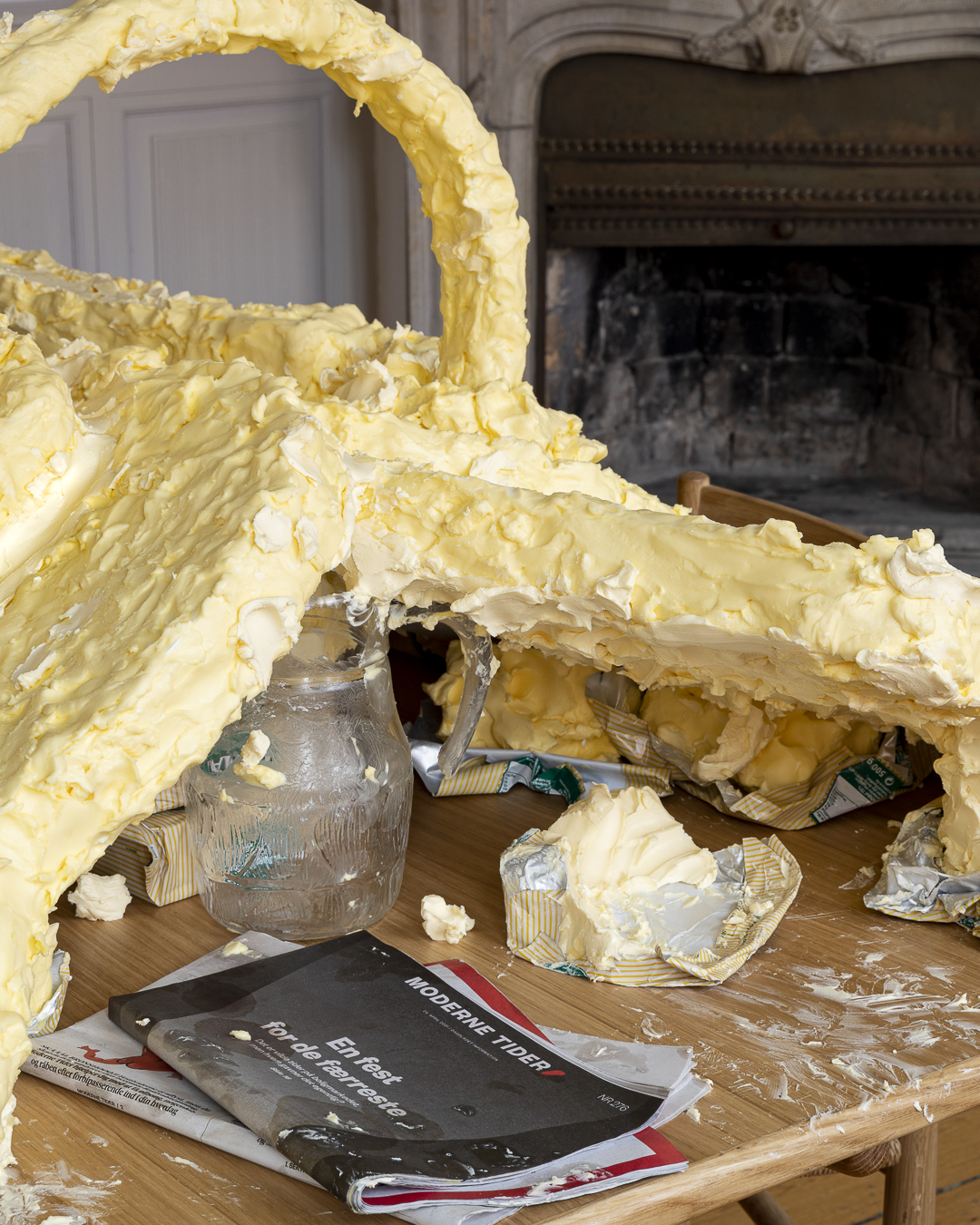 Life and Luck. 2021. Margarine sculpture, table, chairs, plate, breadcrums, cup, coffee, glass, water, laptop, newspaper, jug, butter knife
Life and Luck. 2021. Margarine sculpture, table, chairs, plate, breadcrums, cup, coffee, glass, water, laptop, newspaper, jug, butter knife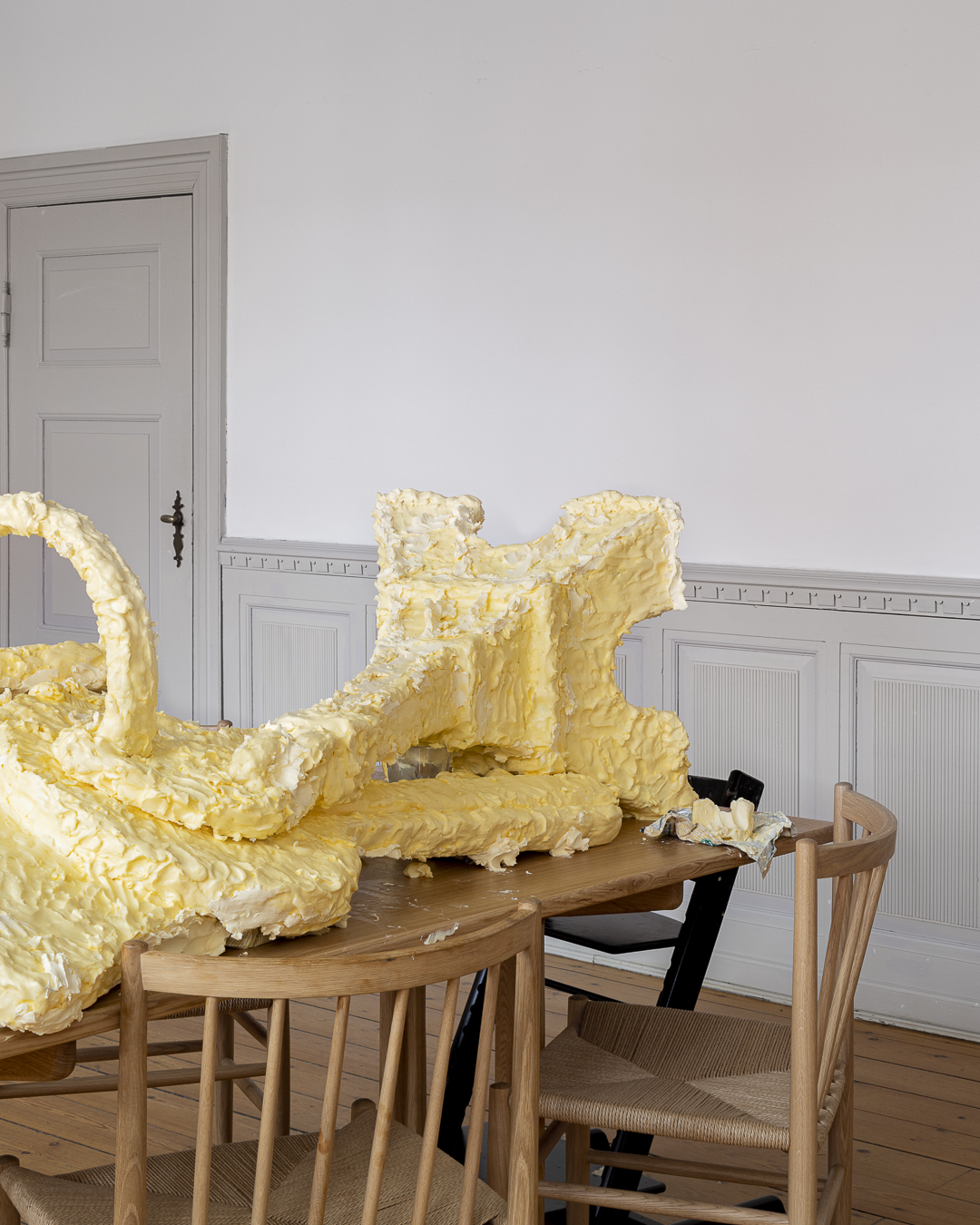 Life and Luck. 2021. Margarine sculpture, table, chairs, plate, breadcrums, cup, coffee, glass, water, laptop, newspaper, jug, butter knife
Life and Luck. 2021. Margarine sculpture, table, chairs, plate, breadcrums, cup, coffee, glass, water, laptop, newspaper, jug, butter knifeView full documentation here
Margarine sculpture, table, chairs, plate, breadcrums, cup, coffee, glass, water, laptop, newspaper, jug, butter knife
Kunsthal Kongegaarden
2021
Supported by
Statens Kunstfond and FDB Møbler
Burnt red clay, chamotte, pipe clay, copper oxide, manganese, iron oxide and transparent glaze
Slow-motion video, foley audio
Cast: Skjold Rambow
Foley design: Simon Formann
Colorgrade: Olesya Kireeva, ACT3
Kunsthal Charlottenborg
2020
Documentation: David Stjernholm
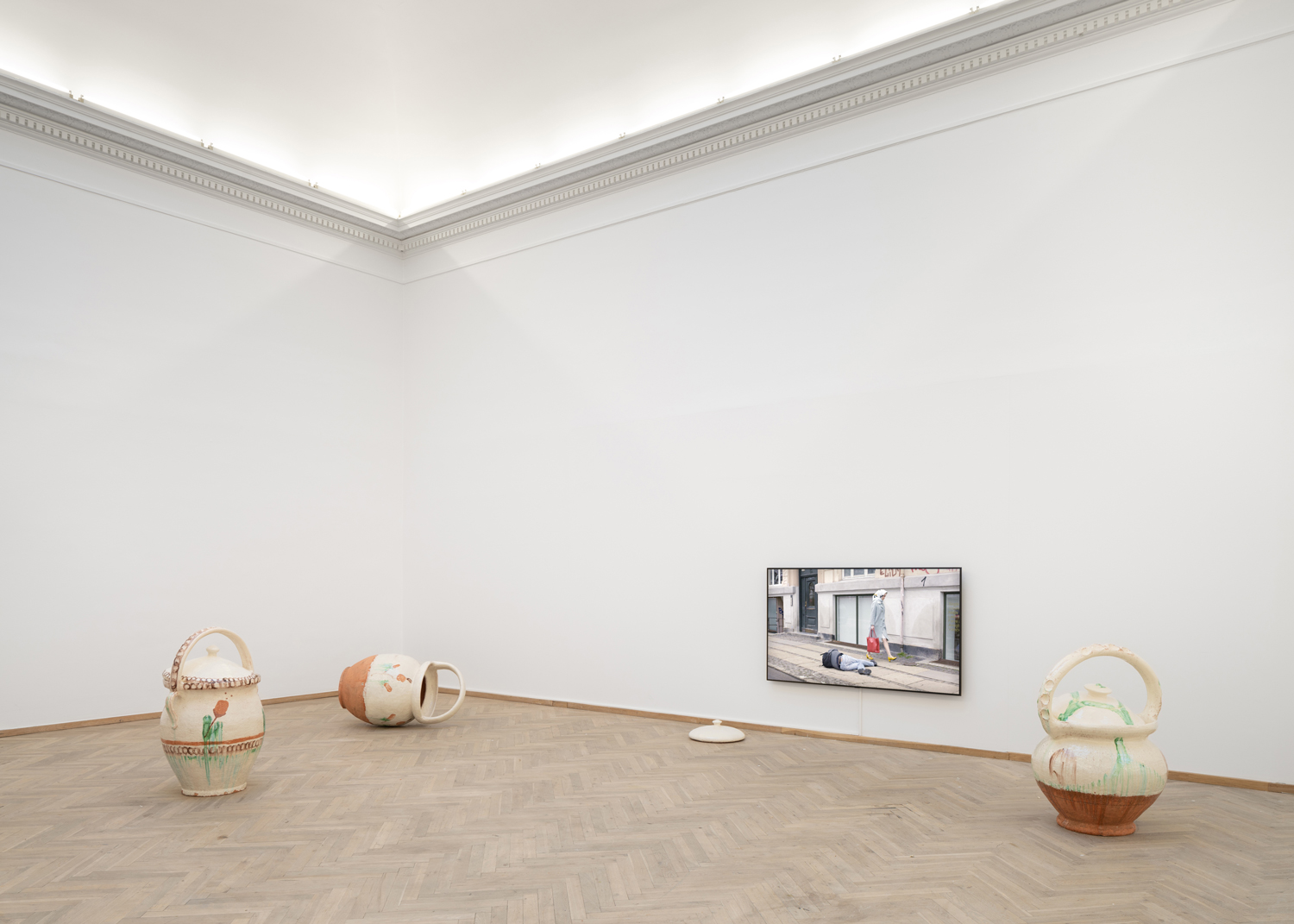 Changes. 2020. Burnt red clay, chamotte, pipe clay, copper oxide, manganese, iron oxide and transparent glaze
Changes. 2020. Burnt red clay, chamotte, pipe clay, copper oxide, manganese, iron oxide and transparent glaze 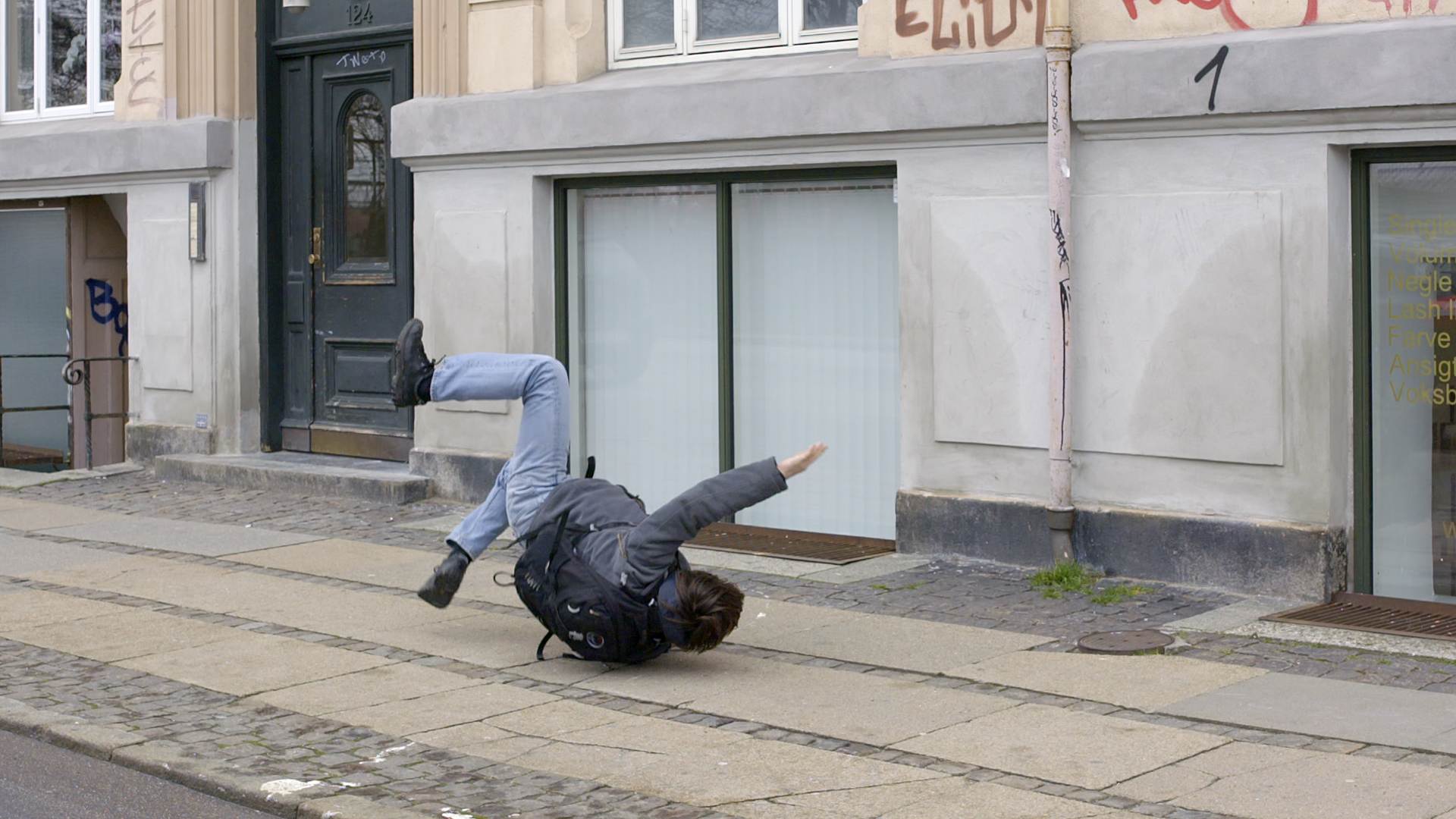 Changes. 2020. Slow-motion video, foley audio.
Changes. 2020. Slow-motion video, foley audio. Cast: Skjold Rambow, Foley design: Simon Formann, Colorgrade: Olesya Kireeva
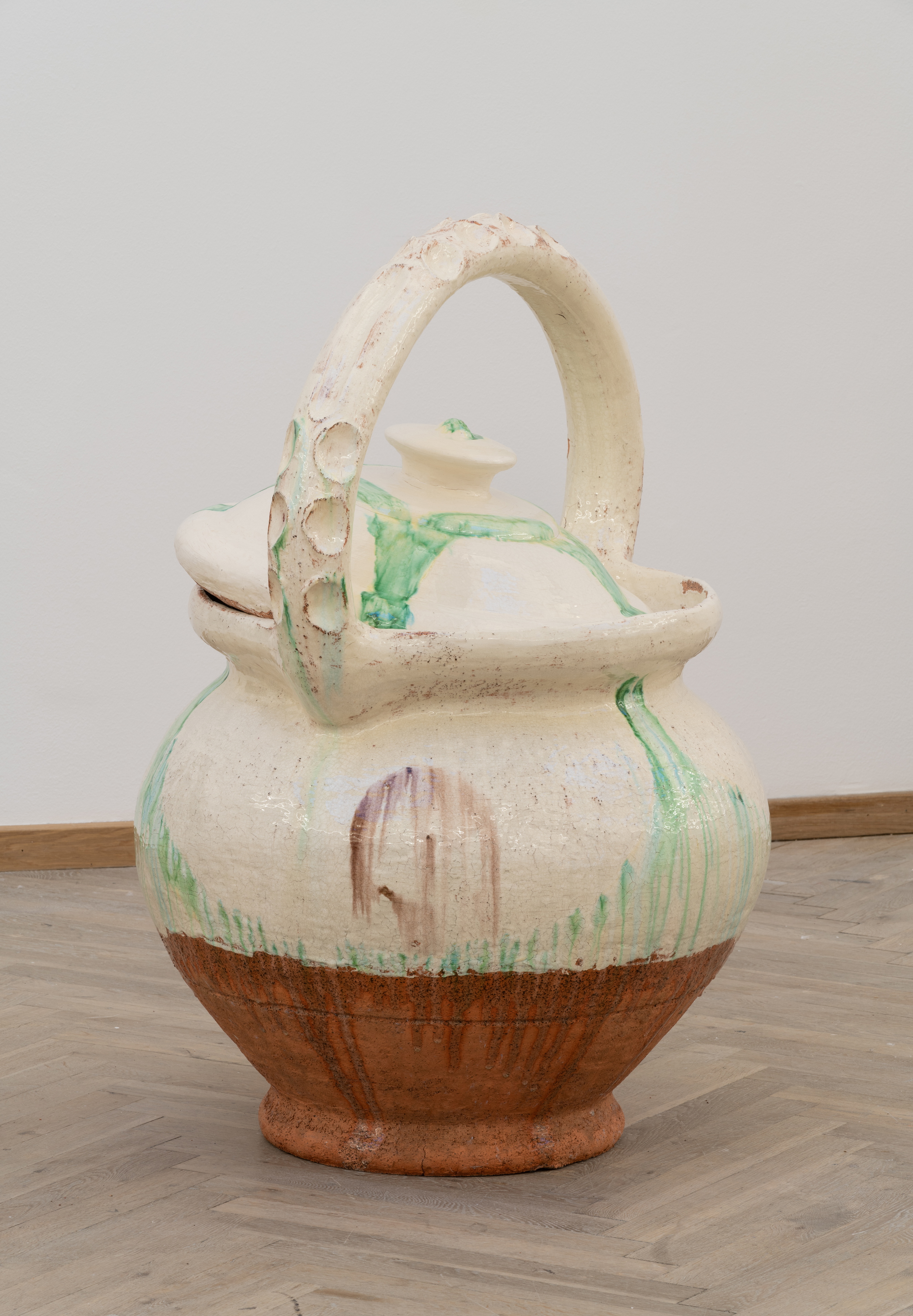 Changes. 2020. Burnt red clay, chamotte, pipe clay, copper oxide, manganese, iron oxide and transparent glaze
Changes. 2020. Burnt red clay, chamotte, pipe clay, copper oxide, manganese, iron oxide and transparent glaze View full documentation here
Burnt red clay, chamotte, pipe clay, copper oxide, manganese, iron oxide and transparent glaze
Slow-motion video, foley audio
Kunsthal Charlottenborg
2020
For Afgang, Frang exhibits a video work and three sculptures. In the video, a person repeatedly falls to the pavement in slow motion. Frang uses personal experiences as a springboard for exploring the fragility of life, as well as structures of support and care. The work is in dialogue with three large ceramic earthenware sculptures, all of which are upscaled versions of traditional maternity pots (barselspotter) from the 1800s. Maternity pots, known since the 16th century and up until the uprising of the welfare society, were used as containers for food gifted to women after giving birth from neighbors and the local society. This work starts a conversation about how we help each other through gestures of comfort and support, while pointing to the practical and logistical conditions of coming together in a moment of fragility.
In these works, Frang is working with change. The video focuses on how we experience and deal with change ourselves, while the maternity pots question how we handle big changes when they appear in the lives of others, and as a society. The works can be read in relation to our welfare state and care systems but also from the artist’s own experiences dealing with chronic pain and parenthood.
Text by Helga Just Christoffersen
Documentation: David Stjernholm
Video
Cast: Skjold Rambow
Foley design: Simon Formann
Colorgrade: Olesya Kireeva, ACT3
Slow motion video, foley-designed audio
2020
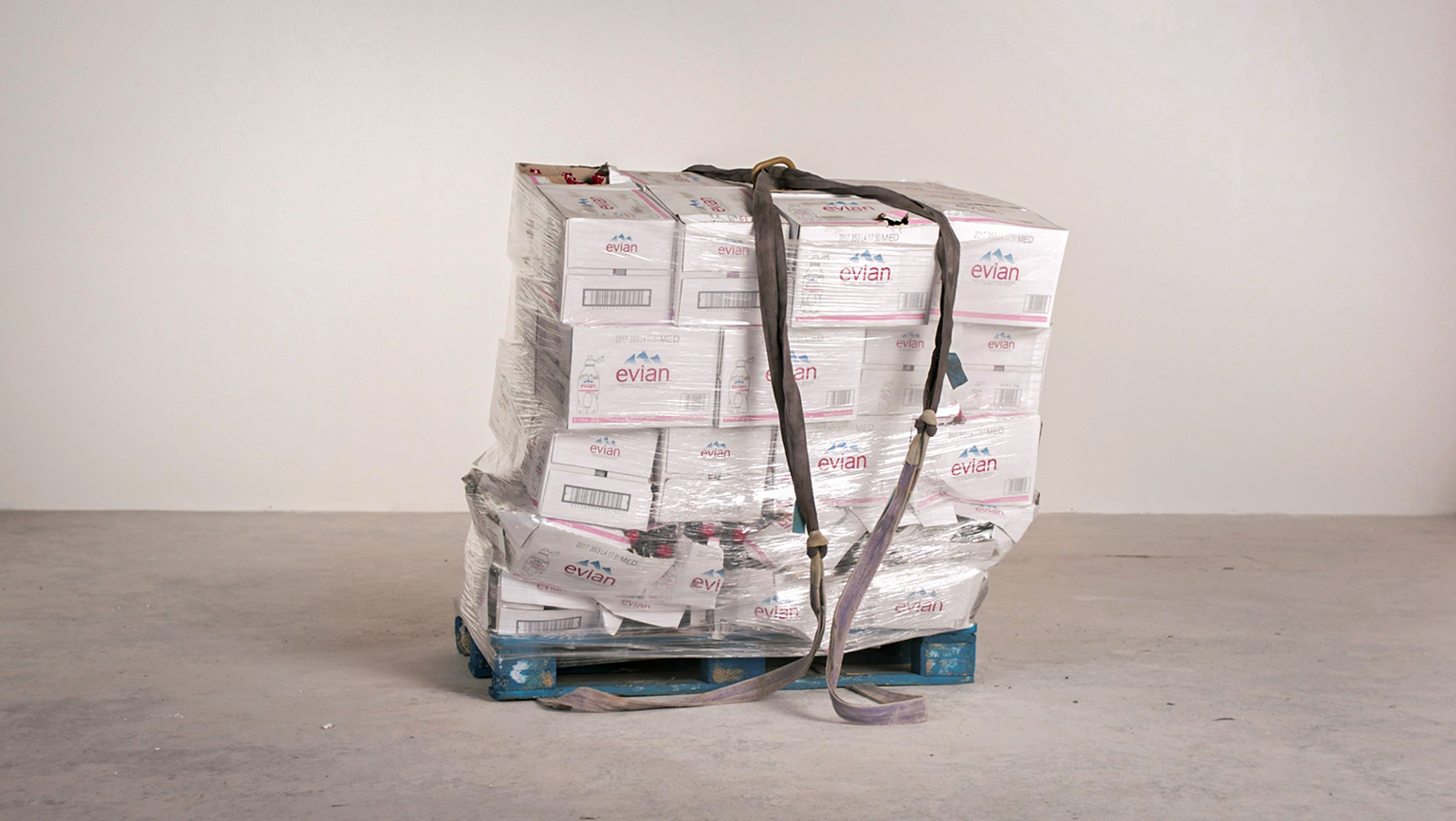 When Water Falls. 2020. Slow motion video, foley designed audio (video-still)
When Water Falls. 2020. Slow motion video, foley designed audio (video-still)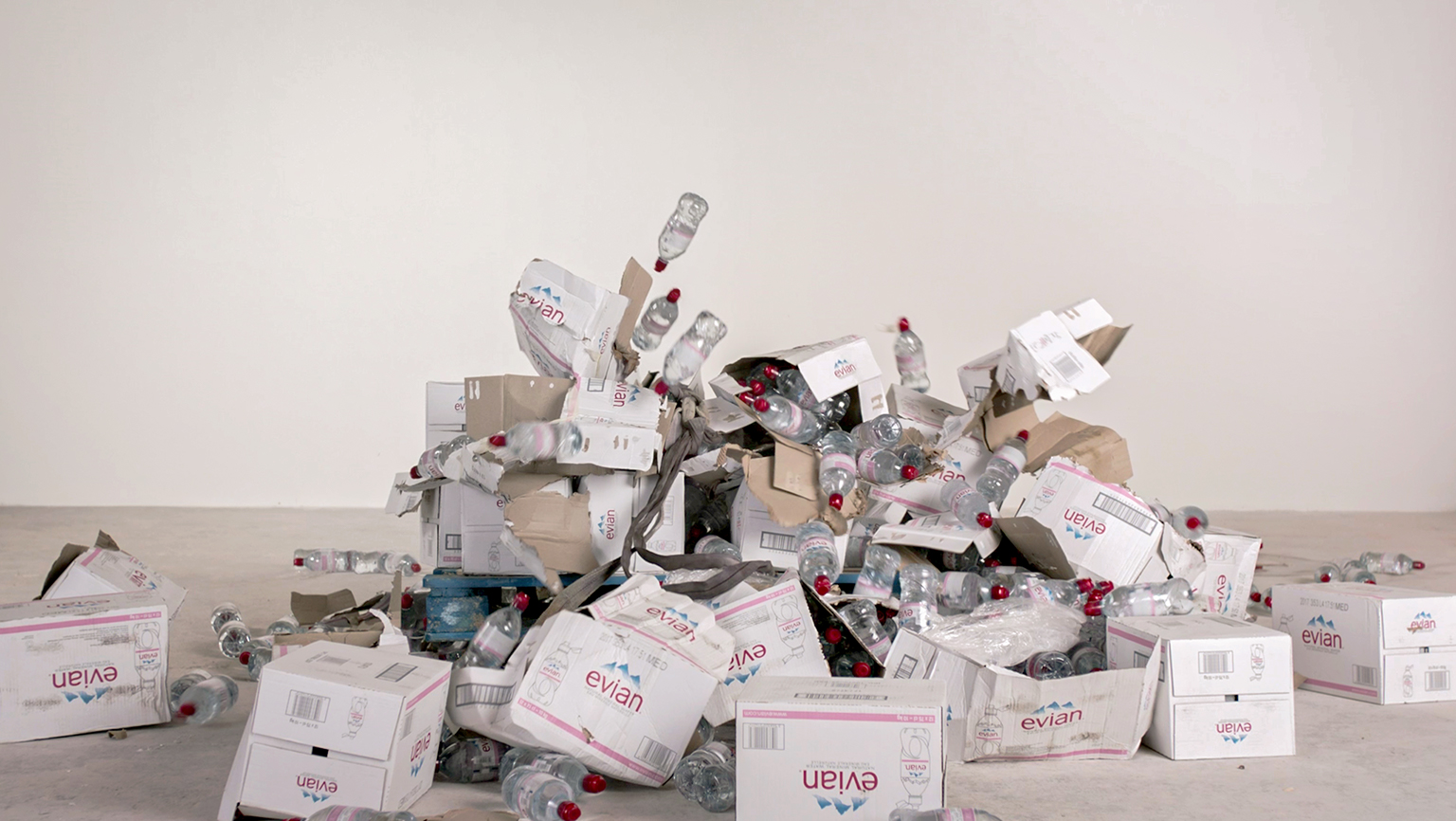 When Water Falls. 2020. Slow motion video, foley designed audio (video-still)
When Water Falls. 2020. Slow motion video, foley designed audio (video-still)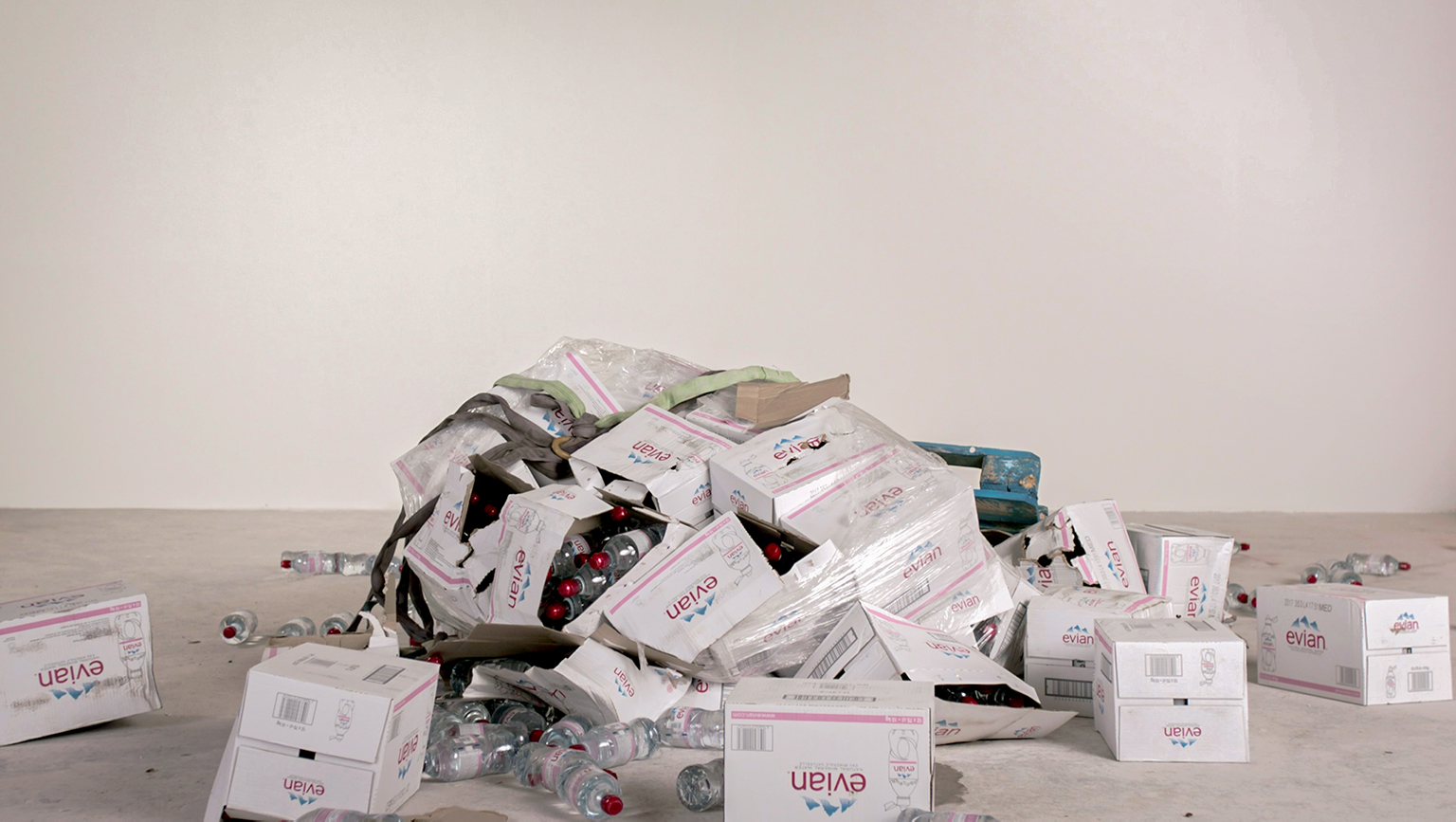 When Water Falls. 2020. Slow motion video, foley designed audio (video-still)
When Water Falls. 2020. Slow motion video, foley designed audio (video-still)Slow motion video, foley-designed audio
2020
Handpainted and patinated bronze, anti-theft box, advertising bundle
Kunstscenen.xyz
2018
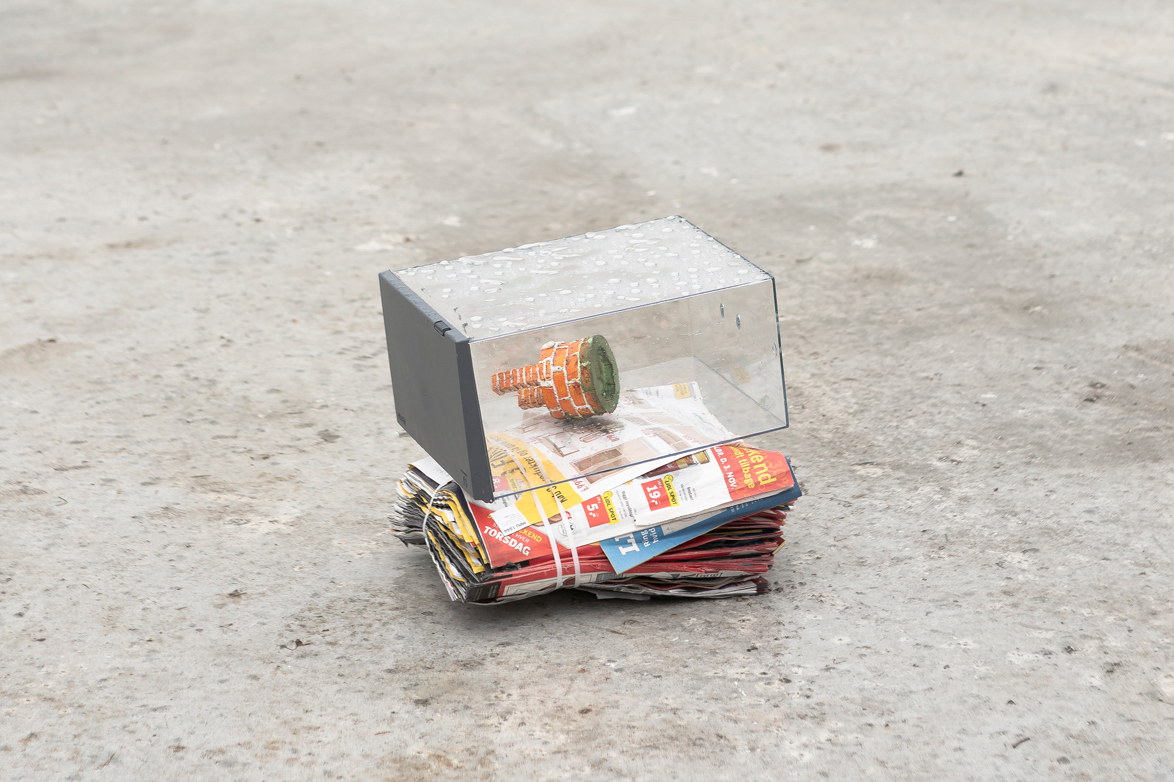 The Leaf. 2018. Handpainted and patinated bronze, anti-theft box,
advertising bundle
The Leaf. 2018. Handpainted and patinated bronze, anti-theft box,
advertising bundle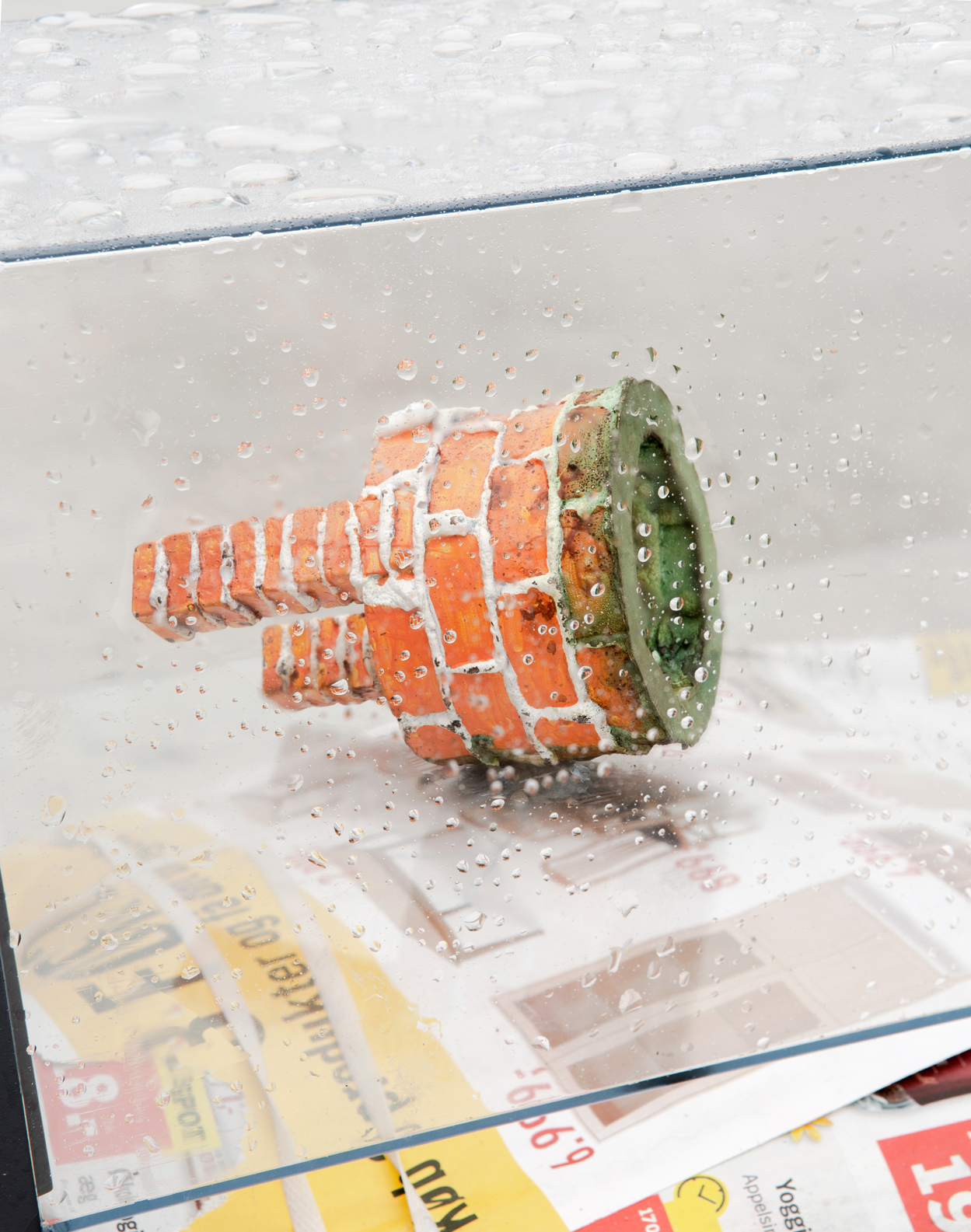 The Leaf. 2018. Handpainted and patinated bronze, anti-theft box, advertising bundle (detail)
The Leaf. 2018. Handpainted and patinated bronze, anti-theft box, advertising bundle (detail)Bronze, acrylic paint, patina fluid, anti-theft box, advertising bundle
Kunstscenen.xyz
2018
180fps slow motion video
2016
Kunsthal Charlottenborg (2016)
Fotografisk Center (2016)
CPH:DOX (2017)
25fps FILM FESTIVAL, Zagreb (2017)
Palic Film Festival, Belgrade (2018)
Zsigmond Vilmos, International Film Festival, Szeged, Hungary (2019)
180fps slow motion video
2016
Kunsthal Charlottenborg (2016)
Fotografisk Center (2016)
CPH:DOX (2017)
25fps FILM FESTIVAL, Zagreb (2017)
Palic Film Festival, Belgrade (2018)
Zsigmond Vilmos, International Film Festival, Szeged, Hungary (2019)
Glovebox, Dublin, Ireland (2022)
Outdoor exhibition space
2018 - 2019
http://kunstscenen.xyz
Kunstscenen.xyz was an outdoor exhibition space created by Magnus Thorø Clausen and Kåre Frang, located on an overgrown plot behind Bispebjerg Station in Copenhagen. Kunstscenen.xyz consisted of a cast concrete floor and two walls, together creating a room. A corner without a ceiling or electric light. The exhibitions in Kunstscenen.xyz were therefore exposed to wind and weather as well as natural light and shadows.
Outdoor exhibition space
12 exhibitions over 12 months
2018 - 2019
http://instagram.com/kunstscenen.xyz
Kunstscenen.xyz was an outdoor exhibition space created by Magnus Thorø Clausen and Kåre Frang, located on an overgrown plot behind Bispebjerg Station in Copenhagen. Kunstscenen.xyz consisted of a cast concrete floor and two walls, together creating a room. A corner without a ceiling or electric light. The exhibitions in Kunstscenen.xyz were therefore exposed to wind and weather as well as natural light and shadows.
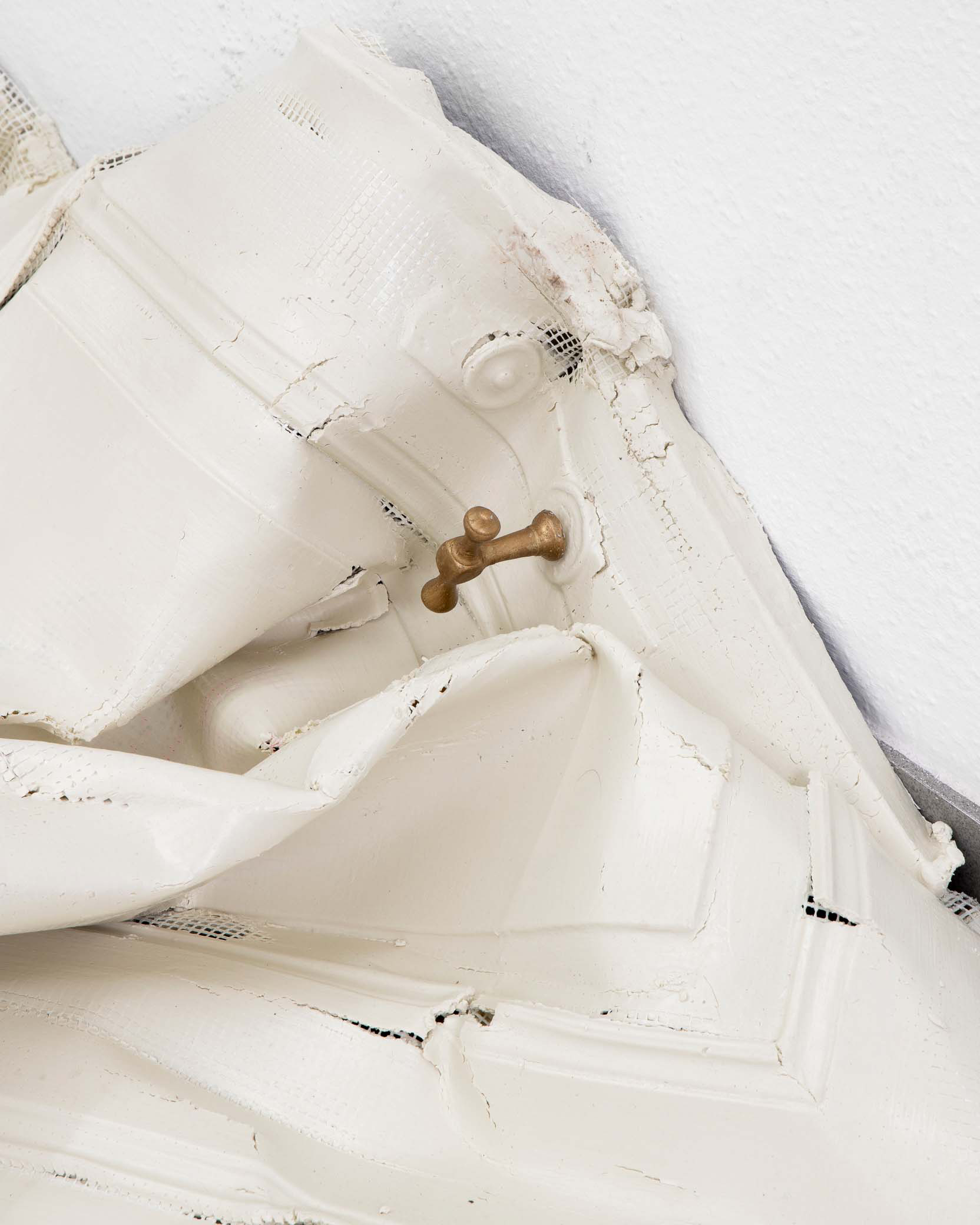
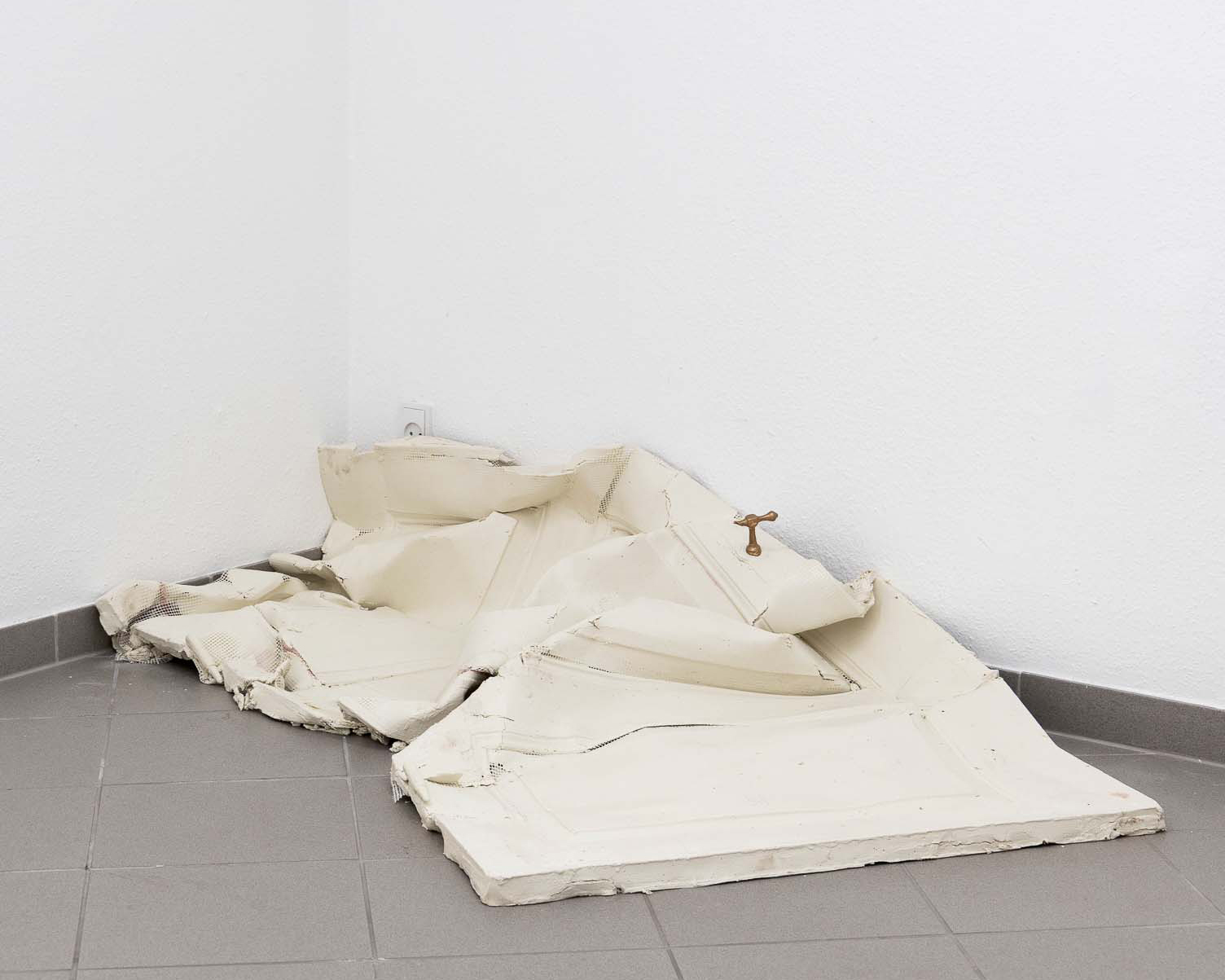
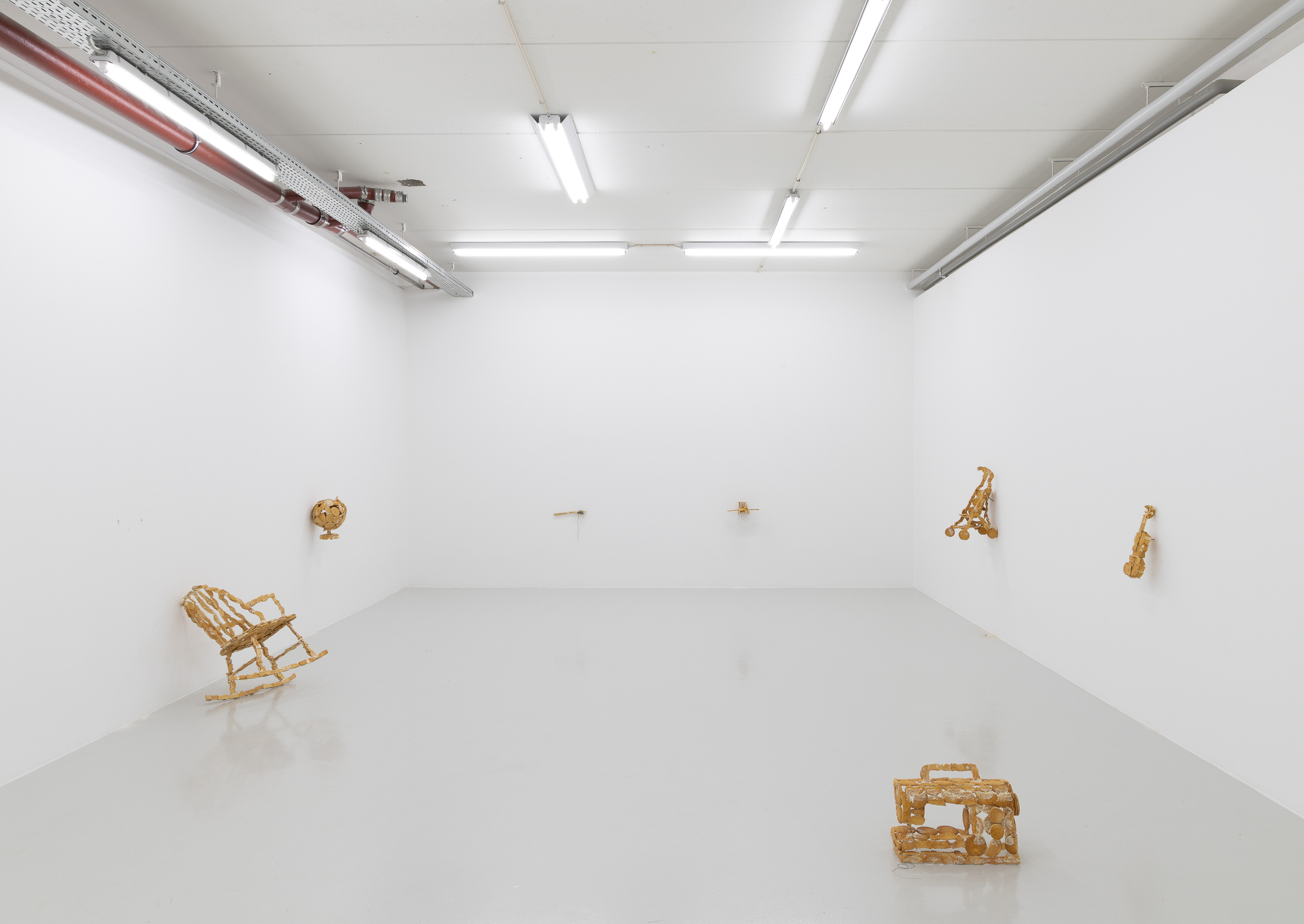
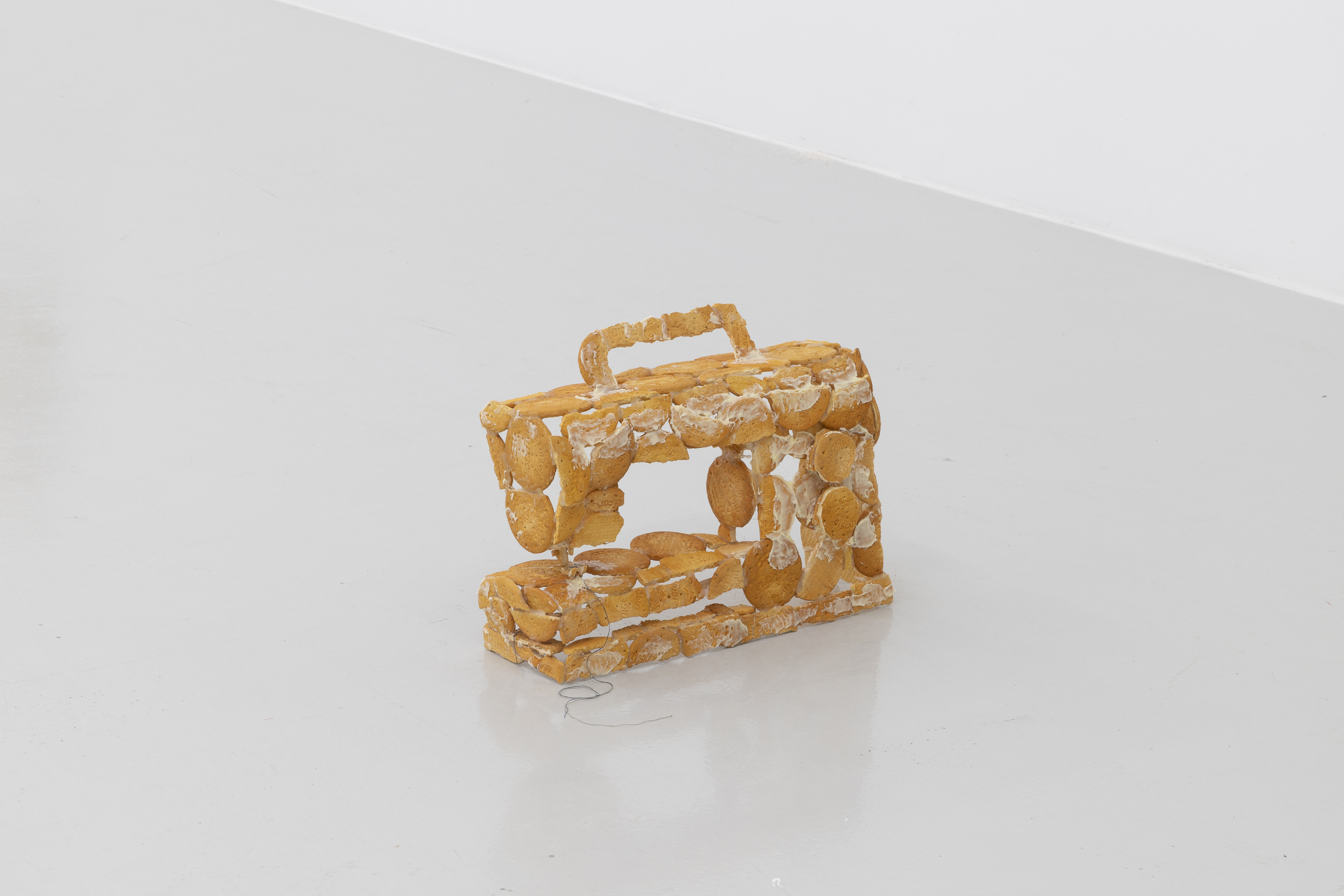

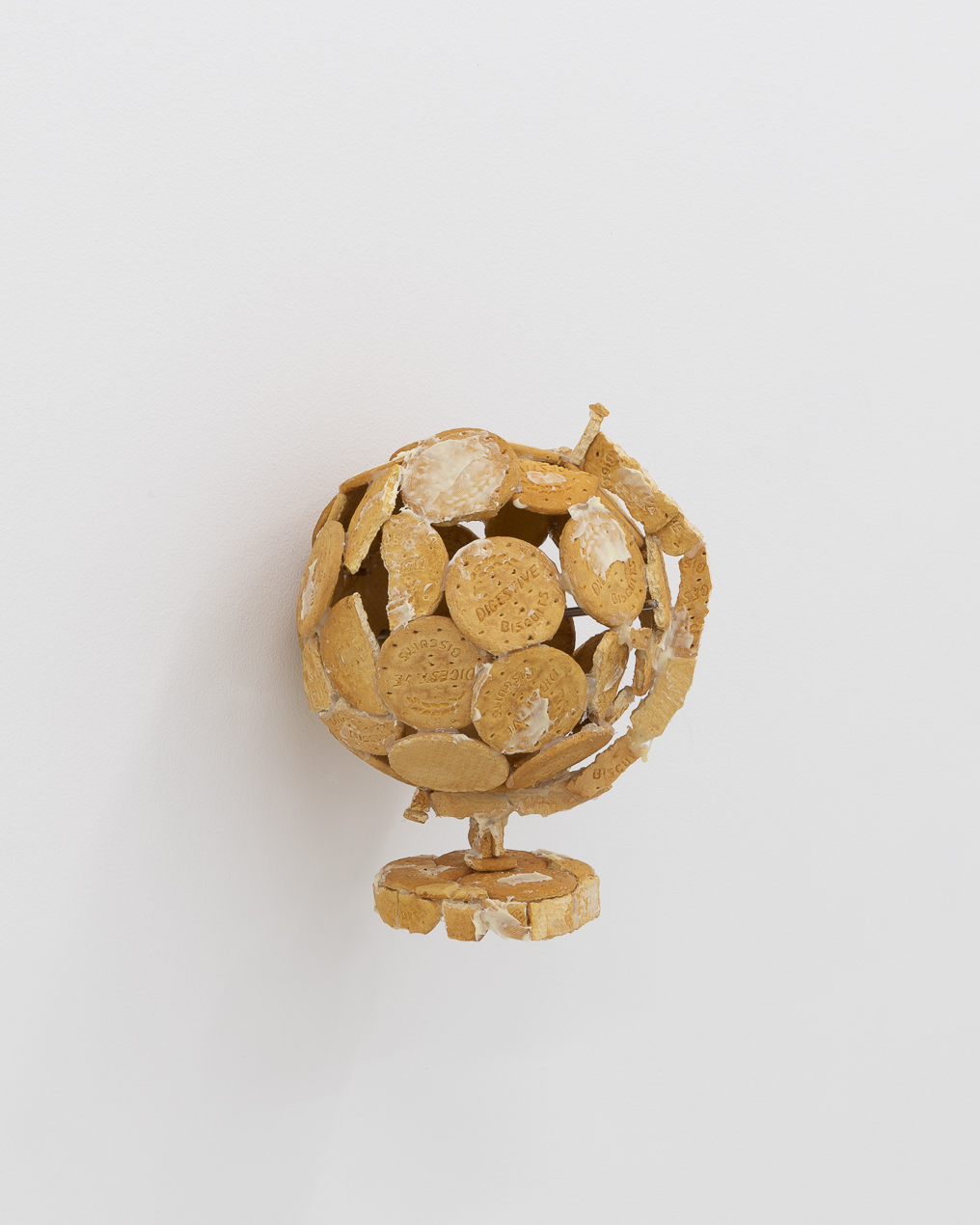
1.jpg)
2.jpg)
3.jpg)
4.jpg)
5.jpg)
6.jpg)
7.jpg)
